





Barney Hampton · A Taste of Heaven Volume 19 · Issue 2 February 2024
Benjamin Marcellin App Ski’s





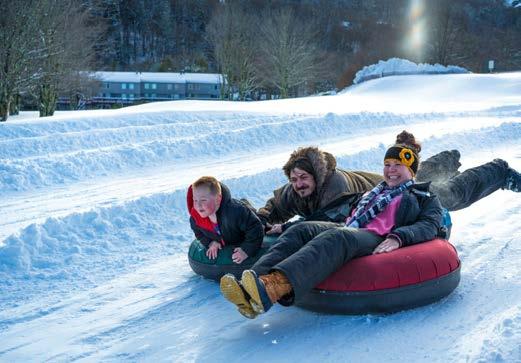

Come play and relax in the Village of Sugar Mountain! See our Winter Fun Guide at: SeeSugar.com/winter Winter Wonderland Winter Wonderland


Making each COMFORTER & PILLOW JUST FOR YOU!



World’s finest downproof fabrics
All-European down fills Meticulous construction











40 Y EARS M A K E RS OFFINEDOWN PRODUCTSFOR THE H O EM ©DEWOOLFSON D OWN INT’L., INC. SIN C E 1 983 © 2006-2023 DEWOOLFSON Down Int’l., Inc.
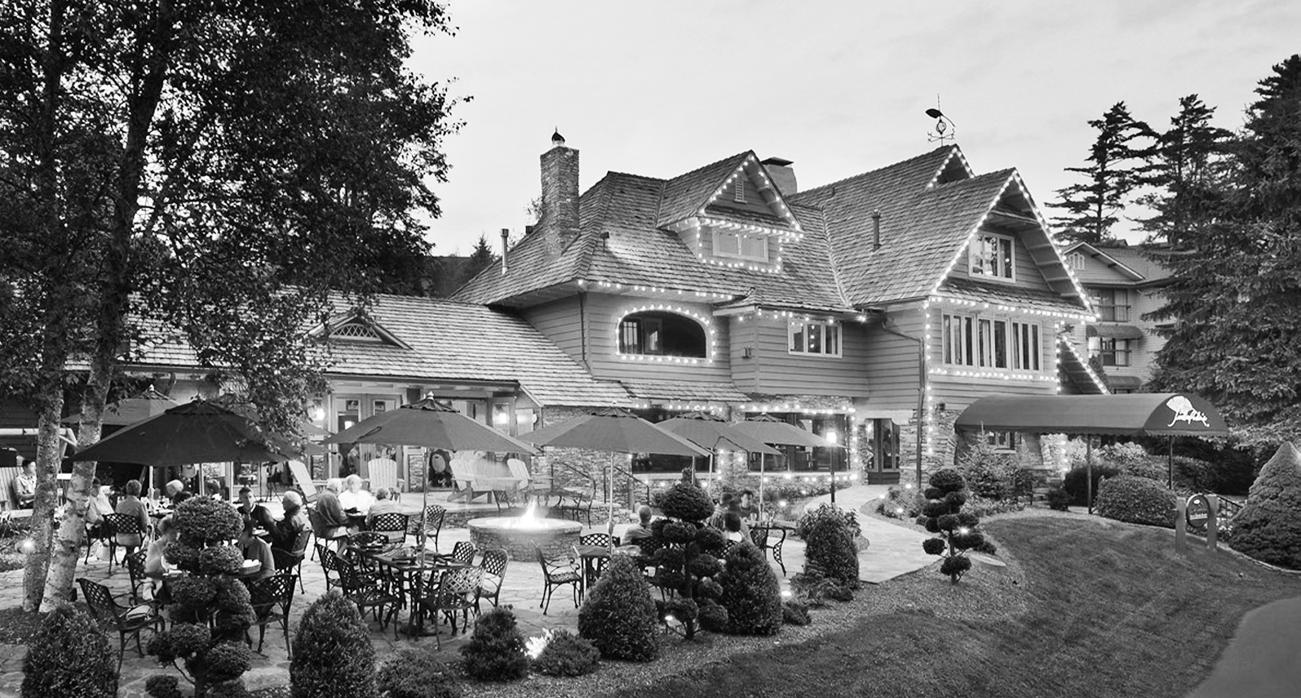



WINNER BEST LODGING RUNNER UP BEST PET FRIENDLY ADVENTURE CHETOLA.COM | 828.295.5500 DISCOVER
Chetola


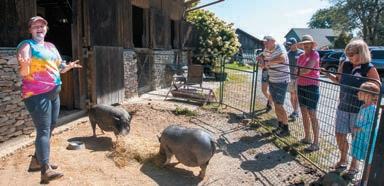






Apple Hill Farm
By Jan Todd
"As we have moved toward urban and suburban living, many people have lost connection with what it is like to live and work on a farm. Agritourism gives us a chance to share our farms and provide an educational experience.” -
Lee Rankin
A Family Tradition
By Layne Hendrickson
“Even the clay, the glaze, we do it all ourselves. Most potters today will buy their clay bagged and ready to throw." -
Playing Pickleball
By Joshua Biggers
Janet Bolick-Calhoun
“The first time I tried pickleball I was absolutely hooked; I’ve played nearly everyday since. I love it and want to do anything and everything I can to spread the game of pickleball.” - Grant
Williams
Putting the 'French' in French-Swiss
By Layne Hendrickson
“We create skiers and snowboarders. And some of them stay with us. Sometimes I’ll take the chairlift with someone who says, ‘I took the P.E. class with ASU back in the ‘80s and you were my ski instructor!”
- Benjamin Marcellin
Spirit Ride
By Jan Todd
“These kids spend a lot of time in formal settings — whether a school classroom or a doctor’s office — receiving therapy, which is important, but not always fun. Out here, the kids are having a good time. ” - Patty
Adams
60 Years of Service
By Sherrie Norris
"I don’t think of retiring. I might slow down when I get old enough, but I’m not ready, yet, even at 84." - Barney Hampton
Toe Valley Soup Ministry
By Tim Gardner
"There’s no greater blessing you can get than by helping others –especially those who are experiencing a hard time or hard times in various ways." - Linda Ollis Taylor
52
44
34
CONTENTS 16 26 62 70
6 HIGH COUNTRY MAGAZINE February 2024
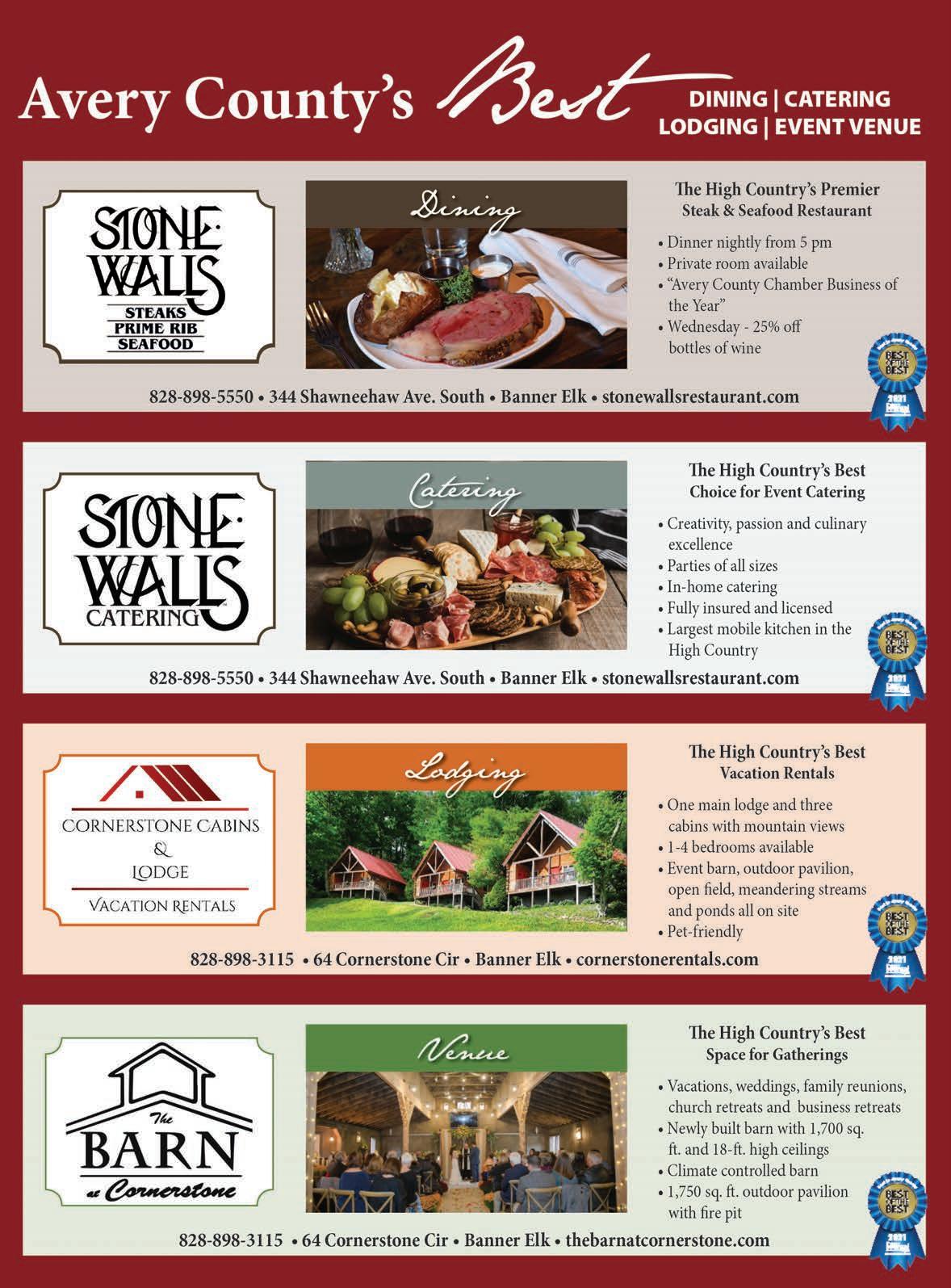
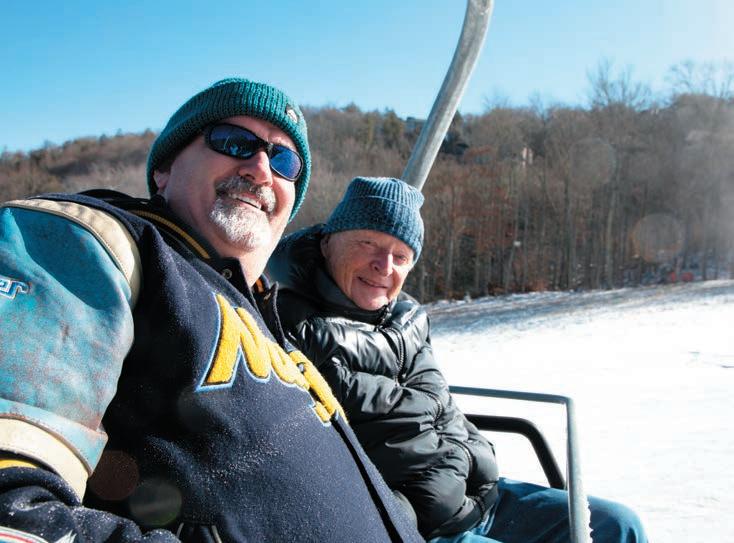
Celebrate winter in the High Country!
In the photo above, Gunter Jochi and I ventured to the top of Sugar Mountain Resort to take in the view as snow production blanketed the slopes below with fresh powder. We discussed the longstanding importance of the area’s ski scene, in which he and his wife, Kim Jochi, have played key roles for decades. These local, mountaintop meccas contribute to a sense of community and provide an economic boost during a time when many towns go into full hibernation.
The ski mountains are breathing a sigh of relief after experiencing relatively mild weather to start the season. Winter finally kicked into high gear with cold temperatures and precipitation that provided ample opportunities for wintry fun. If you enjoy downhill skiing, snowboarding, tubing, ice skating, cross-country skiing, sledding, snowshoeing, teaching your kids or grandkids how to build a snowman, making snow cream, or simply sipping a beverage by the fireplace as you watch the snowflakes drift to the ground, this is your chance to live it up!
The winter season is also a great time to enjoy some comfort food at your favorite restaurant or a new eatery you have been wanting to try. The High Country offers an impressive array of culinary delights, from sweet to savory and everything between. And, with a strategically fabricated “holiday” this month, be sure to make your reservation soon! Whether you have a designated sweetheart or are your own Valentine, the businesses you see on the pages of this magazine offer plenty of gifts that can help you show some love.
Speaking of that thing called love, as always, this issue celebrates some of the unique people and places that make the High Country special. Jan Todd takes us on a tour of Apple Hill Farm and highlights its mission to help people embrace farming. She also gives a behind-the-scenes look at the inspiring opportunities offered by the Spirit Ride organization.
If you have wondered why pickleball seems to be such a big deal, Joshua Biggers serves up an overview of the trendy activity. Sherrie Norris honors Barney Hampton’s decades of service to the High Country community and Tim Gardner introduces us to the Toe Valley Soup Kitchen and its valuable impact for those in need. Layne Hendrickson shares an inside look at Traditions Pottery and shines a spotlight on Benjamin Marcellin, director of the French-Swiss Ski College at Appalachian Ski Mountain.
We invite you to curl up in a cozy spot after your day of High Country winter adventures and peruse this edition. Here’s to hoping for more snow throughout February … Enjoy the rest of winter and thank you for choosing High Country Magazine!
 Sam Garrett - Publisher
Sam Garrett - Publisher

A Public Ation o f
High Country Press Publications
Publisher /editor
Sam Garrett design
Ashley Poore
Advertising d irector
Michelle Harrell
contributing Writers
Joshua Biggers
Tim Gardner
Layne Hendrickson
Sherrie Norris
Jan Todd
cover Photogr APher
Layne Hendrickson
contributing Photogr APhers
Josh Floyd (Astro Yeti Photo Co.)
High Country Magazine is produced by the staff and contributors of High Country Press Publications, which serves Watauga, Avery and Ashe counties of North Carolina.
HIGH COUNTRY MAGAZINE
P.O. Box 152, Boone, NC 28607 828-264-2262
Copyright © 2024, All rights reserved
ON THE COVER:
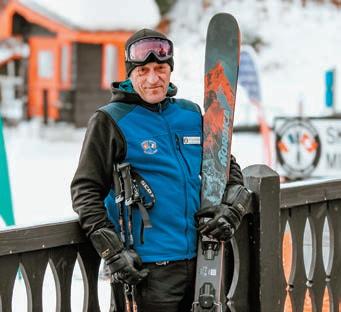
French born Benjamin Marcellin first came to Appalachian Ski Mountain in 1979 and now serves as Director of the French-Swiss Ski College. Photo by Layne Hendrickson.
Sam Garrett and Gunter Jochi ride the chairlift to the top of Sugar Mountain.
FROM THE PUBLISHER
8 HIGH COUNTRY MAGAZINE February 2024









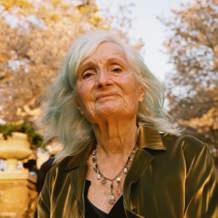












BOX OFFICE OPEN TUE.-FRI. 11 A.M. - 3 P.M. & TWO HOURS PRIOR TO SHOWTIME 828.865.3000 24/7 ONLINE BOX OFFICE TICKETS, VENUE & SHOW INFORMATION APPTHEATRE.ORG @AppTheatre FREE GUIDED TOUR 1 .P.M. 23 7:30 P.M. 2 P.M. 7:30 P.M.
EVENTS MON TUE WED THU FRI SAT SUN 1 45 6 7 23 8 9 10 11 12 13 14 15 16 17 18 19 20 21 22 24 25 26 27 28 7:30 P.M. 7:30 P.M. 2 P.M. 7:30 P.M. 29 LAUREN HAYWORTH & FRIENDS Alice Gerrard & Friends HANDLEBAR BETTY & BLUE RIDGE GIRLS GANGSTAGRASS 7 P.M. 7 P.M. 7 P.M. 7 P.M. 23 8 P.M.
FEBRUARY
mountain echoes
AMOREM Welcomes Director of Faith Outreach
COURTESY OF AMOREM
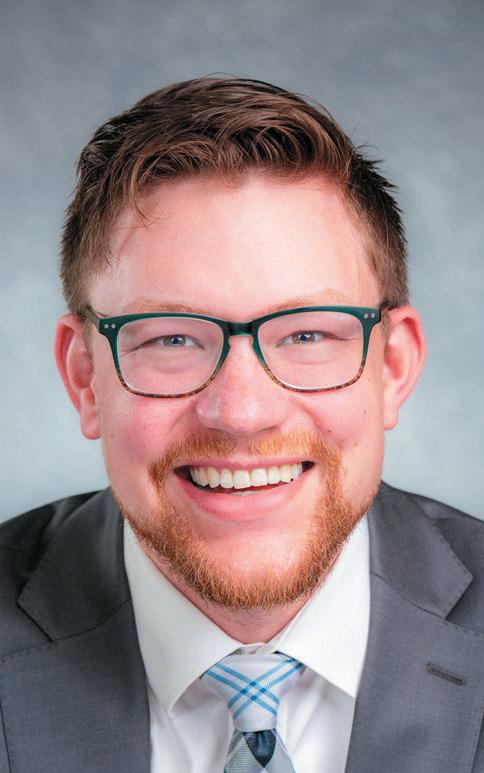
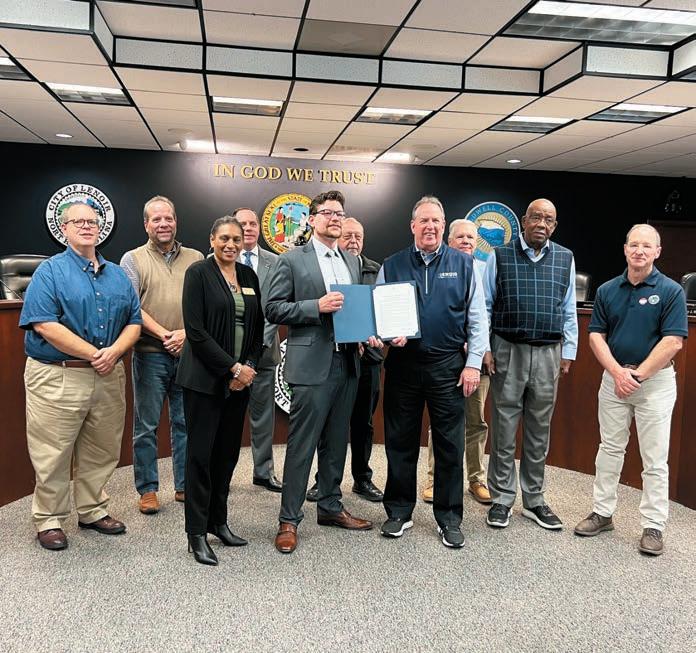
William Williamson has stepped up to the role of Director of Faith Outreach forAMOREM, formerly Burke Hospice and Palliative Care and Caldwell Hospice and Palliative Care.
After the legacy hospice organizations integrated in 2021, it was quickly identified that the organization needed an individual who focused all of their efforts on supporting the robust faith community, said Vice President of Community Engagement Kerri McFalls.
“A director of faith outreach is not a common position in the hospice industry,” McFalls said. “But AMOREM wants to ensure its faith communities that they are a priority for the organization and that they feel supported when any of their congregants need end-of-life care.”
In his role at AMOREM, Williamson will act as a liaison between the organization and all faith communities in AMOREM’s 12-county service area. He will provide ongoing education and support to those who perform religious duties, be a contact for referrals from the faith community and provide spiritual support to patients and families.
“This position is an excellent opportunity to show how much we at AMOREM deeply appreciate the support that people of faith provide us,” said Williamson. “Ultimately like congregations in the area, we are a mission-focused, locally based nonprofit.
AMOREM is driven by its mission and values, not by money or profit.”
Previously, Williamson served as AMOREM’s chaplain team lead, supervising spiritual care providers as they spent time with patients at the end of life. Williamson has worked in the hospice industry for more than six years.
“I’m excited to give back to the faith community that has given us volunteers, monetary gifts and even the use of their sanctuaries,” Williamson said. “Through providing education, serving as a link between the medical community and the faith community, and a resource to local clergy, I hope I can help congregations with their missions as they have helped us with ours.”
Williamson received a double major in psychology and religion at Centre College in Kentucky. He then received his Master of Divinity from Harvard. Additionally, he has a master’s degree in patient counseling from Virginia Commonwealth University.
“AMOREM, and the communities it serves, is so fortunate to have William,” McFalls said. “His mission-driven approach to his role and respect for diversity and religious knowledge will prove to be a major asset to those he collaborates with.”
For more than 40 years, AMOREM has proudly served as your local, non-profit hospice provider. To learn more about AMOREM services and opportunities, visit www.amoremsupport.org. t
10 HIGH COUNTRY MAGAZINE February 2024
William Williamson. Photo courtesy of AMOREM. In November of 2023, the City of Lenoir recognized AMOREM during National Hospice and Palliative Care Month. Williamson recieved the proclamation for AMOREM. Photo courtesy of AMOREM.


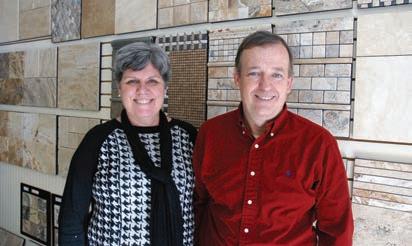
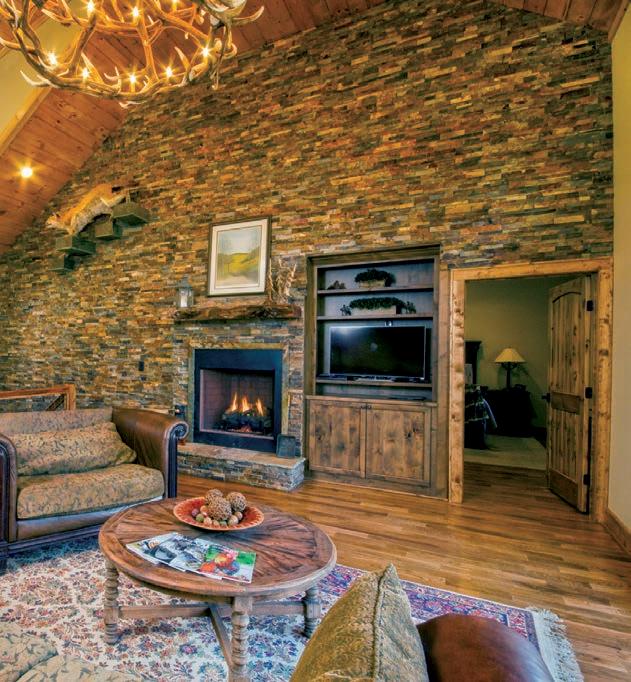


Boone’s Premier Tile Showroom 1852 Hwy. 105, Boone • 828-265-0472 • www.MountainTileNC.com ST ore Hour S: Monday - Friday: 8:30am to 5pm Saturday: By Appointment Owners Trudy and David Shell Over 30 Years of Flooring Experience!
mountain echoes
Children’s Council Receives $35,000 Grant from Truist Foundation to Invest in Early Childhood Workforce
COURTESY OF CHILDREN’S COUNCIL OF WATAUGA COUNTY, INC.
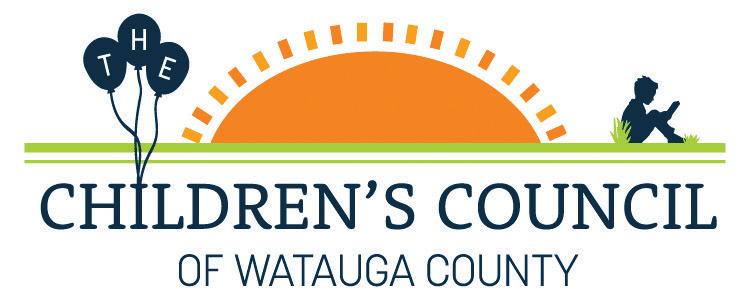
Truist Foundation has awarded a grant for $35,000 to the Children’s Council of Watauga County, Inc. The grant aligns with the Foundation’s mission to build career pathways to economic mobility by investing in local early childhood educators.
“At Truist, we believe that we succeed when we give our communities the opportunity to do the same,” says Jonathan Lubkemann, Market President for Watauga, Avery, Alleghany, and Wilkes County of North Carolina for Truist. “We understand that children are the future of our communities and ensuring they have consistent, high-quality child care and education is just one way that we live out our purpose of inspiring and building better lives and communities.”
As the “workforce behind the workforce,” the child care industry has a multi-generational economic impact allowing parents to work today and by providing quality care that helps the future workforce grow ready for school and for life. The industry’s low wages can result in a lower-skilled, high-turnover workforce. High turnover of caregivers is not good for children.
Decades of research shows that high-quality child care helps promote the school readiness of children, particularly for lowincome children. However, providing high-quality child care depends on developing a high-quality early learning workforce. Nobel Laureate in economics, Professor James Heckman estimates that for every dollar spent on high quality, birth-tofive programs for disadvantaged children, there is a 13% per year return on investment. Child Care in general is not a profitable industry since business models depend on parent fees (tuition) and child care directors are reluctant to raise their fees knowing most families cannot afford them. The Children’s Council offers the Pathways to Accreditation Quality Enhancement program as an alternative compensation strategy that links professional development and educational attainment with increased wages. Funding to support the program comes from blending public (Smart Start funds), local (Watauga County) and private funds raised by the organization.
“Funds from Truist Foundation will be used to help support
the Pathways to Accreditation Quality Enhancement program,” says Elisha Childers, Executive Director of the Children’s Council.
Child Care is recognized as one of the county’s top two economic development priorities for Watauga County by the Watauga County Economic Development Commission. In North Carolina, the Child Care industry had a $3.15 billion economic impact in 2016 with total earnings of $1.25 billion and a jobs impact of nearly 65,000 jobs. In Watauga County, there are 36 licensed child care programs that employ 163 people and serve over 900 children (birth – school aged) so parents can work, and there is currently a waiting list of about 300 children for licensed child care.
“The child care industry has not fully rebounded from the COVID-19 pandemic and many local providers are unable to enroll the number of children they are licensed to serve because they have not been able to attract and retain the workforce needed to do so,” says Childers. “This impacts their business and the livelihoods of their employees, as well as the livelihoods of the working families they serve.”
The Children’s Council provides programs and services that help child care owners and directors provide high quality services to young children. The biggest driver of quality child care is the teacher’s knowledge and skill in the classroom. The Pathways to Accreditation Quality Enhancement program is focused on improving quality of care through advancing teacher education and skill level. This is done by supporting teachers in earning their associate degree in early childhood while providing professional development training and on the job mentoring and coaching. In turn, participating child care centers also receive a quality enhancement payment each month in order to pay these teachers a minimum of $12/hour (which is the state average). When we launched our program in 2018, the average wage of a lead teacher in Watauga County was only $9.50/hour. Participation in this program helps child care center owners and directors attract and retain qualified employees in lead teacher positions through higher wages and educational support. t
12 HIGH COUNTRY MAGAZINE February 2024

Carolina Gal
By Jan Todd

Tastes like Chicken
Like most Southerners, I grew up eating a lot of chicken. On Sundays, it would be baked chicken, left in the oven to roast while we were at church. During the week, my mama would cut up a chicken into pieces and fry it, serving alongside rice and gravy, green beans and perhaps some home-grown tomatoes.
As a teenager, fried chicken was one of the first dishes I learned to cook. I mastered it pretty quickly, but the gravy took more time. After frying the chicken, you pour out most of the grease, add in a tablespoon or so of flour, stir it constantly until it browns. Then, you slowly add in a mixture of milk and water, stirring it vigorously and praying for the best. If things go a little sideways, you end up with a messy lump resembling mashed potatoes. But if it turns our right? Honey, that is some good eatin’!
My love of fried chicken opened my mind to other Southern delights. I’ll never forget visiting a college boyfriend who lived way out in the country. I stepped into the kitchen to find his mother frying up a batch of frog legs — harvested during a frog giggin’ episode prior to my arrival.
I didn’t realize frog giggin’ was a real thing up to that point. I always thought it was something like snipe hunting or
cow tipping — which was basically a fella inviting you out in the dark to give him some sugar.
Anyhow, frog giggin’ IS a real thing, and I’m here to tell you frog legs taste like chicken, with a hint of fishiness. If you’re like me, it is highly unlikely you’ll go out and gig your own frogs, but frog legs can occasionally be found on the menu at a backroads fish camp or at a fancy French restaurant (labeled as “cuisses de grenouilles”). Vastly different presentations, of course.
While I’ve never tasted it myself, my mama often had squirrel on her dinner table when she was a young girl. At Thanksgiving, her grandmother mixed it in with the holiday turkey, just to stretch the dish a bit to serve a big crowd. It tasted similar to the bird’s dark meat, mama said.
Seems like several dishes pose as yard bird. My husband, Tony, is from Yadkinville — where folks hunt, fish and possibly indulge in moonshine. So, many years ago, when we were invited to a Super Bowl party hosted at an unheated mechanical shop located a few miles down a dirt road, you can understand why I was a little skeered.
“Will there be other wives and girlfriends there?” I asked my husband.
“Sure!” he replied.
There were not.
I was the only female in the crowd, with the rest of the significant others having the good sense to stay at home in their heated living rooms with their chip and dip. As for me, I found myself amongst men in overalls, pitching quarters and playing poker and drinking some suspicious clear liquid from mason jars.
I was greatly comforted, however, to spot a large cauldron of chicken stew. I helped myself to a steaming bowl, then went back for seconds. About that time, a fella came up and smirked, “Do you know what you’re eating?”
“Chicken stew!” I replied enthusiastically.
“Nope,” he said. “It’s turtle.”
When he saw the concerned look on my face, he said reassuringly, “Don’t worry, though. It ain’t pond turtle. It’s river turtle.” Like that made a difference.
I thought about getting a little squeamish, but bottom line, it pretty much tasted like chicken. So for me, I think I’ll leave the giggin’, shootin’ and turtle catchin’ to others and just stick to the poultry section of the grocery store. t
A steaming bowl of chicken stew … or is it? Stock photo.
14 HIGH COUNTRY MAGAZINE February 2024





9,000 Square Feet of Furniture from Traditional to Eclectic Huge Selection Lamps, Chandeliers, Mirrors & Wall Art Large Selection of Stone Top Bathroom Vanities Fabulous Furniture at Fantastic Prices 7531 Valley Blvd, BLOWING ROCK | Located in the Food Lion Shopping Center Visit BRASS EXCHANGE HOME located in Charlotte at the Arboretum Shopping Center & Home Décor Open Mon . - Sat . 10:00-5:00 | 828.295.960 0 Windwood Home
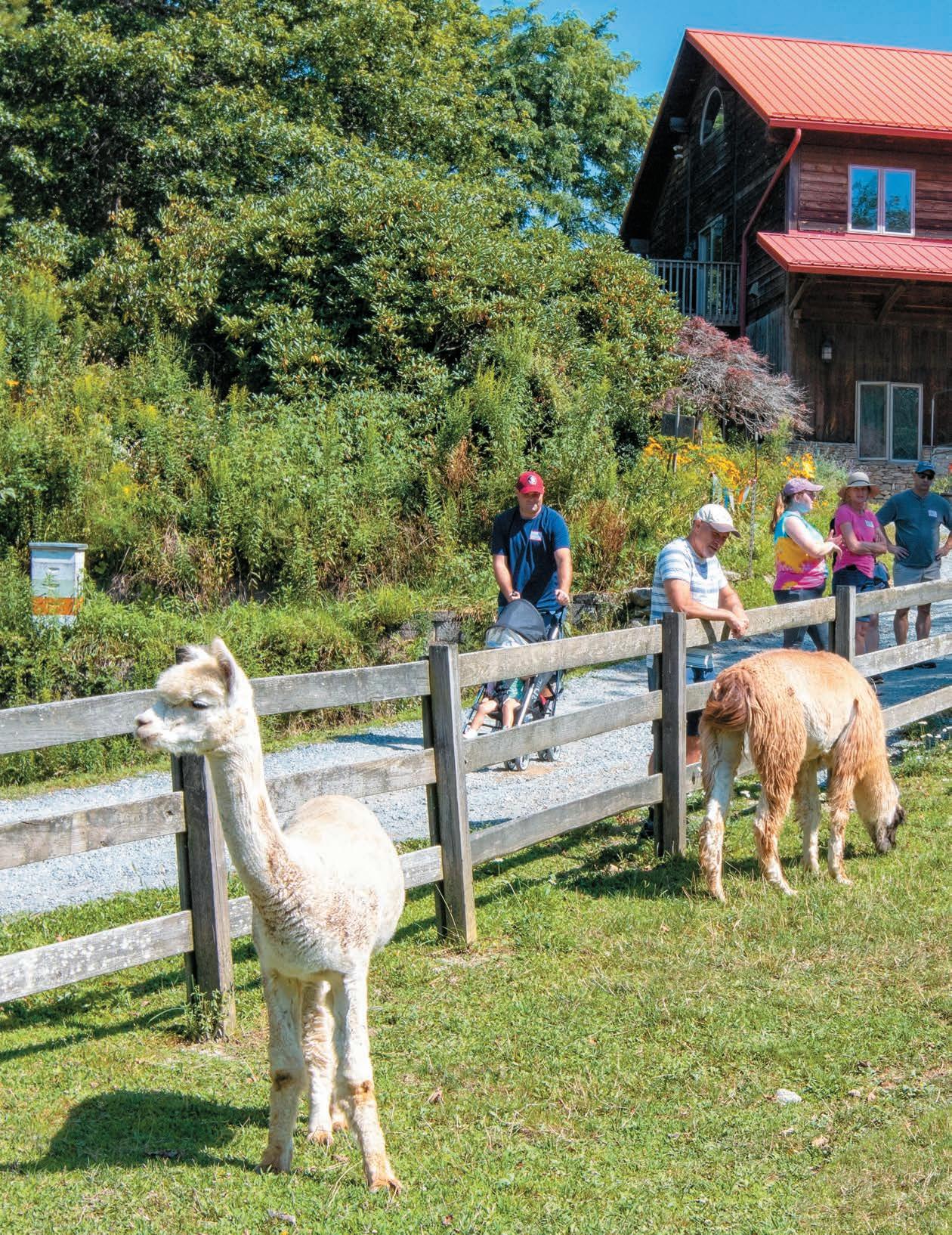
16 HIGH COUNTRY MAGAZINE February 2024
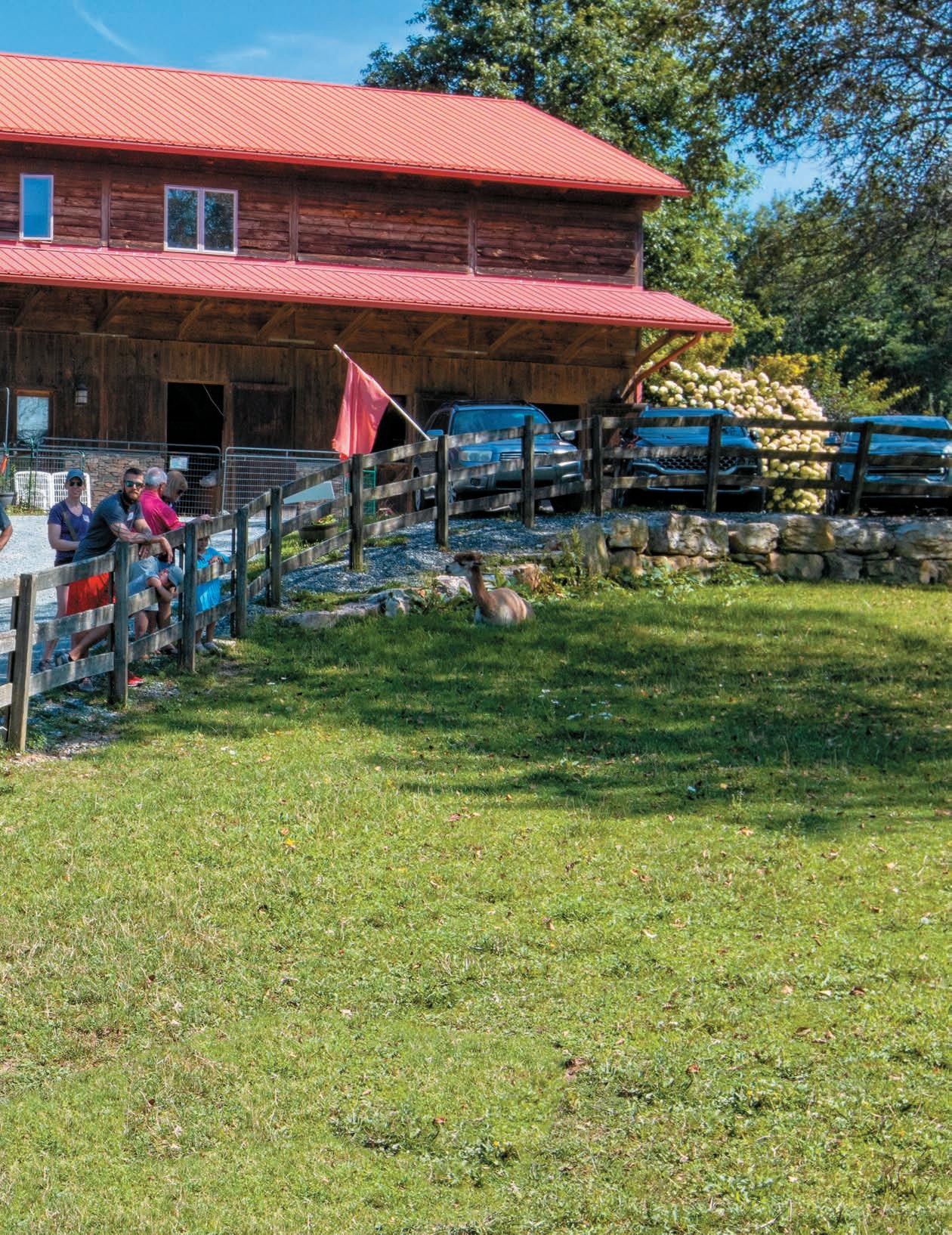
A Crop of Smiles
Apple Hill Farm Embraces Agritourism
STORY BY JAN TODD
February 2024 HIGH COUNTRY MAGAZINE 17
Some farms yield soybeans. Others raise chickens, cows or pigs to put meat on our tables. And some farms produce . . . experiences.
Somewhere along the way, the agriculture industry discovered the community benefits and profit potential of inviting the public to experience a slice of life on the farm.
The concept of combining tourism and agriculture may have been born of necessity. During the Great Depression, produce prices were so low for some crops that it wasn’t profitable for the farmers to hire workers to harvest the food — so they invited the public to “pick your own.”
Plucking cherries or apples from a tree became a form of family entertainment, a chance to visit the country and enjoy the great outdoors.
More recently, during the Covid pandemic, travel restrictions drove people to find outdoor entertainment close to home.
Lee Rankin, founder and owner of Apple Hill Farm in Banner Elk, serves as president of the North Carolina Agritourism Networking Association, a 200+ member organization set up to support, engage, educate and provide resources to grow the agritourism industry in the state.
Apple Hill Farm, located off of Highway 194 between Valle Crucis and Banner Elk, covers 43 acres of land and is home to alpacas, llamas, potbelly pigs, angora goats, chickens, donkeys,



18 HIGH COUNTRY MAGAZINE February 2024
(Bottom) Apple Hill Farm has a 2-story barn with stalls for the animals, office space and a store upstairs where visitors may purchase alpaca yarn, clothing items made from alpaca fleece, gifts and souvenirs. Photo by Jan Todd.
a few zebu cattle and horses, several livestock guardian dogs and farm cats.
More than 12,000 people visit the farm in a typical year — some to take a 45-60 minute farm tour, some to shop at the farm store, some to attend specialty workshops or events such as barn quilt painting classes, yoga sessions with baby goats, animal photography workshops or a front row view of angora goat shearing.
Thousands more encounter Lee and her “mobile farm” at the annual Banner Elk 4th of July Celebration and local festivals and fairs.
Agritourism fuels much of the success of Apple Hill Farm, enabling Lee to employ approximately ten full and parttime associates, plus partner with artists and service providers to bring unique and educational experiences to the farm.
“Plan B”
The thought of farm tours and workshops never entered Lee’s mind when she started her venture with Apple Hill Farm a little more than 20 years ago. All she wanted was a small farm where she could raise alpacas to breed, show and sell — while providing a stable and loving home for her young son, Will.
She found the perfect property in Banner Elk, a mountain top farm that had once been home to thriving apple orchards, with space for pastures and a few outbuildings already in place. She and her son settled in, cleared some land and purchased some chickens and five alpacas.
During her second year on the farm, tragedy struck. After running errands one morning, Lee came home to find the aftermath of a mountain lion attack. Ultimately, only one of her five alpacas survived.
Had she lost the entire herd, Lee said she wasn’t sure she would have continued her venture — it was too heartbreaking. “But there was Mojo,” said Lee, speaking of her remaining alpaca.
“Alpacas are herd animals, so I immediately bought another to keep Mojo company,” Lee said.
She sent to two alpacas to stay with another breeder until she was sure she had them protected from predators. She consulted with ranchers in the Western United States on techniques to keep her animals safe.
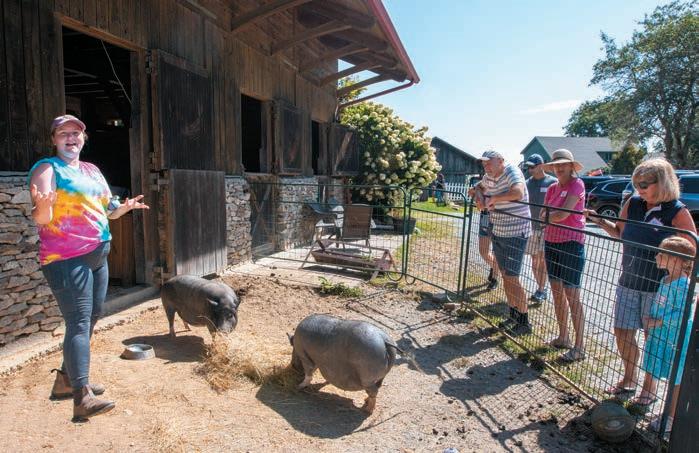
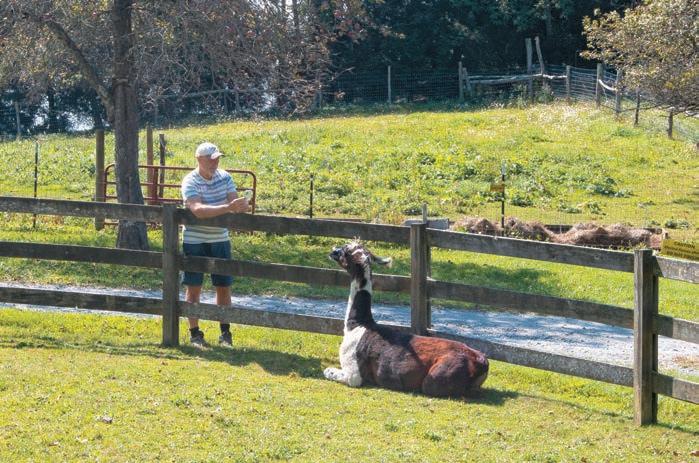
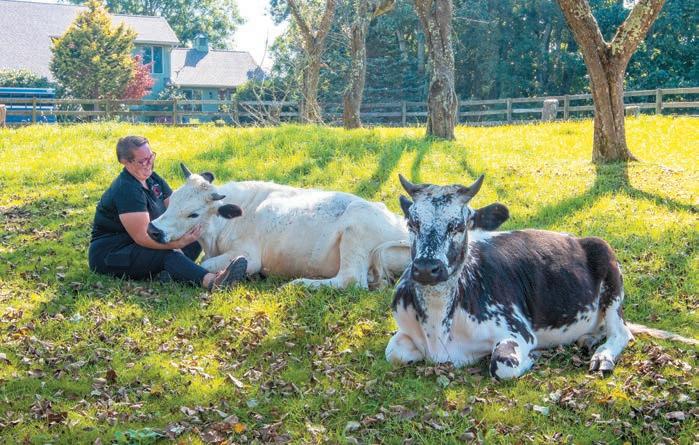 Brianne Harris, farm manager at Apple Hill Farm, cuddles with a Randall Lineback cow — a breed listed as “critical” on The Livestock Conservancy — in the pasture at Apple Hill Farm. Photo by Jan Todd.
A guest snaps a closeup of a llama during a tour at Apple Hill Farm. Photo by Jan Todd.
Brianne Harris, farm manager at Apple Hill Farm, cuddles with a Randall Lineback cow — a breed listed as “critical” on The Livestock Conservancy — in the pasture at Apple Hill Farm. Photo by Jan Todd.
A guest snaps a closeup of a llama during a tour at Apple Hill Farm. Photo by Jan Todd.
February 2024 HIGH COUNTRY MAGAZINE 19
Abby (left) leads a tour of Apple Hill Farm, introducing the guests to Laverne and Shirley — potbelly pigs who live at the farm. Photo by Jan Todd.

Gradually we opened up more days in the summer, then started opening in other seasons. Now we’re open 7 days a week from May through October, and 3-4 days a week during the winter, depending on the weather and the demand.
- LEE RANKIN
Lee added a couple of donkeys to an outer corral surrounding the alpacas’ pasture. Donkeys are naturally very territorial and will kick and bray at any predator that might breach their perimeter. She also added a couple of llamas to share the pasture with the alpacas. Llamas are larger and serve as additional protection for the herd. Trained Great Pyrenees dogs — bred as guardian animals — also keep watch over the farm.
Once her farm was back intact, Lee encountered another surprise.
“Mountain lions are very rare in our area, some even say they’re extinct,” Lee explained. “When word got our about our attack, people started stopping by the farm just to see where it happened.”
Lee said she would stop and talk with her unplanned visitors, often spending 30 minutes or an hour showing them around and sharing her story. Then, to streamline the farm visits, she started offering organized tours every Saturday.
 Left: A young guest gets a chance to show some love to the donkeys that protect the alpacas from predators. Photo by Jan Todd.
Left: A young guest gets a chance to show some love to the donkeys that protect the alpacas from predators. Photo by Jan Todd.
20 HIGH COUNTRY MAGAZINE February 2024
An educational display allows farm visitors to touch and feel alpaca and mohair goat fibers in various stages of production, while learning interesting facts about the animals. Photo by Jan Todd.
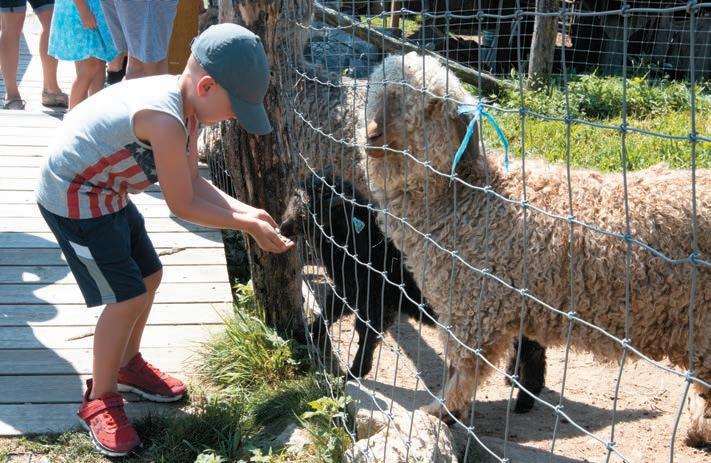
“But then people would call and say they couldn’t make it on Saturday, and would it be okay to come on Tuesday?” she laughed. “We weren’t even charging for tours back then, but if I needed to have extra staff here and rearrange schedules, it made sense to charge for a private tour.”
As interest in tours grew and Lee staffed up to accommodate, tour revenue became a welcome income stream for the
farm. She added a gift shop where people could purchase alpaca yarn and fiber products.
“Gradually we opened up more days in the summer, then started opening in other seasons. Now we’re open 7 days a week from May through October, and 3-4 days a week during the winter, depending on the weather and the demand,” she said.


February 2024 HIGH COUNTRY MAGAZINE 21
A young guest feeds the Angora goats while visiting Apple Hill Farm. Photo by Jan Todd.
Farm Family
The story of Apple Hill Farm
“This is a book about the adventure that created Apple Hill Farm. How a solo mom with a broken heart and no farming or livestock experience created a renowned agritourism destination and a thriving mountaintop farm . . . A place that is larger than the land it inhabits.”
Excerpt from the introduction to “Farm Family” by Jane
Lee Rankin
At age 37, Lee Rankin had just published her first book, “Cookin’ Up a Storm: The Life & Recipes of Annie Johnson” about her nanny and lifelong friend, and was embarking on a regional book tour.
She was a recent cancer survivor and single woman — and found out she was pregnant. She was thrilled, in spite of her conservative family’s reaction to the news and discovering the father of the baby was “not on board.”
Lee embarked on a journey that took her from her home
in Kentucky to a new home in the mountains of North Carolina, raising her son while finding joy, resolution and purpose on her own alpaca farm.
A couple of decades later, Lee wrote her second book, “Farm Family: A Solo Mom’s Memoir of Finding Home, Happiness and Alpacas.” It published in October and launched at the Valle Country Fair in Valle Crucis. Hardback copies are available exclusively at the Apple Hill Farm store (including online orders), and Kindle copies are available on Amazon. Check the Apple Hill Farm website for more details. t

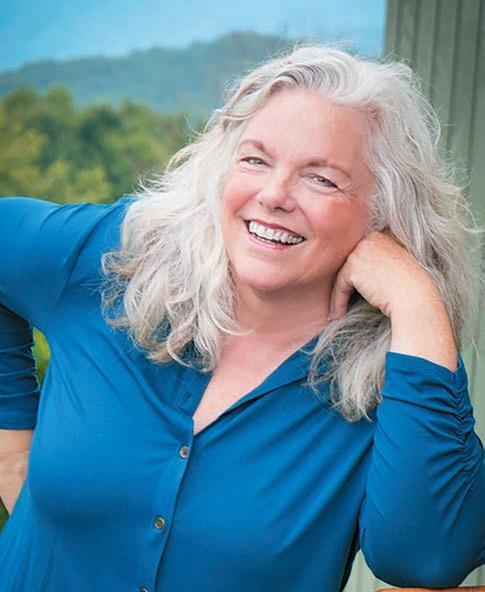

22 HIGH COUNTRY MAGAZINE February 2024
Lee Rankin, owner of Apple Hill Farm. She has developed a formula for success in agritourism, and shares her story and advice with others. Photo by Karen Radenbaugh.Photo by David Uttley.
Workshops, events and specialty tours evolved in an “organic” fashion, Lee said. “I had heard about people doing goat yoga, but never planned to pursue that idea until I was approached by a yoga instructor. She said she’d be willing to lead the sessions, so I agreed to give it a try. Every class has been sold out!” Lee said.
Baby goat yoga — scheduled only during June and July when the baby goats are small — is a fun (and sometimes chaotic) class combining yoga flow with playful angora kids that jump around and on
I had heard about people doing goat yoga, but never planned to pursue that idea until I was approached by a yoga instructor. She said she’d be willing to lead the sessions, so I agreed to give it a try. Every class has been sold out!
- LEE RANKIN
Alpaca fiber is hollow core and soft-to-the touch, with an insulating quality that allows a sweater to keep you warm when outside, but not too warm when you go inside. Socks made with alpaca fiber keep your feet warm and dry in the wintertime, and wick away moisture to keep your feet cool in the summertime. The fiber is hypoallergenic as it does not contain lanolin — a substance found in sheep wool.


February 2024 HIGH COUNTRY MAGAZINE 23

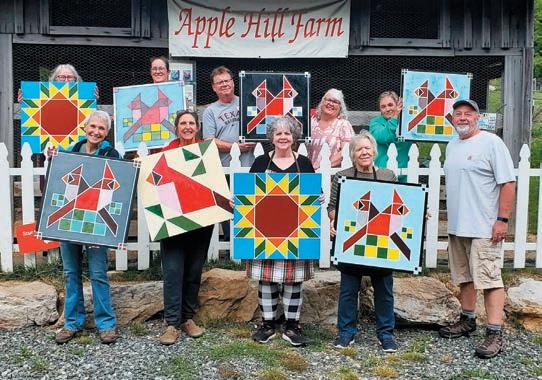

top of participants. Held outside when weather permits, or inside the barn when raining, the sessions offer people the chance to interact and connect with cute animals up close.
Knitting with alpacas is an activity that originated with Lee’s own love for knitting in a social circle. Participants bring their own knitting or crochet projects and set up in the orchard next to the alpacas, then enjoy a couple of hours of crafting, chatting and enjoying the sights and sounds of nature.
Lee added Barn Quilt Painting Workshops after encountering artist Ken McNeill during her annual exhibit at Carolina Fiber Fest in Raleigh. Visiting Ken’s exhibit across from her own, Lee admired his barn quilt paintings —two foot square pieces of plywood painted in the style of American folk art. Ken offered to teach classes at Apple Hill Farm, and Lee discovered yet another successful collaboration.
During the Covid pandemic, Lee and her team discovered another viable farm encounter to connect people to animals and nature: Alpaca zoom calls and “Llama bombs.” People could set up virtual encounters with animals at Apple Hill Farm via Zoom video calls.
“If a family or group was meeting together on Zoom, we could give a tour of the farm and share some interesting facts about the animals, or simply let people watch the alpacas graze,” Lee said. “It was hugely popular. We were all over the news because it was so unique. We even had international calls.”
For a fun twist on Zoom meetings or on-line classes, Apple Hill offered a “Llama bomb” — a drop in from the pasture that served as a surprise for most of the attendees.
“Sometimes it worked well — livening up the meeting a bit. Once or twice it caught management by surprise and they weren’t quite sure what to do,” Lee laughed.
Lee said the mission of Apple Hill Farm is to help people find joy and connection through the animals. In a world full of
Various events and workshops — including yoga with baby goats, knitting next to the alpacas, and barn quilt painting (as pictured) allow participants to develop and enjoy hobbies while outside, in the company of farm animals. Photo by Jan Todd.
24 HIGH COUNTRY MAGAZINE February 2024
During the farm tour, guests have the chance to stop at the overlook deck to admire the scenery and pose for photos. Photo by Jan Todd.
distraction and conflict, Lee said interaction with the animals is therapeutic and a welcome respite from stress people feel in their daily lives.
Sharing the knowledge
Lee has learned about farming and agritourism through a big dose of trial and error — but she is also a fastidious researcher. She networks with other farmers and with other business leaders to share ideas and support one another.
As we have moved toward urban and suburban living, many people have lost connection with what it is like to live and work on a farm. Agritourism gives us a chance to share our farms and provide an educational experience.
- LEE RANKIN
In addition to serving as president for the North Carolina Agritourism Networking Association, Lee serves as vice president of the Watauga County Farm Bureau, is an advisory member of the Watauga County Agricultural Extension and of the North Carolina Farm Bureau. She serves as vice chair for the Watauga Economic Development Commission and is a member of the Boone Area Chamber and the Banner Elk Chamber.
She is also a natural-born storyteller and published author, which positions her to help others find their own stories to tell.
Since 2019, Lee has been teaching workshops entitled, “Agritourism Works!”, held at her farm or even traveling to consult on-site at other farms. During the seminar, Lee uses her experience and skills to help farmers define their vision — and figure out how to add new revenue streams through agritourism.
“We talk about how to set their agritourism ‘table.’ The farms that are most successful are those with at least four legs to the table,” Lee explained. Apple Hill Farm, for example, offers visitors
a chance to meet unusual animals — one leg on the table. The store at the farm — with yarn, knitted clothing and gifts — is a second leg. The art workshops, events, and the farm itself are other legs.
In her consulting sessions, Lee helps farmers explore “what’s in their toolbelts,” she said. “For instance, the farm may have historical buildings or a 1920s farmhouse. The husband or wife might be a retired teacher, able to offer educational events for school field trips. They might be first-generation farmers — or multigeneration farmers. We hone in on the vision, then discuss the mechanics.”
Agritourism opens doors for farmers to engage with their end-use customers and allows the public to understand where their food and animal products originate.
“As we have moved toward urban and suburban living, many people have lost connection with what it is like to live and work on a farm. Agritourism gives us a chance to share our farms and provide an educational experience,” Lee said. t

February 2024 HIGH COUNTRY MAGAZINE 25
Pottery From the Ground Up: A Family Tradition
STORY BY LAYNE HENDRICKSON
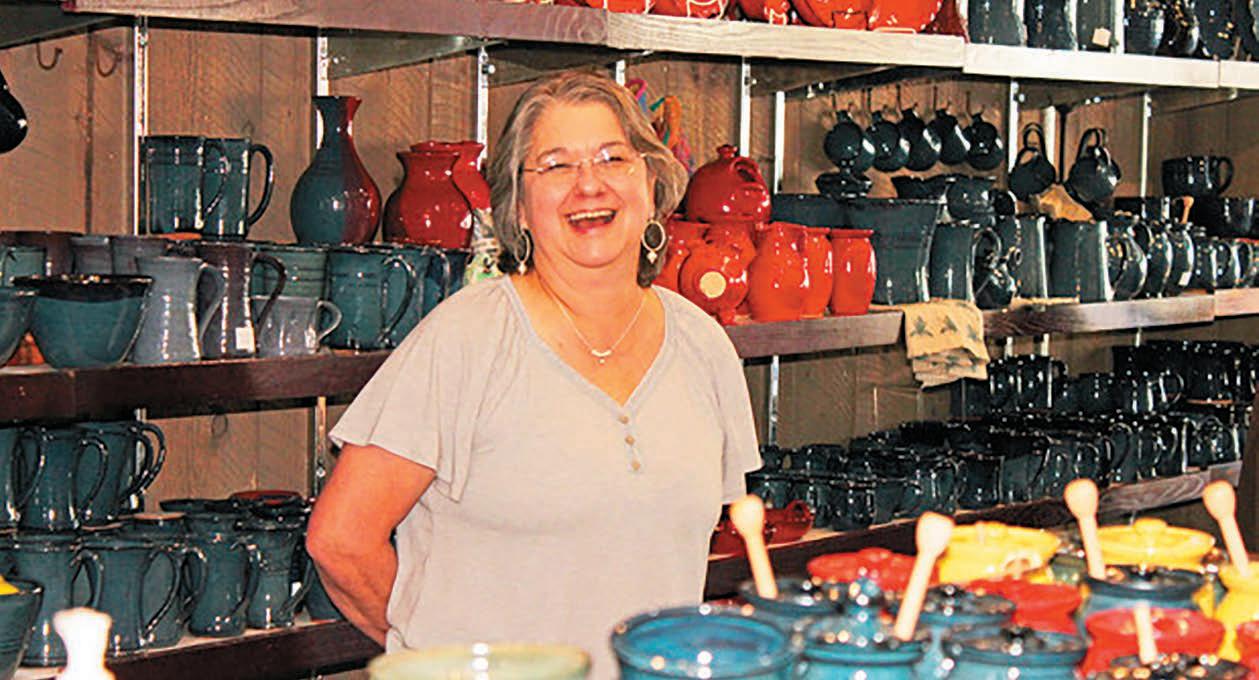
Janet Bolick-Calhoun arrives early for opening at her Blowing Rock shop ‘Bolick & Traditions Pottery’ with coffee in hand to talk with us about her family’s long, creative history. The shelves that line the walls are heavily laden with an infinite variety of entrancing forms, each bejeweled with riotous color. We find our seats amongst this splendor, and I ask for her story.
“My Mom’s from Seagrove, North Carolina. I was born there,” Janet begins referencing the famous pottery town. “My parents, Lula and Glenn, worked for my grandfather at ‘Original Owens Pottery’ for 10 years. In 1973, dad’s grandfather’s homeplace here had gotten sold out of the family and the family had first refusal to buy it back. So, they moved here in ’73 and bought that house back. And once they came here, they started ‘Bolick Pottery.’ It was just Mom and Dad in the ‘70s, making pottery in the mountains, from a little tourist town that was dead in the winter.
I always made pots. Growing up in a pottery shop, my parents, uncles, aunts, grandparents, they were all potters. I wanted to be there helping. And I think a lot of times they’d say, ‘Just go make some pottery!’ just to get me out of their way and out from under their feet. I did learn to throw pots. When I was five years old the New York Times newspaper came to the Seagrove area. At that

time there were only about four potters there. Now there are 70! But they came and did a one-page article about this little place in North Carolina that’s making this art pottery. They had a picture of me there and it said ‘Five-year-old, the youngest potter in the area.’ But I could throw a pretty good-looking pot when I was five.”
“I could only throw tantrums when I was five,” I interject laughingly. “I might have thrown a pot, but it would have been at my brother’s head!”
“Ha! Right! But you know centering the clay on the wheel is the hardest part,” Janet continues. “But they wouldn’t help me with that, because then they would have to stop what they were doing, go over, center it for me, get their hands muddy, wash their hands, go back to work. So, they weren’t really training me to do it. I just had to learn to do it.”
Janet Bolick-Calhoun takes great pride in upholding her family’s long tradition of making pottery that is as beautiful as it is functional. Photo by Layne Hendrickson.
26 HIGH COUNTRY MAGAZINE February 2024
“That was probably the best way to learn,” I add.
“It was,” Janet agrees. “And I would work very hard to fill a ‘board.’ They used eightfoot boards to hold the new pieces for drying because they were production potters. They would line up 30 something mugs on one board. So, I would work for, as a child, what felt like hours to put six things on a board. But my grandfather would come by, and he’d say, ‘If I don’t like it, they’re not going to buy it.’ So, he would destroy the ones that weren’t up to his standards because I was wasting his clay which was a hard thing to make. So, I learned young, that before you cut it off the wheel, you want it to look nice. That was instilled in me and it’s there to this day. I don’t have a lot of patience with other things, but with pottery, that’s where all my patience lies.”
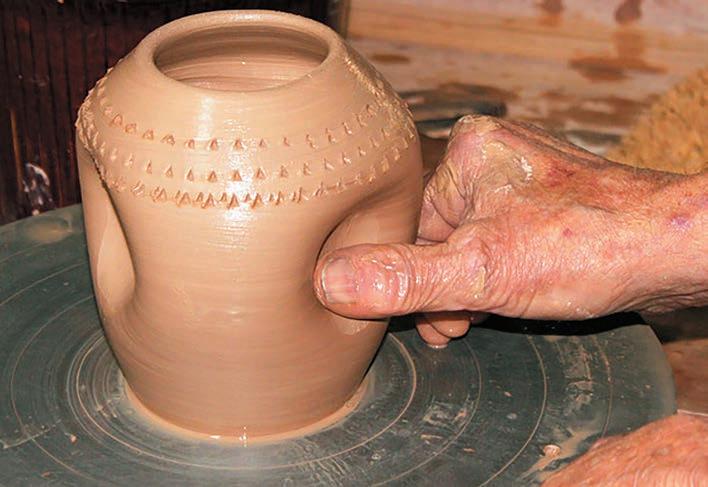
So, I learned young, that before you cut it off the wheel, you want it to look nice. That was instilled in me and it’s there to this day. I don’t have a lot of patience with other things, but with pottery, that’s where all my patience lies.
- JANET BOLICK-CALHOUN
“I’ll make a note of that,” I joke.
“So, growing up, I needed some running money,” Janet recalls. “And when I was 16, I needed gas money to run around on. And I would just keep making pottery.”
“Now how old were you when you moved to Blowing Rock?” I ask.
“I started third grade, so I was like seven or eight. I was still young. I’ve been here for most of my life. We were always expected to help in the pottery shop. And we were expected to help at the sawmill on Saturday mornings. Dad really instilled a work ethic in my brother and myself. We were taught to just go after it. So, I’m not afraid of work.” Janet says proudly.
“As I got older, I still enjoyed doing pottery, but I did retail management for about 15 years. I stepped away from that to do pottery full-time. And then Mike and I met in ’87 and he was a sheetrock contractor. I took him to the pottery shop to show him what I did, and I turned a

February 2024 HIGH COUNTRY MAGAZINE 27
As a final touch, Glenn leaves a thumbprint that may very well last for generations. Photo by Layne Hendrickson.
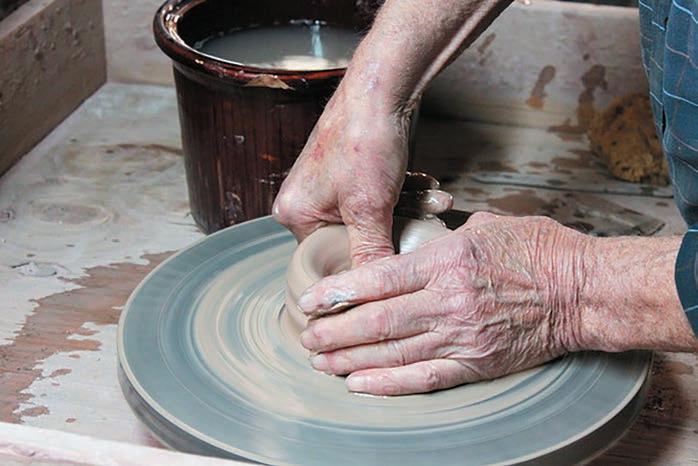
very fast pot because I wanted to show off and let him see how good I was. He was just really taken with it. He really wanted to learn it. And he had the patience for it. He was a quick learner. He was like my dad; he’d never even seen pottery. They saw an opportunity to learn a craft. Mike would go do sheet rock eight or ten hours a day, come home, have supper, and go to Mom and Dad’s workshop and just try to throw pots.
We’ve been at it 30 years now and Mike is a very sought-after potter. The face jugs that he does are very popular. And I still love to do the traditional forms that my parents and grandfather did.
- JANET BOLICK-CALHOUN
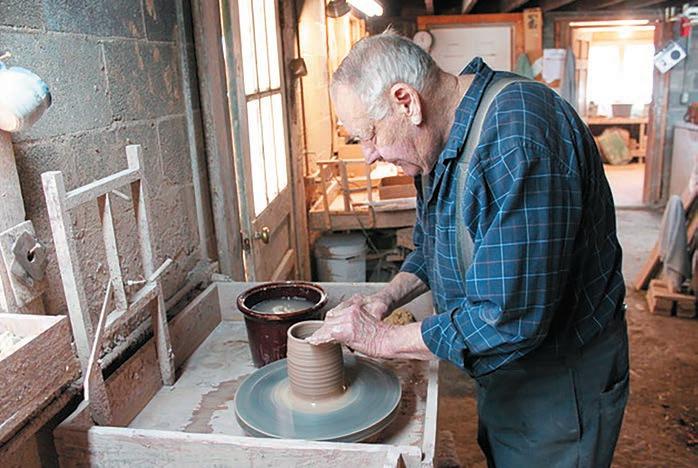
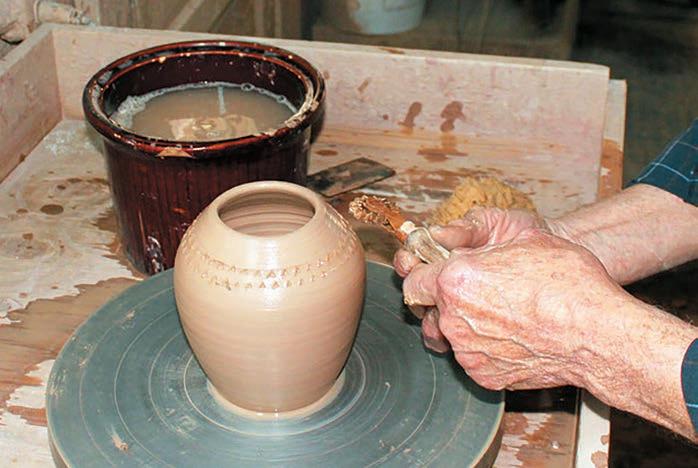
So, we saved up and built our house. And then we saved up and built our workshop. But before we built our workshop, we rented a little store out here on the bypass. That was 30 years ago in the ‘90s. I was still managing, and Mike was manning that store, but he was also learning to make pottery, glazing, and we had a kiln. And by the time we got our workshop completed and we moved in there, he knew what he was doing… to some point. Ha! It was a tough go, but I had faith in the Lord that he would take care of us, and He has. We’ve been at it 30 years now and Mike is a very sought-after potter. The face jugs that he does are very popular. And I still love to do the traditional forms that my parents and grandfather did.”
“Could you tell us a little bit about the Seagrove, N.C. pottery tradition that y’all brought up to the mountains with you?” I ask.
“Sure. There were two German brothers that settled there in the mid-eighteen hundreds.” Janet explains. “In Moore County, which is right in the center of North Carolina, because of the clay source. There was clay right in the creek bed. You could dig down just six or eight inches and hit a vein of good red clay. They did utilitarian pottery. They would make clay pickling crocks and clay canning jars, and things that people used every day. This was before glass was common. My grandfather told me that he remembered his dad putting those vessels on a horse and wagon and they’d start out north until they sold everything.”
“I’ve dug clay and made a pot or two
A rotating marking tool is expertly wielded by Glenn to imprint an attractive design on the spinning pot. Photo by Layne Hendrickson.
Janet’s father, Glenn Bolick, deftly raises the sides of the vessel making it look deceptively simple. Photo by Layne Hendrickson.
Centering the clay on the wheel is one of the harder steps to learn. Photo by Layne Hendrickson.
28 HIGH COUNTRY MAGAZINE February 2024

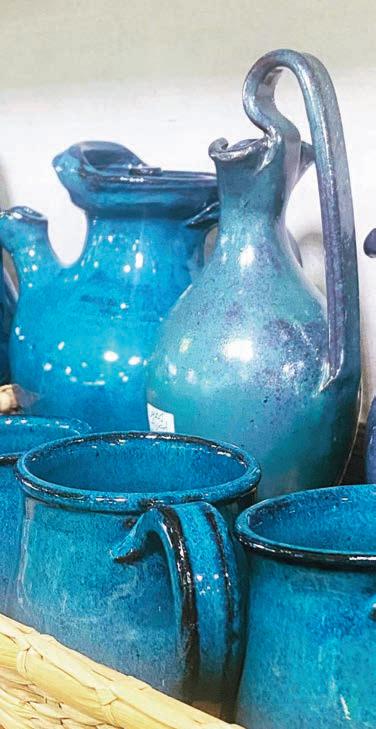

February 2024 HIGH COUNTRY MAGAZINE 29
From start to finish of a few creations made by Bolick & Traditions Pottery. Photos courtesy of Bolick & Traditions Pottery
When you get serious about wanting superior, knowledgeable service in buying or selling real estate in our beautiful High Country, then contact Banner Elk’s oldest brokerage firm. Put 36 years experience in our local real estate market to work for you!
We
John D. Davis, III Owner/Broker

YEARS

828.260.1550
PO Box 336, 161 Silver Springs Dr. Banner Elk, NC 28604
www.bannerelkrealty.com
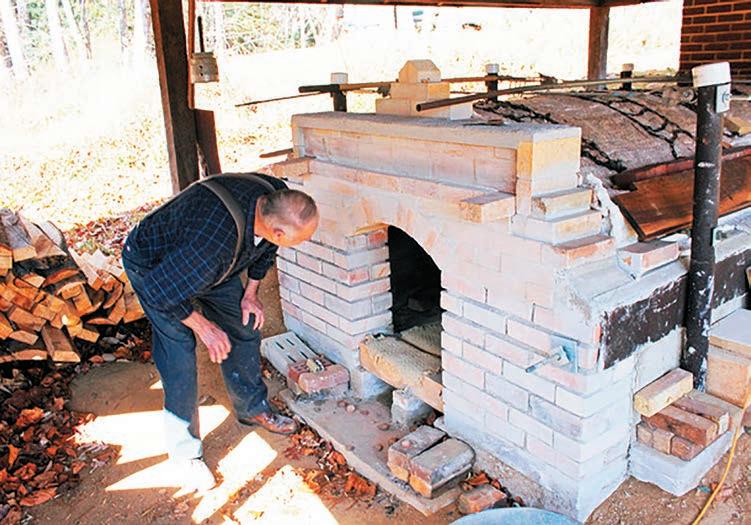
myself,” I add. “With a lot of help from an old potter friend. It was a lot of work! I can’t imagine how much effort it takes y’all to do it on that scale.”
“It is a lot of work,” Janet agrees. “We make it more work than it has to be. Learning as production potters

and coming out of that era of art pottery and functional pottery, my grandparents mixed their own glaze. He built his own wheels. There weren’t always commercial pottery wheels around. I threw on the wheel my grandfather built me until about 15 years ago. I just loved throwing on it. It did everything I needed it to do.”
“Hearing about your families’ selfsufficiency has given me an idea for the headline for this story, ‘From the Ground Up,’ I posit.
“Oh nice! Yeah. That’s a good one. And it really is from the ground up.” Janet agrees. “Even the clay, the glaze, we do it all ourselves. Most potters today will buy their clay bagged and ready to throw. But we’ll still go to South Carolina and get a guy with a tandem truck to bring us a load about every three years. So, we have our own recipe. When we do it, we grind up about 1,200 pounds of clay. It takes about four people to do that. We have an old brick mill that is about 150 years old. We power it with a pulley and a tractor, our old MasseyFerguson. It’ll grind it and get it into a tube shape. Then we take that and run it through a compressor that gets the air out of it. It makes our clay better. A lot of people who throw commercial clay try ours and go ‘Wow!’ But it allows us to make some shapes with small necks, or little bottoms, or from large back into small because it has ‘grog’ (ground prefired clay) which helps it stand up.”
“I’ve drunk some grog,” I confess. “Same thing?”
“Ha! Not the same,” Janet corrects and quickly refocuses our conversation. “But we
“THE ONLY NAME YOU NEED TO KNOW IN MOUNTAIN REAL ESTATE”
Banner Elk Realty
are committed to professional service.
42
30 HIGH COUNTRY MAGAZINE February 2024
Glenn inspects the wood-fired kiln they use to fire the dried pottery pieces. Kiln openings are large events held twice a year in June and November. Photo by Layne Hendrickson.

have colors that you’re not going to see everywhere because we mix our own glaze and our own clay.”
“When did you open your first shop here then?” I ask.
“We were out on the bypass at two different places. And then for several years we did a lot of shows. We’d go to all these great indoor pottery shows, street festivals back when they were really nice,” Janet opines. “We did that for years, but when 321 got fourlaned in three phases, well we were the end and the beginning of second and third phases there at Blackberry Road. So, we had construction for about 10 years! It was really hard to keep a sign there for people to see. As a result, business had really fallen off.
People had always been coming down there. You know, Mom and Dad have been at it 50 years. It’s a regular stop for folks on their trips to Blowing Rock. It’s a fun place. We have music there. We hosted a Sunday afternoon bluegrass jam there for 12
years. I mean we would just pack the house. There would be 100 people there. Sometimes we’d have five pickers there, sometimes we’d have 15. But we really built up a presence, ‘I can go there to hear music and buy handmade pottery.’
I have a cousin that made homemade ice cream every Sunday. We had our little commerce going on down there, but with the construction we thought that maybe it was time to quit the shows.
With the pottery we had, we thought we would be better off to be
Learning as production potters and coming out of that era of art pottery and functional pottery, my grandparents mixed their own glaze. He built his own wheels. There weren’t always commercial pottery wheels around. I threw on the wheel my grandfather built me until about 15 years ago. I just loved throwing on it. It did everything I needed it to do.
- JANET BOLICK-CALHOUN

February 2024 HIGH COUNTRY MAGAZINE 31
Janet’s father, Glenn Bolick, has markings on the wall over the cutting wire that let him know exactly how much clay he needs for many of the items they make. Photo by Layne Hendrickson.
People come in and ask, ‘Where do you get your pottery?’ and we say, ‘We make it right down the road!’ People want to buy something authentic to take home with them. Well, this is made right here from start to finish. And I tell them, ‘It’s even
made from Carolina clay!’
- JANET BOLICK-CALHOUN
in Blowing Rock. I’ve been at it here for about 16 years now. I was across the street for about six years until we found a better location on this side of the street. Now we’re facing Main Street and it’s been really great. We’ve thrived here. I carry ‘Bolick Pottery’ which is my parents, ‘Traditions’ which is Mike and myself, and ‘Original Owens Pottery’ which is my uncle. Boyd and Nancy, Mom’s two siblings, are the main potters there. So, in this store you get three businesses from the Owens family of potters. The Owens family has produced more potters than any other name in North Carolina and the Southeast really. They were all the descendants of those two German brothers that settled near Seagrove for the clay source all those years ago.”
“And now y’all have brought that tradition to Blowing Rock to blend with your dad’s side of the family’s mountain heritage. That’s fantastic,” I observe. “It appears to be a good mix! Your

shop is now an important part of the town.”
“Blowing Rock really is amazing, Janet enthuses. “You pick up any magazine, Trip Advisor, Southern Living, Our State, it’s in all of them. It’s in all the top picks for North Carolina and the entire South. It does have that small town feel. People come in and ask, ‘Where do you get your pottery?’ and we say, ‘We make it right down the road!’ People want to buy something authentic to take home with them. Well, this is made right here from start to finish. And I tell them, ‘It’s even made from Carolina clay!’”t
 Janet’s husband, Michael Calhoun, often makes face-jugs such as this much sought after Santa Claus jug. Photo by Layne Hendrickson.
Janet’s husband, Michael Calhoun, often makes face-jugs such as this much sought after Santa Claus jug. Photo by Layne Hendrickson.
32 HIGH COUNTRY MAGAZINE February 2024

Playing Pickleball: A Sport for All Skill Levels
STORY BY JOSHUA BIGGERS

34 HIGH COUNTRY MAGAZINE February 2024

February 2024 HIGH COUNTRY MAGAZINE 35

Being on a pickleball court is a feeling like no other. It’s an immersive experience – a dynamic interplay of skill, strategy, and social interaction. It’s a place where the joy of play merges with the thrill of competition, creating vibrant memories with every match. On the court, players are surrounded by the unmistakable pop of the ball and shuffle of sneakers on the surface. The atmosphere crackles with a blend of focus, energy, and the anticipation of a game about to unfold.
In the midst of the game, there's a sense of community. Whether you're playing a friendly match or a competitive game, there's a shared understanding among players. Laughter punctuates the action, and there's a mutual respect for the ebb and flow of the game.
Time on a pickleball court feels elastic. In the span of a single point, seconds stretch and contract, and every instant is filled with the potential for a spectacular rally or a well-executed shot. The camaraderie extends beyond the court, fostering connections and friendships that often continue off the playing surface. And across the High Country – in Ashe, Avery, and Watauga counties, specifically – this interaction is growing in popularity.
History of the Sport
Pickleball is a relatively young sport, originating in the mid-20th century. It was created in 1965 on Bainbridge Island, Washington, by three families: the Pritchards, the McCallums, and the Bells. The families were looking for a way to entertain their children during the summer, and they decided to combine elements of badminton, tennis, and ping pong to create a new game.

Initially, they used ping pong paddles, a perforated plastic ball, and a badminton net that was lowered to a suitable height. The game proved to be engaging and accessible to people of all ages, making it an instant hit in their community.
As you stand there, paddle in hand, there's a unique mixture of tension and excitement. The players on the court are eager to engage in volleys and serves. The lines on the court dictate the boundaries of play, and the net in the middle is both a divider and a connection between opponents.
In the environment, the sound of the ball meeting the paddle echoes in the air – a rhythmic noise that accompanies the backand-forth exchanges. There's a certain harmony in the way players move, each step deliberate and calculated, eyes keenly tracking the flight of the ball. It's a game of motion, strategy, and fluidity.
The non-volley zone near the net, known as the "kitchen," introduces an element of tactical finesse. Players navigate this area, employing dinks and drop shots that demand precision and control. The court, despite its limited dimensions, opens up a vast expanse for creativity and skillful play.

36 HIGH COUNTRY MAGAZINE February 2024
Photo by Josh Floyd.
The name "Pickleball" has a charming origin. It is said to be named after the Pritchards' family dog, Pickles, who had a penchant for chasing after the ball and running off with it. The name stuck, and the sport gained popularity.
As the game gained traction, players and enthusiasts worked together to formalize rules and spread the sport to other communities. It started to be played in community centers, school gyms, and backyards across the United States. Pickleball's appeal lies in its simplicity and inclusivity, allowing players of different ages and skill levels to enjoy the game together.
Rules of the Game
The rules of pickleball are straightforward, and they are designed to promote fair play and ensure a fun and engaging experience for all players.
Starting the Game: The game begins with one side serving the ball. The server must stand behind the baseline and hit the ball diagonally across the net to the opponent's service court. The serve must be underhand and contact the ball below the waist.
Serving: The serve must be made with an underhand stroke. The point where the paddle makes contact with the ball must be below your waistline, specifically below the level of your navel. The taller you are, the higher this limit will be. Additionally, the server must keep at least one foot behind the baseline and within the sideline.
Double Bounce Rule: The receiving team must let the serve bounce once before returning it, and the serving team must also let the return bounce once before hitting it back. After these two bounces, the ball can be hit in the air or after one bounce.
Volleying: Volleys (hitting the ball in the air without letting it bounce) are allowed, but they must be made while the player is behind the non-volley zone, also known as the kitchen and done so after the two bounce rule has occurred.


Non-Volley Zone (Kitchen): The non-volley zone is the area within 7 feet of the net on both sides. Players cannot hit volleys while standing in this zone. Players can step into the non-volley zone after hitting a ball that has bounced, but they must exit before hitting a volley.
Scoring: Games are typically played to 11 points, but the winning team must win by at least 2 points. Points are scored only by the serving team.
Court Faults: A fault occurs when a player violates a rule. Common

 Photos by Josh Floyd.
Photos by Josh Floyd.
February 2024 HIGH COUNTRY MAGAZINE 37
Photo by Josh Floyd.

faults include stepping into the non-volley zone and failing to get the serve over the net. This can result in a loss of serve or a point dependent upon the court situation.
These are the basic rules of pickleball, but there are additional nuances and variations depending on specific circumstances and local rules. It's always a good idea to check with the governing body of the tournament or facility you're playing at for any specific rules they may have in place.
Local Opportunities
The High Country region has a thriving pickleball community with numerous dedicated courts and clubs. Many local towns like Boone, Linville, and Jefferson have embraced the sport, as you can find pickleball courts in public parks, community centers, and private clubs.
If you're interested in playing pickleball, you'll likely find plenty of opportunities to

do so! Below are some of the go-to spots in the High Country.
The Summit
The Summit, located in Boone, is one of the newest pickleball venues that opened on September 18, 2023.
Grant Williams and Crystal Smith are the cofounders of The Summit, and they shared that the idea of the facility came about after attending a pickleball tournament in February 2023.
 Photo by Josh Floyd.
Photo by Josh Floyd.
38 HIGH COUNTRY MAGAZINE February 2024
Photo by Josh Floyd.
“We wanted to create a place where people could play pickleball on dedicated courts all year long, regardless of weather, and a place where people could gather and create community,” Crystal said.
Grant and Crystal are active pickleball players and have been mixed double partners for three years. In that time, they have both been certified as coaches by the Professional Pickleball Registry, won the World Pickleball Tour Golden Ticket in 2023, and placed gold in multiple tournaments throughout 2021, 2022, and 2023.
Grant discovered pickleball in 2021 and has been fully obsessed ever since. When not on the court, Grant works as an ER doctor at Watauga Medical Center and Cannon Memorial Hospital, which he has been doing for 20 years.
“The first time I tried pickleball I was absolutely hooked; I’ve played nearly everyday since. I love it and want to do anything and everything I can to spread the game of pickleball,” Grant said.
The first time I tried pickleball I was absolutely hooked; I’ve played nearly everyday since. I love it and want to do anything and everything I can to spread the game of pickleball.
- GRANT WILLIAMS


February 2024 HIGH COUNTRY MAGAZINE 39
Photo by Josh Floyd.
Crystal’s experience also dates back to 2021 when a close friend of hers convinced her to try it out. She was quickly hooked and found herself playing every day, and if you ask her friends, it’s all she talks about.
The Summit is fully self-invested and contains six indoor pickleball courts and two dedicated dinking kitchens to warm up before play. Additionally, the facility has a bar and lounge area for relaxing and socializing.
The Summit's first tournament was conducted November 1819 and was a smashing success. The Summit worked in conjunction with Southern Pickleball to host an incredible tournament where there were 161 players across over a dozen divisions. Players from all over the southeast collided during a weekend of pickleball fun.
According to Desire Hart, who is from Charlotte, “The
Summit is the best new indoor pickleball place in the Boone, NC, area. Great lighting, wonderful outdoor floors, and friendly people. check it out!”
Another review from ProXR pickleball pro states, “We all agreed it was the most fun we’ve ever had playing pickle.”
The Summit is hoping to open the game of pickleball to an entire new generation of players. They have added college nights that encourage students at App State to come and try this amazing game and make some friends while they're at it.
The Summit offers beginner clinics, private lessons, dropin leagues, tournaments, after school programs, rentals, and plenty of open play times. For more information, visit https:// thesummitpb.com/.



 Photos by Josh Floyd.
Photos by Josh Floyd.
40 HIGH COUNTRY MAGAZINE February 2024

February 2024 HIGH COUNTRY MAGAZINE 41
more

In 2021, the state granted AMOREM’s request to build a hospice patient care unit for residents of Ashe, Avery and Watauga counties. Please consider a tax deductible donation to make this a reality.
Donate today or learn more at www.amoremsupport.org/donate, 828.754.0101 or scan here!

Watauga County Recreation Center
“Our gift is an act of love.”
—Family of the late Will Pierce




EVALYN PIERCE WITH FATHER WILL

JOIN THE PIERCE FAMILY TO BRING TO THE HIGH COUNTRY
The Watauga Community Recreation Center is a stateof-the-art Recreation Center that opened in 2021 at 231 Complex Drive in Boone. Outside on the WCRC campus, there are outdoor pickleball courts for members to use. Additionally inside the rec center there are pickleball courts set up for members to use during specific times of the day.
Members of the WCRC receive unlimited access to the WCRC during operating hours as well as free pickleball programming or advanced pickleball training for a fee.
Ashe County Parks and Recreation
Located in Jefferson on Ashe Central School Road, the Ashe County Parks and Recreation also offers pickleball opportunities on Tuesdays and Thursdays from 8 a.m. to 12 p.m. From 8-10 a.m., advanced players are on the courts, while from 10-12 p.m. intermediate and beginners are encouraged to play.
Mary “Midge” Presnell is the Ashe County ambassador for USAPA Pickleball. She encourages anyone who has ever had the slightest thought of trying pickleball to come to Ashe Family Central and give it a try. She started playing in 2011
42 HIGH COUNTRY MAGAZINE February 2024
FORMERLY BURKE HOSPICE AND PALLIATIVE CARE & CALDWELL HOSPICE AND PALLIATIVE CARE 828.754.0101 1.844.4AMOREM WWW.AMOREMSUPPORT.ORG PROUDLY SERVING ASHE, AVERY AND WATAUGA COUNTIES
2014
SINCE
AMOREM NEEDS YOUR HELP TO BRING
YOUR GIFT IS AN ACT OF LOVE TO THE HIGH COUNTRY...
quality. more compassion. more support.
more
Photo by Josh Floyd.

and hasn’t looked back.
“I really love this game for seniors,” Midge said. “They need a sport that is comparable to tennis they can switch to as they get older.”
Pickleball allows much less strain on the body, and players can play until the day they decide not to.
“I really think pickleball is an allaround healthy game that any age level can play,” Midge said.
With three painted courts and nets, paddles, and balls made available, everyone interested is welcome to join in on the fun. Ashe Family Central has players who are in high school as well as players who are retired. All are welcome.
Over the years, pickleball has continued to grow in popularity. Tournaments, leagues, and clubs have formed, creating a vibrant and passionate community of pickleball players. The sport has also expanded internationally, with players from around the world joining in on the fun. Today, Pickleball is played by millions of people of all ages worldwide. Its history, rooted in a backyard on Bainbridge Island, stands as a testament to the power of creativity, community, and the joy of play.
Pickleball has gained tremendous popularity in North Carolina, too, creating a vibrant community of enthusiasts across the state. Whether nestled in the picturesque mountains,
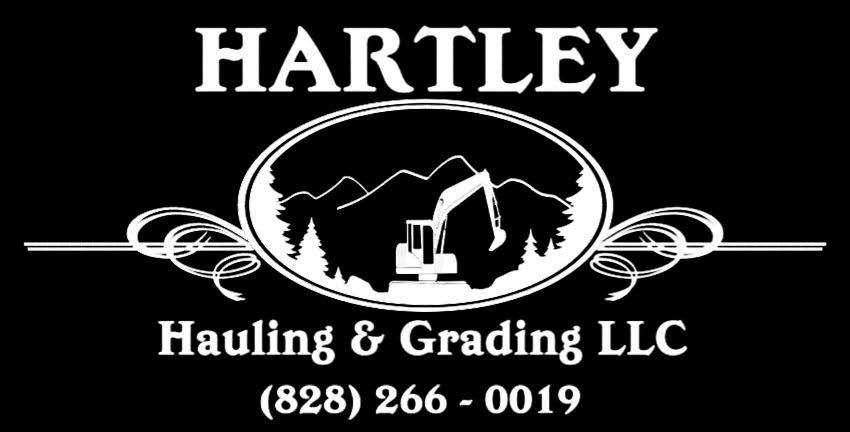
coastal towns, or bustling cities, pickleball courts have become hubs of activity and social engagement. From the scenic Outer Banks to the Appalachian foothills, North Carolina offers a diverse backdrop for pickleball enthusiasts to enjoy this dynamic sport. Community centers, parks, and dedicated pickleball facilities cater to players of all skill levels, fostering a sense of camaraderie and friendly competition. Tournaments and leagues have sprung up, attracting players from various age groups, making North Carolina a thriving hub for pickleball enthusiasts who appreciate not only the sport but also the sense of community it fosters across this beautiful southern state. t
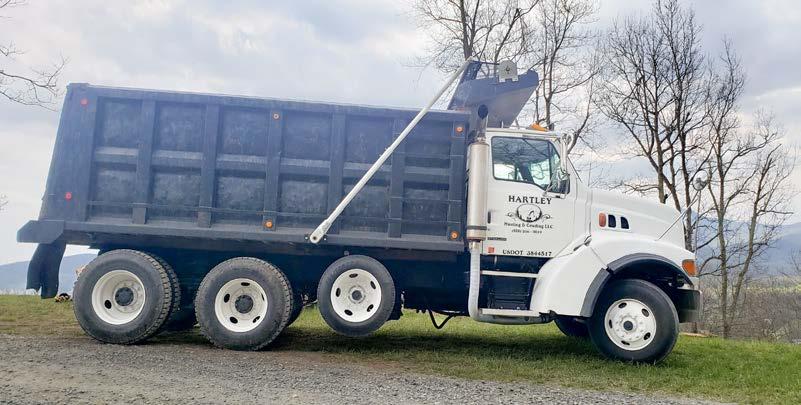

We provide a wide range of services to help you get your next project on its way. SERVICES: Gravel Delivery • Driveway Grading Demolition & Removal • Footers For New Homes • Site Work Clearing Dirt Removal & Hauling • Land Grading and much more! HartleyHaulingandGrading.com
February 2024 HIGH COUNTRY MAGAZINE 43
Photo by Josh Floyd.
Putting the 'French'in the French-Swiss Ski College: BENJAMIN MARCELLIN
STORY BY LAYNE HENDRICKSON
The first snow of the season decides to fall on the morning of our interview. ‘How apropos,’ I think as I gleefully crunch my way past the ice-skating rink. I pause a moment to watch the Zamboni Machine in action, as Bachman Turner Overdrive’s ‘You Ain’t Seen Nothing Yet’ blares through the frigid air from the loudspeakers overhead. Before me stands the massive Appalachian Ski Mountain lodge in all its Alpine glory, its feather-board cladding painted so dark a brown as to appear black, with bright orange scrollwork trim outlining its eves against the winter wonderland backdrop of the slopes beyond. The snow making machines have beaten Mother Nature

to the punch this morning. No doubt, they have been roaring all night as there are already exquisitely groomed slopes beckoning from all sides, each with skiers gracefully zigzagging their way down, proudly leaving their ‘first tracks’ in the fresh, crystalline powder. With the great lodge looming before me, I stomp the new snow from my boots and enter with a woosh through the automatic sliding glass doors. Appreciating the blast of warm air that greets me, I meander my way through the 1960’s Bavarian style interior to find the offices of ‘The French-Swiss Ski College’ and its director, French born Benjamin Marcellin.
Affable and gregarious, the soft-spoken Benjamin presents
and now serves as Director of
 French born Benjamin Marcellin first came to Appalachian Ski Mountain in 1979
the French-Swiss Ski College. Photo by Layne Hendrickson.
French born Benjamin Marcellin first came to Appalachian Ski Mountain in 1979
the French-Swiss Ski College. Photo by Layne Hendrickson.
44 HIGH COUNTRY MAGAZINE February 2024
an imp-like charm complete with toboggan tousled hair and a mischievous grin. He has an infectious enthusiasm for life in general, but for all things snow in particular. In his enviable French accent, he introduces me briefly to his office staff and then shows me into the inner sanctum of the school. Through a large, diamond paned, leaded glass window, the main slope is on full view providing never-ending distraction from the boring spreadsheets papering the walls of his office.
“So, do ski instructors get to take snow days off?” I ask jokingly.
“No. No we don’t!” Benjamin replies with a hearty laugh. “That’s when we’re supposed to be here!”
“That’s the exact opposite of the rest of the world!” I remark.
“That’s what we live for!” Benjamin exclaims.
“I can’t help but notice the tiny little yellow skis mounted up on your wall there,” I remark.
“I was two years old when I got those. They were my first set of skis. And when I graduated from those, I got into these,” Benjamin explains while pointing to an only slightly larger set on the opposing wall.
“You’ve been on the snow for some time! Now where are you from in France?” I ask.
So, I’ve never left the ski industry from being a young instructor in France at 16 years old, being a racer prior to that, and being in the military recon in the ‘Chasseurs Alpins’ where I was teaching skiing, but also doing all the border patrol in mountains and whatnot. And then coming here in ’79 and being a ski instructor.
- BENJAMIN MARCELLIN
“From a town called ‘Annecy.’ It’s in the core of the French Alps. It’s in the region called ‘HighSavoie’”Benjamin informs.
“So, you come from a skiing culture then,” I remark.
“It’s what people did,” he replies matter-of-factly. “At the time there was no snowboarding. You were either an Alpine skier or a cross country skier.”
“When did you start working here at Appalachian Ski Mountain?” I ask.
“December of 1979,” Benjamin recalls with rather surprising certainty. “So, I was here from ’79 to ’89 and then I moved back to France December the 24th actually. I stayed for 17 years in France. My family needed me and also, I was a sales representative in the ski industry. So, I’ve never left the ski industry from being a young instructor in France at 16 years old, being a racer prior

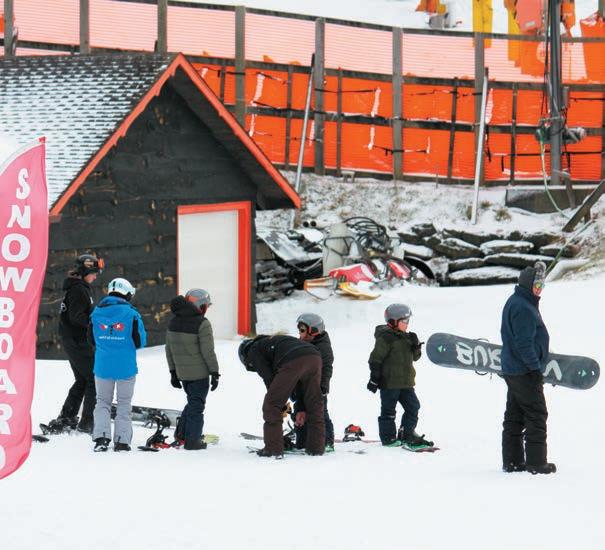 Snowboarding has become a very popular pursuit among beginners at the French-Swiss Ski College. Photo by Layne Hendrickson.
Snowboarding has become a very popular pursuit among beginners at the French-Swiss Ski College. Photo by Layne Hendrickson.
February 2024 HIGH COUNTRY MAGAZINE 45
Photo by Layne Hendrickson.

to that, and being in the military recon in the ‘Chasseurs Alpins’ (‘Alpine Hunters’ an elite mountain infantry force of the French Army trained to operate in mountainous terrain) where I was teaching skiing, but also doing all the border patrol in mountains and whatnot. And then coming here in ’79 and being a ski instructor. I was also an ambassador for a lot of brands. So, for 17 years in France, I was a sales rep in the snow sport industry. It was basically skiing and snowboarding, but I also sold tennis equipment and mountaineering equipment also.”
“How did you end up in Blowing Rock?” I enquire.
“When in 1979 I was released from my military obligations, a friend of my father came by who lived in Vermont at the bottom of Sugarbush North (one of the largest ski resorts in New England) and he had a business of importing ski equipment. He asked me what I was going to do. I told him that I was either going to university or getting a job. I was done with military service; I was 20 years old and had really no
plans. And he said, ‘Why don’t you come and see if you can teach skiing in Vermont? Or work in the ski shop?’ His wife had a ski shop at the time. So, four months later I ended up in Vermont. I had saved some money up. And when I say money, I mean like $4,120! So that doesn’t take you very far!” Benjamin laughs. “But then it wouldn’t snow. It was very cold, but it just wouldn’t snow! So, he said, ‘Well nobody’s hiring here now, but I have a friend named Jim Cottrell who has a ski school in the South, in the Appalachian Mountains.’ Both of them were connected through Jean Claude Killy, the Olympic champion. They were friends with him, who is still one of our remote directors here. So, I got on the phone and Jim Cottrell said, ‘Why don’t you come for a week? We have a place for you to stay. And if it works out after a week, then you’re staying. And if it doesn’t work out, then no hard feelings.’ And it worked out. I ended up staying 10 years, coming back every winter, and in summer I would do landscaping and construction. And I played in a band, so we would travel.
So, I got on the phone and Jim Cottrell said, ‘Why don’t you come for a week? We have a place for you to stay. And if it works out after a week, then you’re staying. And if it doesn’t work out, then no hard feelings.’ And it worked out. I ended up staying 10 years, coming back every winter, and in summer
I would do landscaping and construction
- BENJAMIN MARCELLIN
 Benjamin began skiing as a two-year-old in the Alps of France and displays his first pair of skis on his office wall.
Benjamin began skiing as a two-year-old in the Alps of France and displays his first pair of skis on his office wall.
46 HIGH COUNTRY MAGAZINE February 2024
Photo by Layne Hendrickson.
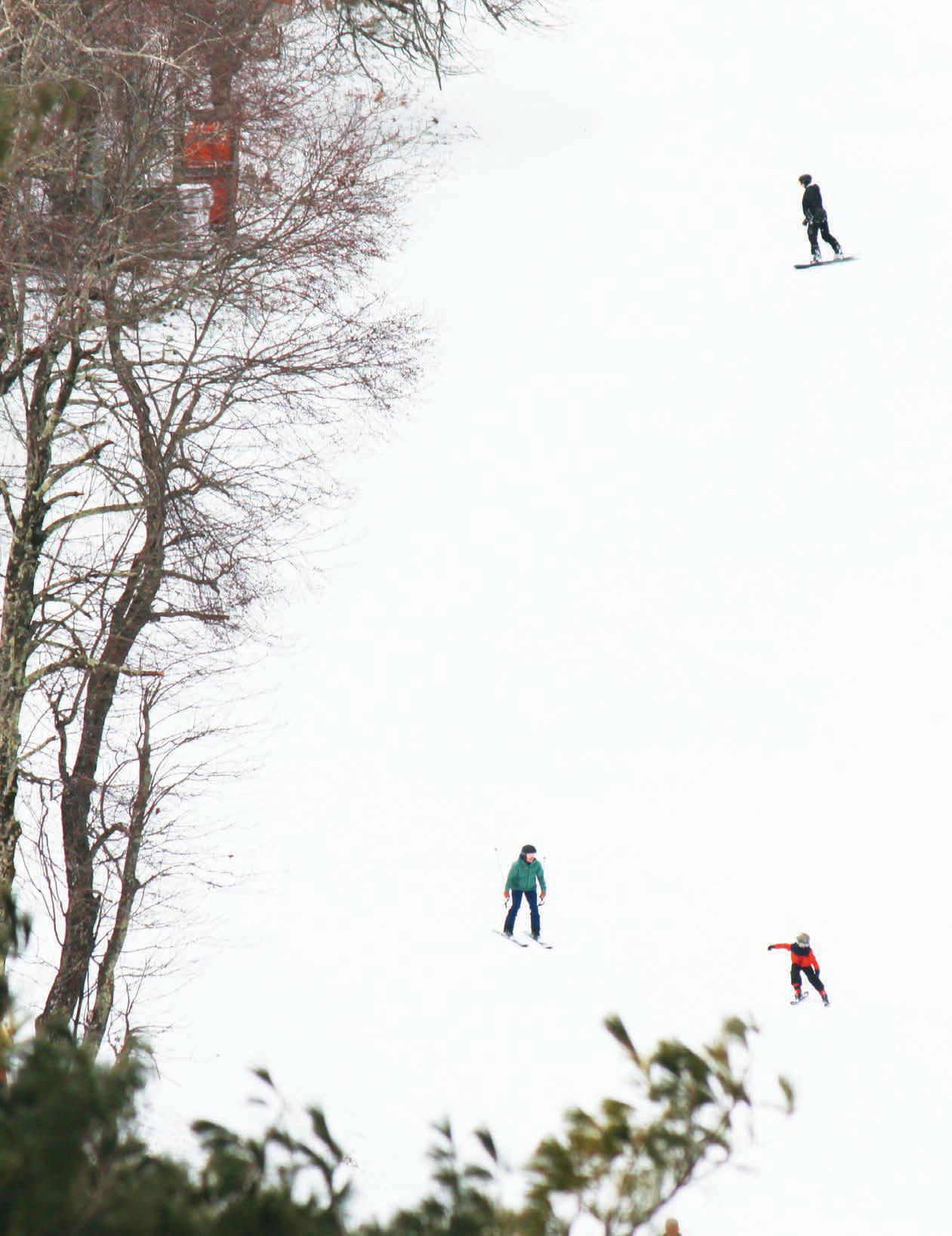
February 2024 HIGH COUNTRY MAGAZINE 47

I got involved in a band in 1980, and when I was not skiing, we were playing out of state. ‘CBGB’s’ and ‘Max’s Kansas City’ in New York, these sorts of places.”
“Wow! That’s impressive! Those were the heavy hitter New York Punk Rock clubs of the day!” I enthuse.
“Audition night, you have five bands, and you start playing at 2 a.m. because you are band number three!” Benjamin recalls with a laugh. “And when you finish your set, you have to wait until everybody else is finished so it’s daylight when you come out! New York life. But that was fun. And then we ended up moving to England for a year to do some recordings, and then everybody came back a year later and the band split. I went back to skiing.”
“That’s just epic! I was a touring musician myself, so I’m really impressed! You made some amazing memories. What was the name of your band?” I ask.
“Gangrene Ltd.” Benjamin replies with a laugh. “Yeah, did that for a while, and then I came back in ’83 and stayed until ’89. And that’s when I moved back to France. And then I came back in 2006. I had a choice between Charlotte, Hickory, or Blowing Rock. At the time,

48 HIGH COUNTRY MAGAZINE February 2024
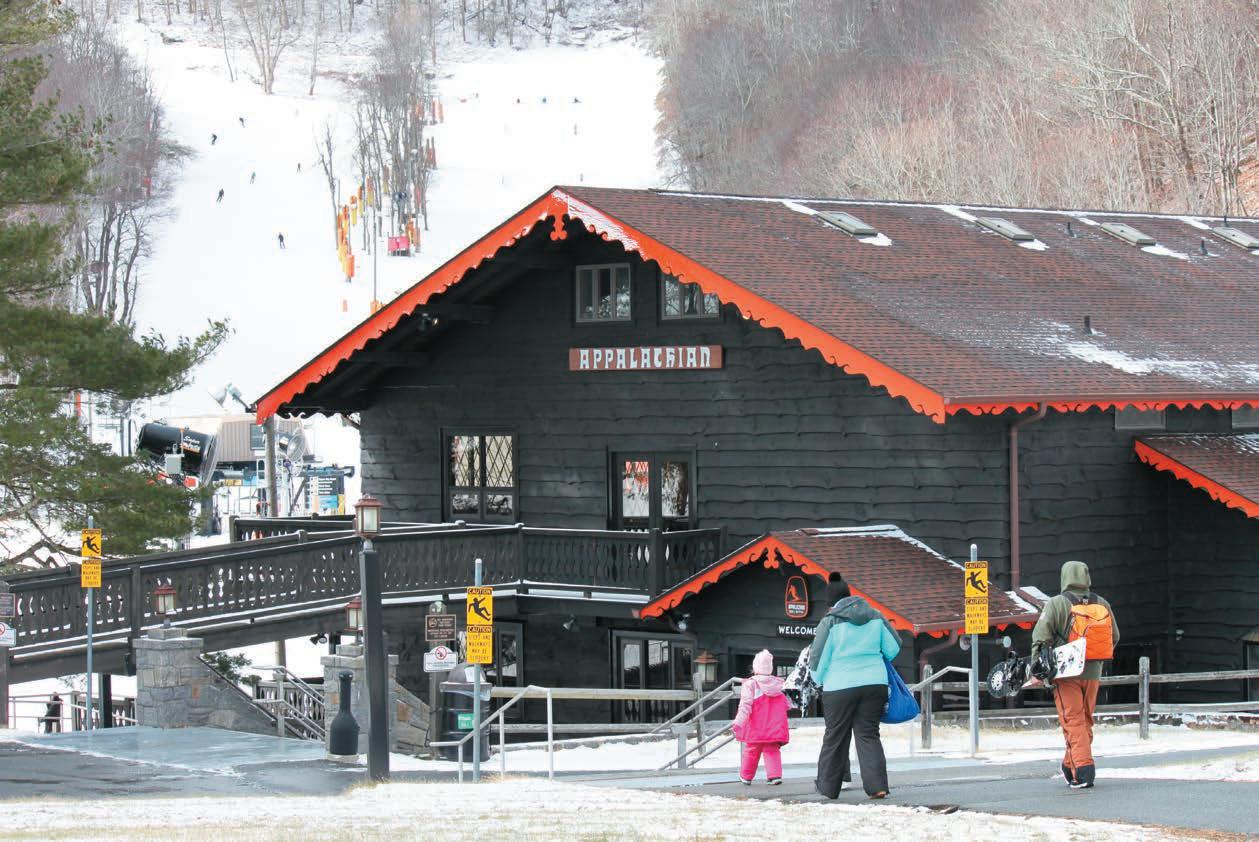
with two young kids, age seven and five, Blowing Rock seemed to be home to me, safer, good atmosphere, skiing. The kids could be in the woods hiking, camping, doing everything. My kids had grown up in the woods in France too. And Blowing Rock is a good school. So, we ended up… up here.
I came back to teach and then later on got involved in coordinating the instructors up until Covid. And when Covid hit, Jim Cottrell, creator and owner of the French-Swiss Ski College decided that after 52 years of running the ski school, he said ‘I can’t deal with that and bring that home.’ He decided to sell his business to Brad Moretz owner of Appalachian Ski Mountain. And Brad gave me a call when that decision was made, and it was on a Thursday, and he asked, ‘What’s your plan? Because we need a ski school director.’ I had been running the ski school with the son of the owner, Pace Cottrell. We had been running it together already, for quite a few years.

And Pace did not want to be involved either, having a family and all that. They moved away, but Jim Cottrell is here every morning from 9:00 to 11:00 skiing. No matter what the weather is and he’s 78 years old now. He’s probably out on the snow right now.”
“Why is it called the ‘French-Swiss Ski College?” I enquire.
“Two of the major schools of skiing are French and Swiss,” Benjamin replies. “But of course, there are Great Italian and Austrian schools as well. But French-Swiss flows well. And now that we have snowboarders, you can’t call it a ski school. It’s ‘snow sports’ because we do skiing and snowboarding.’
“What is the most rewarding part of the snow sport school for you would you say?” I ask.
 Appalachian Ski Mountain’s Alpine themed lodge was designed in 1962 by architect William P. Reinhardt in a style reminiscent of an old-world Bavarian ski lodge.
Photo by Layne Hendrickson.
Appalachian Ski Mountain’s Alpine themed lodge was designed in 1962 by architect William P. Reinhardt in a style reminiscent of an old-world Bavarian ski lodge.
Photo by Layne Hendrickson.
February 2024 HIGH COUNTRY MAGAZINE 49
A young snowboarder rides a conveyor belt back up a beginner slope. Photo by Layne Hendrickson.


“Seeing people succeeding,” he answers. “A smile on people’s face. The kids being happy because they had a great time. We teach the methods that we were trained with ourselves, ‘The Professional Ski Instructors of America’ or the ‘American Association of Snowboard Instructors.’ So, we don’t try and reinvent the wheel.”
“I imagine that it is very rewarding to get to work with so many different types of people,” I add.
“Oh yeah!” Benjamin affirms. “You have to be a social person to be a ski instructor. It’s like with a bartender, where you’re renting a table with a person serving you. Here, you’re renting skis with a person teaching you how to ski. It’s a service as well. We follow the Professional Ski Instructors techniques.
The American teaching system or method.”
“What range of folks do you teach?” I ask.
“It’s mostly beginners. We create skiers and snowboarders. And some of them stay with us. Sometimes I’ll take the
chairlift with someone who says, ‘I took the P.E. class with ASU back in the ‘80s and you were my ski instructor!’ And of course, they graduate, they have a family, they have a job, and now with young kids, they are bringing them back!”
It’s mostly beginners. We create skiers and snowboarders. And some of them stay with us. Sometimes I’ll take the chairlift with someone who says, ‘I took the P.E. class with ASU back in the ‘80s and you were my ski instructor!’ And of course, they graduate, they have a family, they have a job, and now with young kids, they are bringing them back!
- BENJAMIN MARCELLIN
50 HIGH COUNTRY MAGAZINE February 2024
Even when doing paperwork, Benjamin still keeps an eye on the slopes through his office window. Photo by Layne Hendrickson.
“What age do you start teaching kids?” I ask.
“We start teaching kids at four,” Benjamin replies.
“And what’s the other end of the spectrum age wise?” I ask.
“There’s a gentleman that came here and wanted private lessons a few years ago. He was 85 years old.” Benjamin announces proudly. “But he had skied. He was from Argentina, and he just wanted to get back into skiing to take the grandchildren out west. And yeah! He took a series of lessons, and he was 85 years old! I had one French instructor, Andre, who was 83 before he passed away. Great skier and had a great career.”
“What’s the most challenging part of teaching?” I enquire.
“Making people comfortable so that fear does not take over their system. Because we have several types of people who are coming, and the main two are, one, ‘We moved up here, we have a family, and in the winter, we want an activity that we can do and maybe when we know how to do this, we can go to Beech Mountain, Sugar, Snowshoe. We can go out West or up North. But we want to do this as a family.’ So, they’re serious about it. It takes the average person three lessons to be comfortable. The first one, you get used to the equipment, you learn how to slide, break the fear. The second one you start making turns, and being able to stop, and you are on the conveyor belt, you’re not on the chairlift. And on the third one, you start getting on the chairlift on a ‘blue slope.’ The goal is to make someone who’s never seen snow before, never skied, to be comfortable and independent so they can travel everywhere on the property and feel safe. That’s the goal. Now the other main type, you’ve got people who have a ‘bucket list.’ They’re coming to me from Florida, South America, Georgia, South Carolina and they say, ‘Okay, I’ve got several days, I’m coming up here.’ And we’re the first resort where they stop. So, they want to try skiing, snowboarding, and tubing. They want to take pictures of the family ice skating, and then on the next day, they’re back on the road to wherever. So, they’re done with that and that was on the bucket list.”
“How many instructors do you have currently?” I ask.
“We’re starting the season with 130 instructors,” he answers.
“Wow!” I exclaim. “That’s a lot of instructors to manage! No wonder you are so busy in here. But I have to ask, what do you miss most about France?”
“A little bit of everything, but I don’t think too much about the past,” Benjamin explains. “Nostalgia has not set in yet. I’m not saying that later on it might not happen. But I live, not day to day, but this is where I am now. Be in the moment and do what you have to do. We have a goal, and we have a mission. And that doesn’t necessarily come from the military where the mission is what you have to accomplish no matter what… but being in charge of the ski school and having the trust of owner Brad Moretz and his family, I do what I have to do.”
Slide on over to www.appskimtn.com to learn more.t
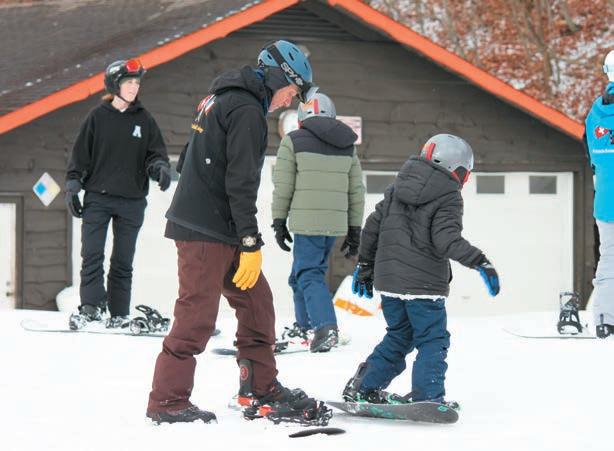

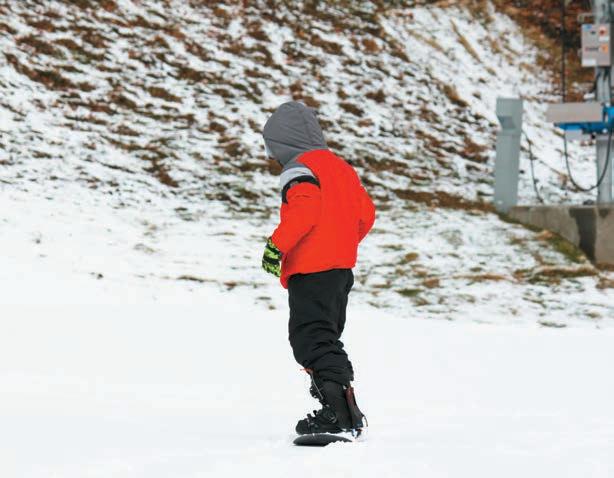 A young snowboarder receives expert tutelage at from an instructor of the French-Swiss Ski College.
Photo by Layne Hendrickson.
Benjamin can’t contain his excitement as the first few natural snowflakes of the season begin to fall during our interview. Photo by Layne Hendrickson.
A young snowboarder receives expert tutelage at from an instructor of the French-Swiss Ski College.
Photo by Layne Hendrickson.
Benjamin can’t contain his excitement as the first few natural snowflakes of the season begin to fall during our interview. Photo by Layne Hendrickson.
February 2024 HIGH COUNTRY MAGAZINE 51
A new snowboarder tries his skills on a beginner slope. Photo by Layne Hendrickson.
Spirit Ride The riding center with extraordinary horses and extraordinary children
STORY BY JAN TODD
Ten-year-old Levi can’t wait for Sundays to arrive. That’s when he goes to Spirit Ride Therapeutic Riding Center in Banner Elk. He grooms and saddles Patches — a black and white paint horse — and takes him for an afternoon ride.
“He looks forward to this all week,” said Levi’s mom, Shana.
Levi has been riding at the center since he was three years old. When he first arrived at Spirit Ride, he had trouble remaining calm and focused, and lacked the ability to follow two-step directions.

“His doctor explained to me that Levi would hear the first part of directions, and the second part would turn into blah blah blah,” Shana explained. “Coming to Spirit Ride is therapy — without him feeling like it is therapy. We work on building confidence, listening and following directions.”
Patty Adams, Spirit Ride owner and executive director of the non-profit organization, works with Levi’s teachers, parents and medical team to achieve goals defined in Levi’s individual education plan.
Since 2015, the riding center has provided therapeutic riding and equine assisted learning to children ages 3-17. All riders must be referred

goals using an experiential approach in a non-traditional setting,” Patty said. “These kids spend a lot of time in formal settings — whether a school classroom or a doctor’s office — receiving therapy, which is important, but not always fun. Out here, the kids are having a good time.”
Levi chose Patches because of the horse’s backstory. “He kept getting recycled,” Levi explained. “People kept buying and selling him.”
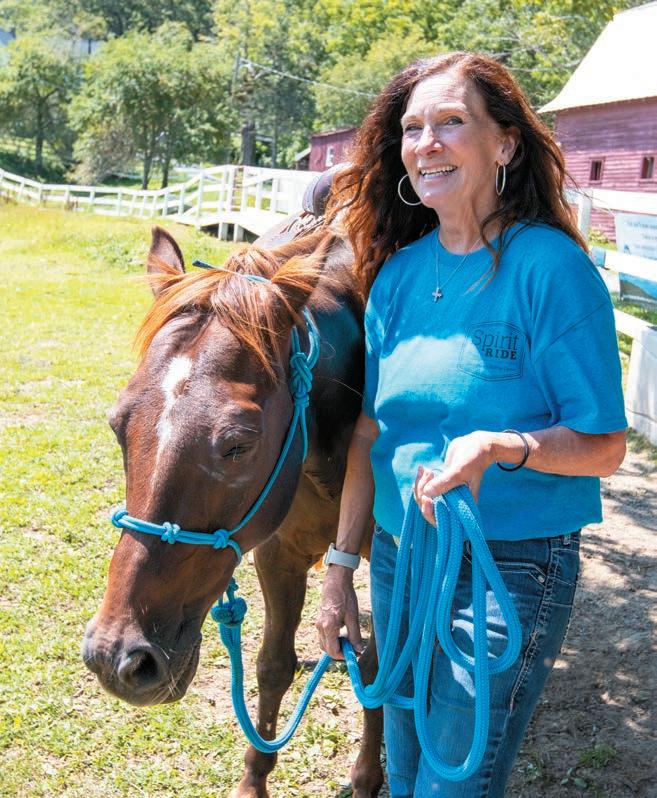 Patty Adams, Spirit Ride owner and executive director, has a degree in special education, specializing in teaching learning strategies. She received her Equine-Assisted Health Care certification in 2015 and became a board certified Equine Interaction Professional in Education in 2017. Photo by Jan Todd.
Patty Adams, Spirit Ride owner and executive director, has a degree in special education, specializing in teaching learning strategies. She received her Equine-Assisted Health Care certification in 2015 and became a board certified Equine Interaction Professional in Education in 2017. Photo by Jan Todd.
52 HIGH COUNTRY MAGAZINE February 2024
We provide support in achieving the child’s goals using an experiential approach in a non-traditional setting. These kids spend a lot of time in formal settings — whether a school classroom or a doctor’s office — receiving therapy, which is important, but not always fun. Out here,
the kids are having a good time.
- PATTY ADAMS
Patty described Patches as a horse with a calm attitude and kind heart, able to make his riders feel at ease. She knows a horse is right for the job by looking into his eyes.
“You can read the facial expression of a horse. I look for a horse that isn’t wide-eyed, but relaxed and sweet,” Patty said.
“The horse will mirror the emotions of the rider. When we have a rider who is pre-verbal and can’t express his own emotions, I can look at the horse and understand how the rider is feeling,” she added.
Patty emphasized the importance of being out in nature, with animals — not in a clinical setting. Patty, a board certified

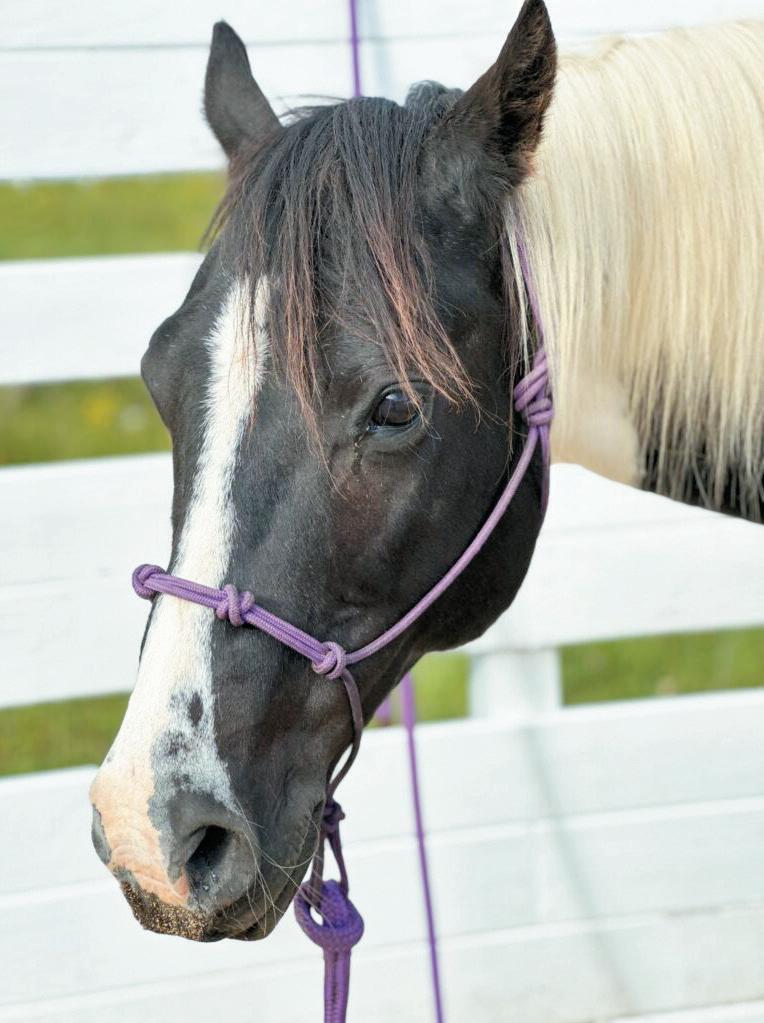
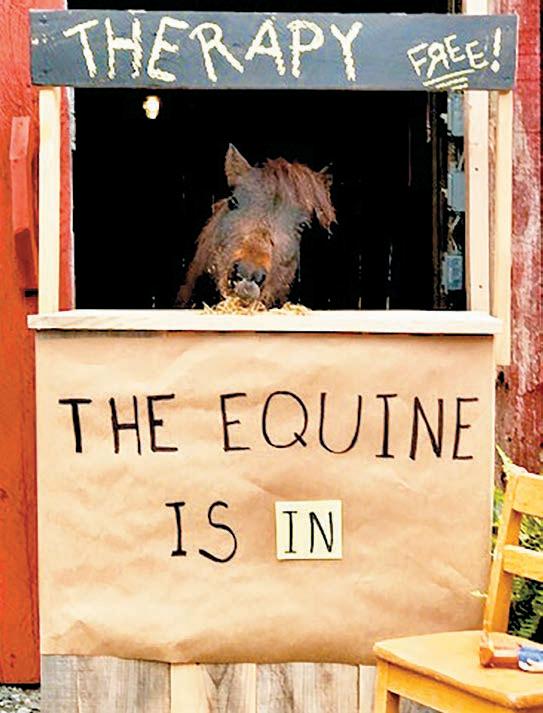 Horses are considered the “therapists” at Spirit Ride. “Horses are hard-wired for connection,” said Patty Adams, owner and executive director of Spirit Ride Therapeutic Riding Center. The bond between horse and rider help the children feel safe, loved and accepted. “Therapy starts when the riders connect with the horse,” Patty said. Illustration by Joelle Bornhill
Horses are considered the “therapists” at Spirit Ride. “Horses are hard-wired for connection,” said Patty Adams, owner and executive director of Spirit Ride Therapeutic Riding Center. The bond between horse and rider help the children feel safe, loved and accepted. “Therapy starts when the riders connect with the horse,” Patty said. Illustration by Joelle Bornhill
February 2024 HIGH COUNTRY MAGAZINE 53
Patches and Brogan are two of the therapists that provide services at Spirit Ride. Photos courtesy of Spirit Ride Therapeutic Riding Center.

54 HIGH COUNTRY MAGAZINE February 2024
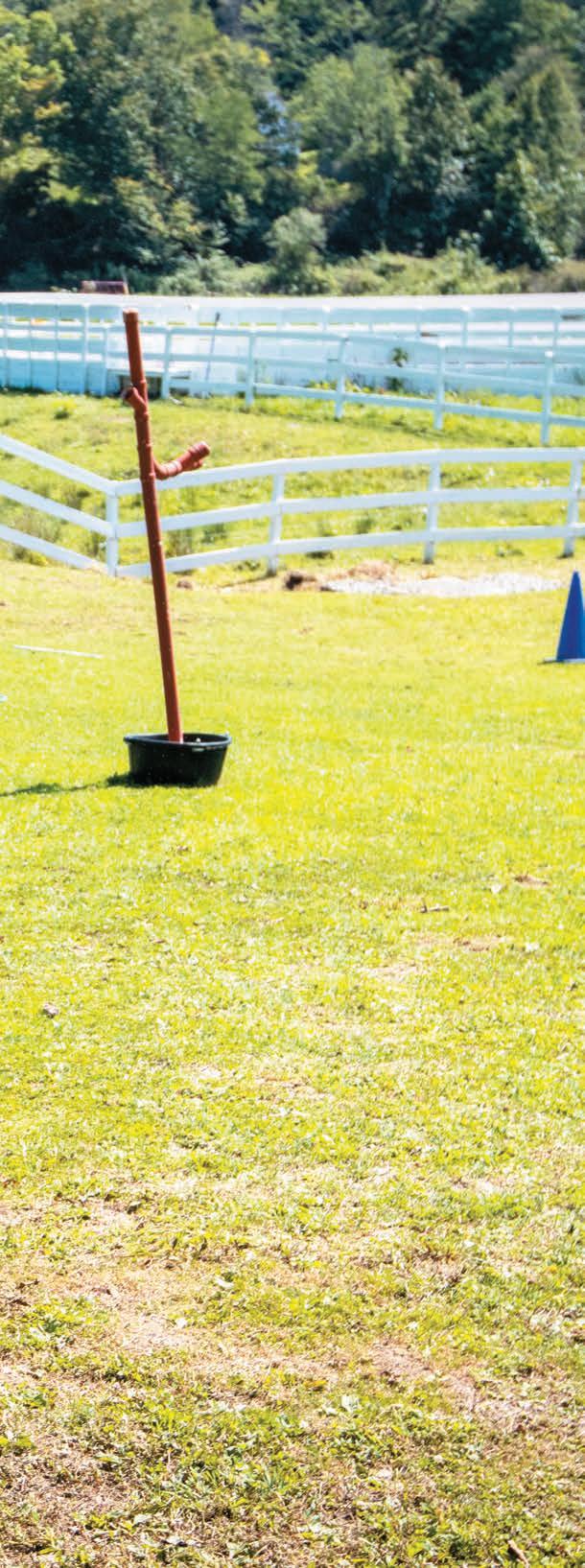

Other members of the trained team include two sidewalkers (one usually being the rider’s parent), a backspotter and a horse. All members of the team are volunteers, and there is no charge to the rider’s family. Spirit Ride is a 501©3 non-profit organization and relies on donations, grants and sponsorships to cover operating costs.
There is no other way for Luke to get the feeling of walking other than by riding a horse. Riding strengthens his muscles and stretches them.
- SASKIA SPOND
Spirit Ride serves children striving to overcome a wide array of challenges — from physical disabilities, to emotional issues brought about by toxic stress, to neurological and developmental disorders.
Third-grader Luke Spond, diagnosed with spastic cerebral palsy, has been riding at the center for more than five years.
During a riding session, Luke’s spine, joints and deep muscles are manipulated in a way that cannot be duplicated in a traditional physical or occupational setting, Patty explained. “The horse’s natural gait at a walk closely mimics a human’s natural gait — so the rider achieves hip movements during the passive exercise of simply riding the horse. The rider strengthens abdominal muscles and develops balance,” she said.
Levi leads Patches around the riding corral to warm up prior to their ride. The corral contains various props used in teaching and training — for instance the different colored hooks pictured. A child might be instructed to lead his horse to hang an object on the red hook, for example. Photo by Jan Todd
Equine Interaction Professional in Education with a degree in Special Education, leads the therapy team to provide private individualized lessons for children.
February 2024 HIGH COUNTRY MAGAZINE 55
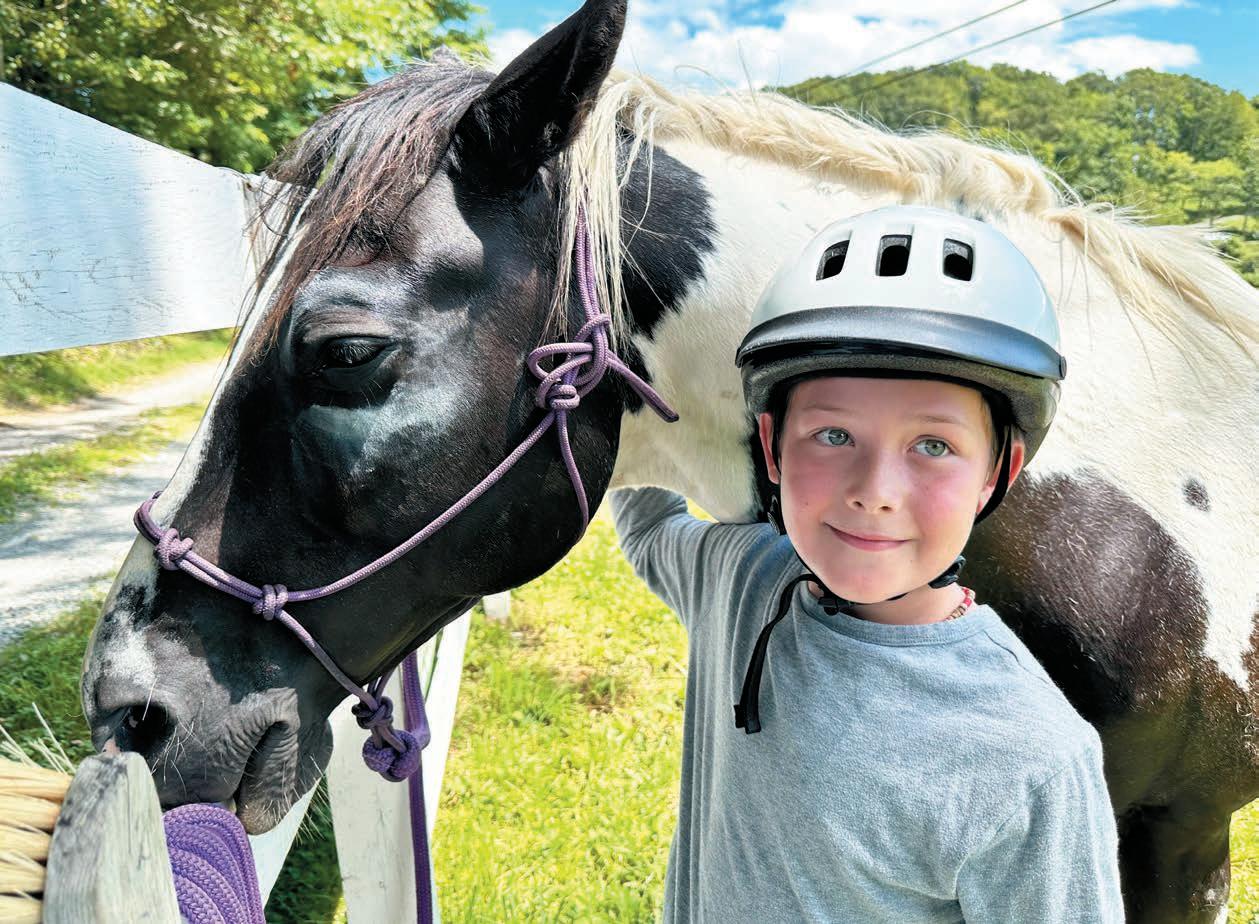
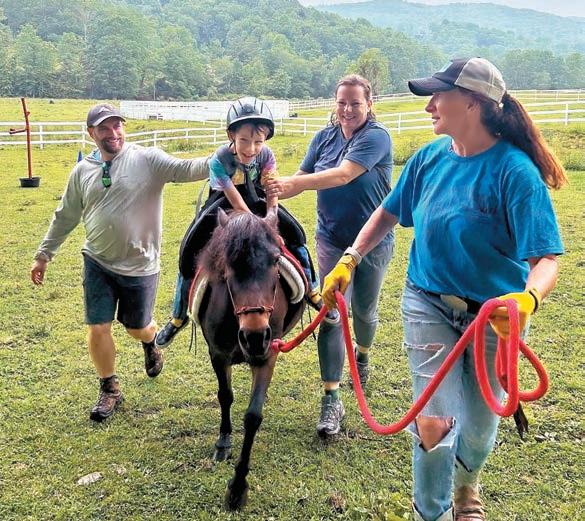
“There is no other way for Luke to get the feeling of walking other than by riding a horse,” said Saskia Spond, Luke’s mother. “Riding strengthens his muscles and stretches them.”
Luke starts his session by grooming and brushing “his” horse, Brogan — a rescue from the annual Grayson Highlands feral pony roundup. Brushing the horse helps Luke warm up his muscles and also connect with the horse.
“We want Luke to understand he needs to take care of Brogan, not just ask the horse to do things for him,” Saskia said.
In addition to the physical benefits of riding, Luke works on educational curriculum goals defined by his teachers at school. He rides Brogan on the center’s sensory trail, where the team stops along the way for challenges involving numbers and colors. When Luke is able to solve a problem by looking in the direction of the correct answer, he earns a “victory lap” — a ride along a wooded path — accented by celebratory cheers from his team.
Patty and her team modify the challenges to fit each child’s specific needs, to provide an opportunity for learning and personal growth — whether it be building self-esteem, learning to set boundaries, developing appropriate social
Ten-year-old Levi with Patches, a black and white paint horse. Levi loves animals and hopes to be a veterinarian when he grows up. “But if that doesn’t work out, I’ll just be a gator wrestler,” he said. Photo submitted.
56 HIGH COUNTRY MAGAZINE February 2024
Therapeutic riding programs offer children a fun, outdoor experience — connecting with animals and nature while receiving physical, mental and emotional benefits. Luke’s smile says it all! Photo submitted
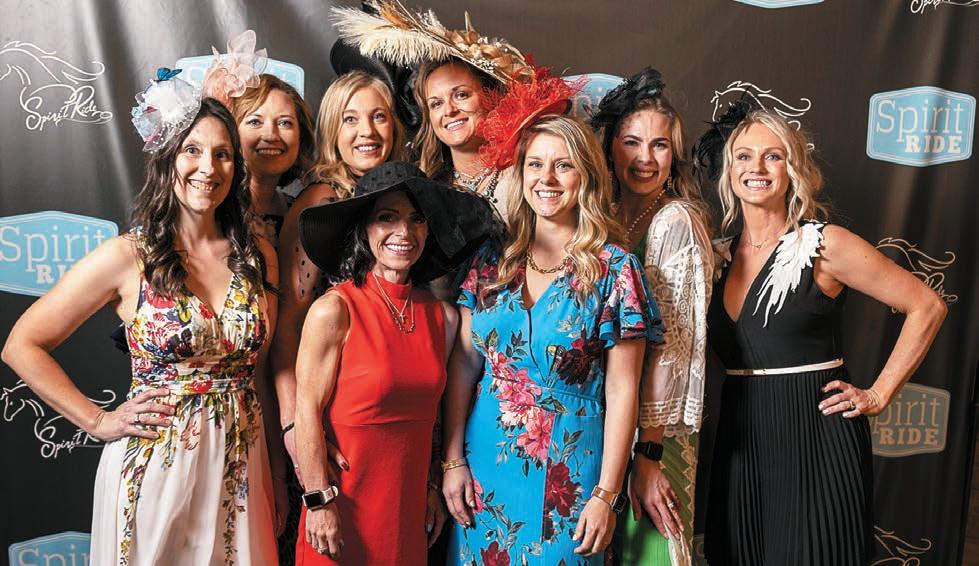
Derby Party for the Cause
Spirit Ride provides Equine Assisted Services to children at no cost to the families. While the center accepts donations anytime via their website, an annual Kentucky Derby themed fundraiser gala is the primary generator of funds for its operating costs.
True to the Derby tradition, attendees wear beautifully designed hats, seersucker suits and fancy bowties. Derby-themed food, music and dancing, an auction and — of course — a Derby viewing party
ensure the guests have a great time while supporting an excellent cause.
This year’s Kentucky Derby Fundraiser will take place on Saturday, May 4th and will be hosted by the event’s Corporate Sponsor, Hidden Hills Equestrian at their beautiful facility in Valle Crucis.
Tickets go on sale the first day of Disabilities Awareness month, March 1, 2024. Check the website www.spiritridenc.org for more details. t
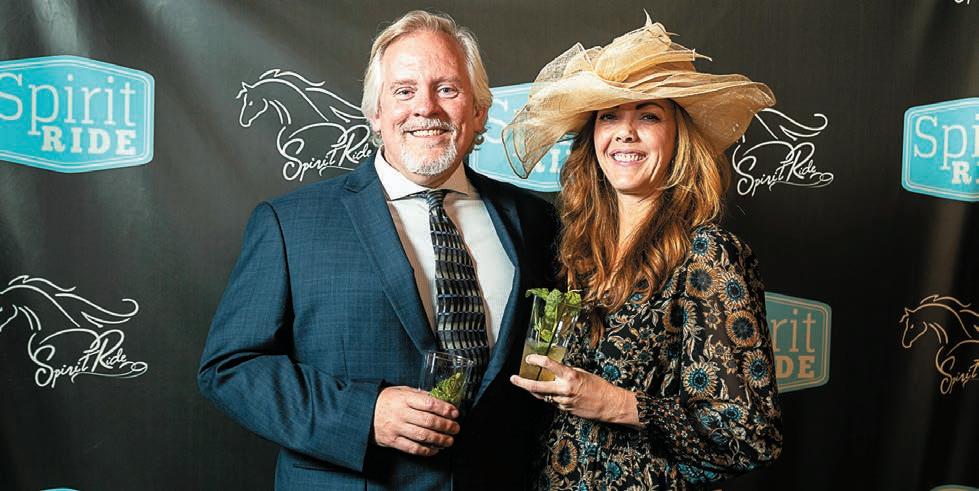 A group called “Team Jake” — named for one of the children who rides at Spirit Ride — gather at the 2022 Derby party to support Spirit Ride.
Pictured from left to right are: (front row) Lacey Costner, Crystal Townsend, Summer Parlier; and (back row) Kelsey Watson, Angela Jenkins,
Lina Kate Lewis, Bridgett Clark, and Tasha Turbyfill. Lacey Costner is Jake's mom. Photo by Cindy McEnery Photography
A group called “Team Jake” — named for one of the children who rides at Spirit Ride — gather at the 2022 Derby party to support Spirit Ride.
Pictured from left to right are: (front row) Lacey Costner, Crystal Townsend, Summer Parlier; and (back row) Kelsey Watson, Angela Jenkins,
Lina Kate Lewis, Bridgett Clark, and Tasha Turbyfill. Lacey Costner is Jake's mom. Photo by Cindy McEnery Photography
February 2024 HIGH COUNTRY MAGAZINE 57
Mike and Elizabeth Jasper attending the 2022 Spirit Ride Derby party. Elizabeth is an occupational therapist who advises the team at Spirit Ride. Photo by Cindy McEnery Photography

The results we achieve can be pretty magical, but behind the magic is science. It takes a lot of education, training and experience to do what we do here. Twenty years ago, this was considered an alternative type therapy, but in recent years there has been a lot more research and scientific backing behind our methods.
- PATTY ADAMS
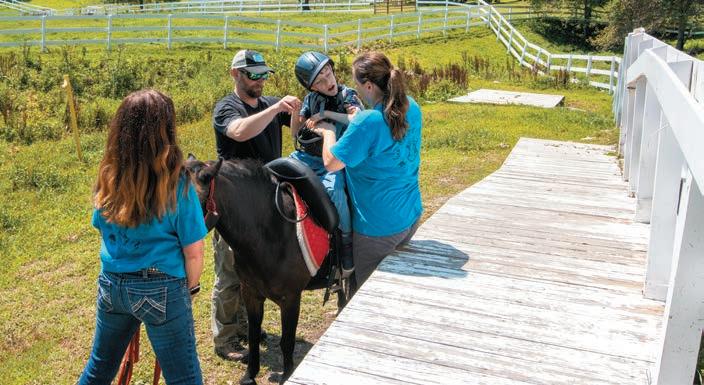

interaction, or achievement of cognitive or physical goals.
Sophia started sessions with Spirit Ride in 2021, after moving from Florida during the Covid pandemic.
“She has always struggled with change,” Sophia’s mother, Stephanie, shared. Therapeutic Riding has helped Sophia deal with anxiety, in addition to providing physical therapy to help develop core strength and proper walking.
“This is a “yes environment” for Sophia,” Stephanie said. “Riding helps her feel like she is in control and builds her self-confidence. Working with animals has helped her come out of her shell and has provided an outlet for her compassion. This is her safe environment.”
Patty said, “The results we achieve can be pretty magical, but behind the magic is science. It takes a lot of education, training and experience to do what we do here. Twenty years ago, this was considered an alternative type therapy, but in recent years there has been a lot more research and scientific backing behind our methods.”
“Riders on the Autism Spectrum may learn how to navigate the world by using the horse as a communication filter. Riders
58 HIGH COUNTRY MAGAZINE February 2024
Mark and Saskia Spond help their son, Luke, into a specially designed saddle prior to his ride. Spirit Ride has a wheelchair accessible mounting platform to ease the process of getting onto the horse. Photo by Jan Todd.
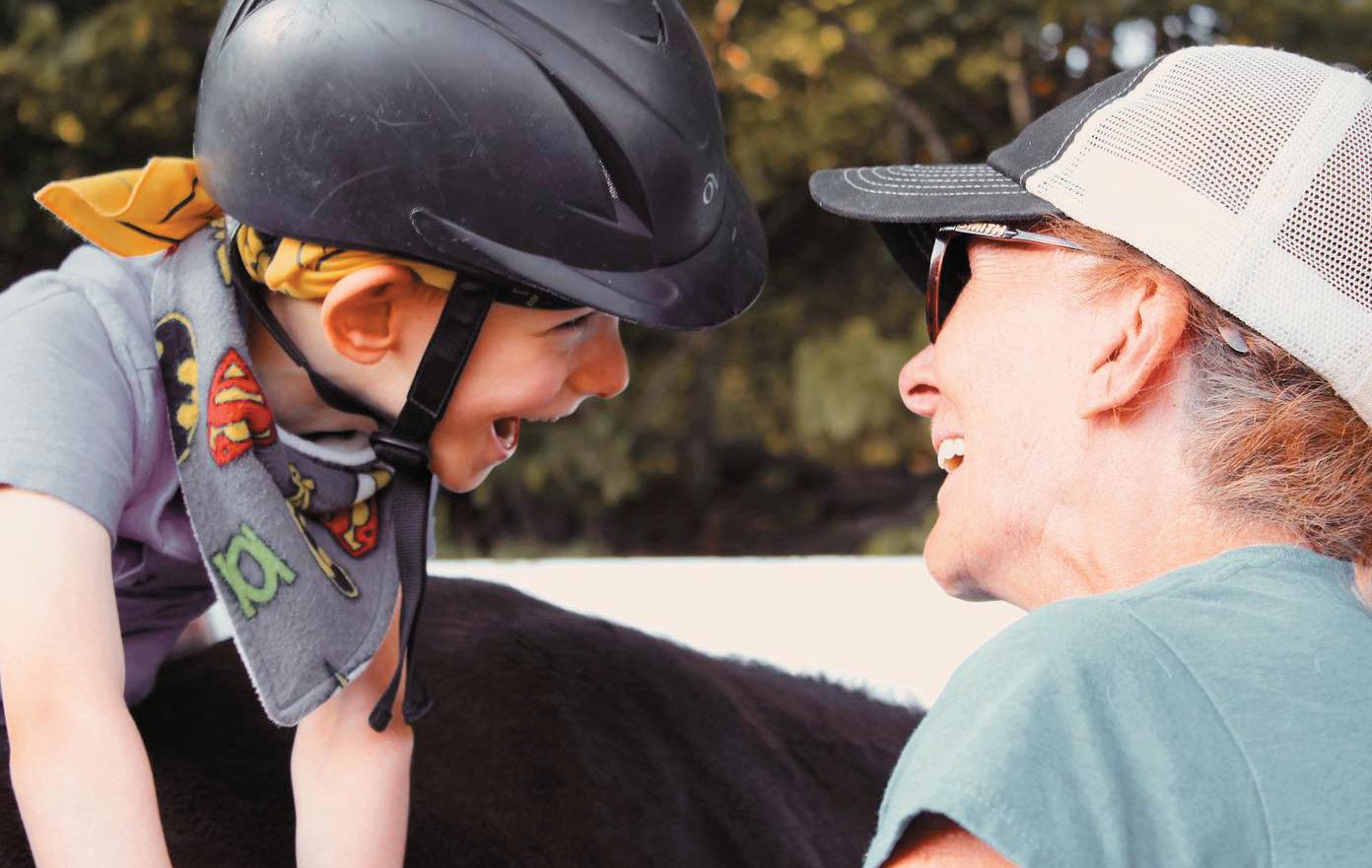
with physical challenges may use the gait of the horse to increase the steadiness of their own gait. Riders who have behavioral disorders may respond to the horse not only as an incentive but as a living and breathing biofeedback mechanism. And riders struggling with emotional issues brought about by toxic stress are taught by their equine partner that they are valued and cared for in return for their honesty and authenticity,” Patty said.
A heart to help others
Patty grew up in Florida, and said she always had a love for horses and an interest in helping other people. While attending the University of North Florida, studying music and dance, she had a friend who was hearing impaired. To better communicate with her friend, Patty became fluent in American Sign Language (ASL) and became a certified instructor.
As part of her music studies, Patty attended a concert at a school for the deaf and blind. “As I watched the students singing and dancing, I was so inspired that I changed my major to special education,” she said.
In addition to teaching exceptional students, Patty taught and coached dance teams at the high school and collegiate level. She continues to be involved in the “dance world” during Spirit Ride’s off-season, she said.
Her experience in choreography and dance helps her in working with the riders at Spirit Ride. She said, “My
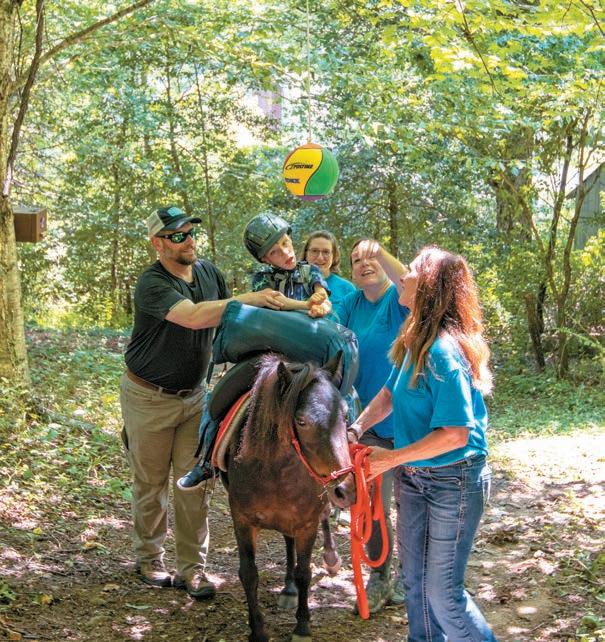 Hard work, dedication, and compassion is what Executive Director, Patty Adams, has shown while creating the Spirit Ride Community.
Photo courtesy of Spirit Ride Therapeutic Riding Center.
A sensory trail has been equipped with learning stations and props to engage and train the riders. Luke is encouraged to lift his head to see the multi-colored hanging ball, and with assistance, stretch and touch it as he rides by. Photo by Jan Todd
Hard work, dedication, and compassion is what Executive Director, Patty Adams, has shown while creating the Spirit Ride Community.
Photo courtesy of Spirit Ride Therapeutic Riding Center.
A sensory trail has been equipped with learning stations and props to engage and train the riders. Luke is encouraged to lift his head to see the multi-colored hanging ball, and with assistance, stretch and touch it as he rides by. Photo by Jan Todd
February 2024 HIGH COUNTRY MAGAZINE 59

60 HIGH COUNTRY MAGAZINE February 2024
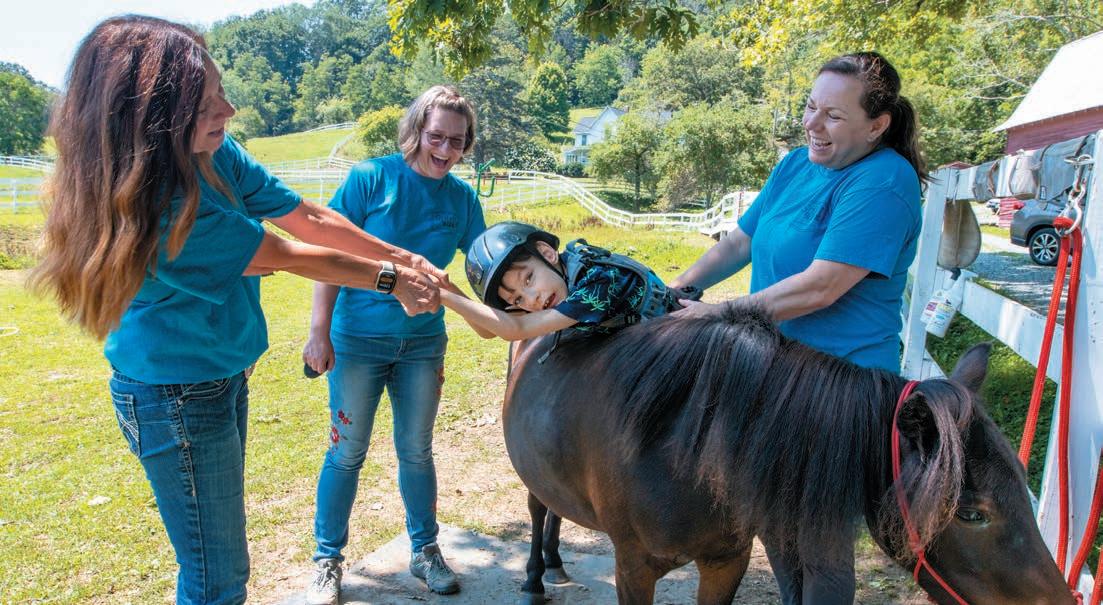
When movement is occurring, the language part of the brain is stimulated. When they get on the back of a horse, some of our riders just start chattering. Sometimes it isn’t understandable, but when this particular rider got up in the saddle, he started saying, “Mommy, I love you, I love you, I love you.” His mother had never heard that before — and it is something I’ll remember forever.
- PATTY ADAMS
training in movement shows up here all the time, determining how to manipulate the body in the best way.”
Patty and her husband, Craig, began vacationing in the mountains in the mid-1980s. Whether in Florida or in the mountains, she found ways to be around horses. She volunteered at a therapeutic riding center in Florida, and for the Blazing Saddles therapeutic riding program in the Blowing Rock, which has since closed.
There was “nothing scary” about opening Spirit Ride, Patty said. “I knew it was needed, and it was something I needed to do.”
Now in its ninth year of operation, Patty said she has witnessed many
amazing moments between the riders and their horses. She shared one story about a seven-year-old who was pre-verbal.
“When movement is occurring, the language part of the brain is stimulated,” Patty said. “When they get on the back of a horse, some of our riders just start chattering. Sometimes it isn’t understandable, but when this particular rider got up in the saddle, he started saying, “Mommy, I love you, I love you, I love you.” His mother had never heard that before — and it is something I’ll remember forever.” t
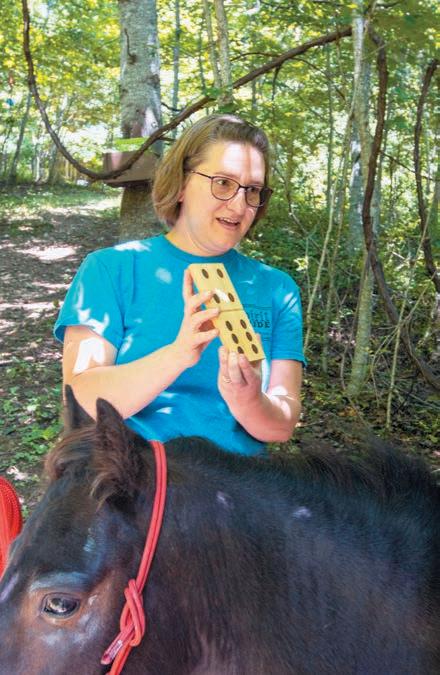 Top: Patty Adams (left) helps Luke Spond stretch out on the horse’s back prior to his ride. Luke’s mother, Saskia (right), lends a steadying hand while volunteer Missy Thomas looks on. Photo by Jan Todd.
Top: Patty Adams (left) helps Luke Spond stretch out on the horse’s back prior to his ride. Luke’s mother, Saskia (right), lends a steadying hand while volunteer Missy Thomas looks on. Photo by Jan Todd.
February 2024 HIGH COUNTRY MAGAZINE 61
Missy Thomas is one of the regular volunteers at Spirit Ride Therapeutic Riding Center. Here, she displays a number puzzle from one of the learning stations on the sensory trail. Volunteer opportunities at the farm include sidewalkers, horse groomers, occasional maintenance workers and fundraising helpers. Photo by Jan Todd
Local Funeral Director, Barney Hampton, Recognized After 60-Plus Years of Service
STORY BY SHERRIE NORRIS

For more than 60 years, Boone native Barney Hampton has served thousands of families in their darkest hours, helping to guide them through the pain and sorrow of losing a loved one.
Devoting the majority of his life to serving others, Hampton was recognized earlier in 2023 for his dedicated career as one of


the longest-serving funeral directors and embalmers in North Carolina.
It was during the May 2023 convention of NC Funeral Directors Association that Hampton was honored by the organization for his 60-plus years of licensed service.
As founder, owner and president of Hampton Funeral and Cremation Service of Boone, Hampton considers it an honor to have served his community for all those years, admitting that his career choice is certainly a calling and not just for everyone. However, he was intrigued, even as a youngster accompanying his mother to local funerals, and decided that’s what he wanted to do.
“I never looked back,” he said.
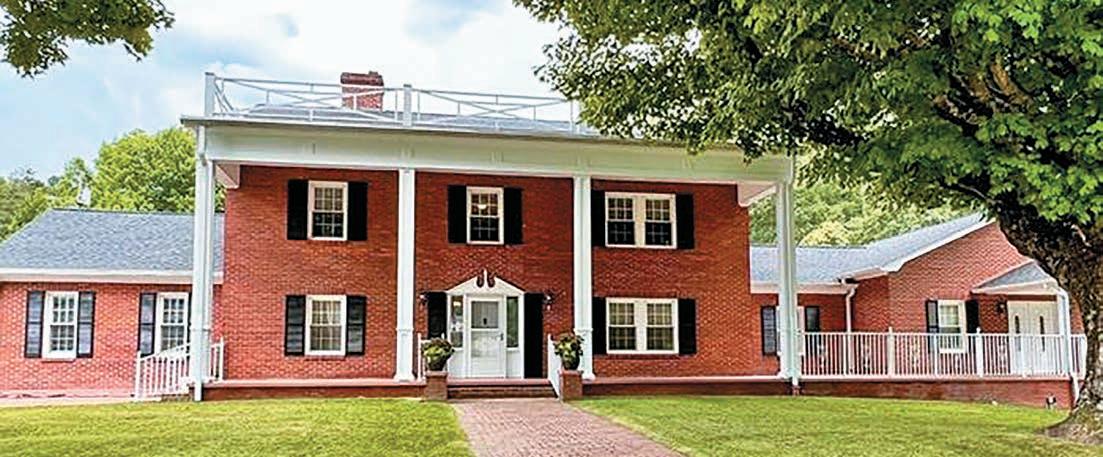 Countless people have stood in lengthy lines through the years where Barney and Tommie Hamtpon are pictured outside of their funeral home in Boone. They and their staff have served an estimated 10,000 families during their 60-plus years in business. Photo by Sherrie Norris.
Hampton Funeral and Cremation Service estimates they have been able to assist about 10,000 families in the nearly 50 years they have been in business.
Photo courtesy of Hampton Funeral and Cremation Service
Countless people have stood in lengthy lines through the years where Barney and Tommie Hamtpon are pictured outside of their funeral home in Boone. They and their staff have served an estimated 10,000 families during their 60-plus years in business. Photo by Sherrie Norris.
Hampton Funeral and Cremation Service estimates they have been able to assist about 10,000 families in the nearly 50 years they have been in business.
Photo courtesy of Hampton Funeral and Cremation Service
62 HIGH COUNTRY MAGAZINE February 2024
At 17, and a junior in high school, he began working nights at Reins-Sturdivant Funeral Home in Boone; by age 18, his interest escalated, as did his skills. He was soon assisting with funeral services, in addition to answering ambulance calls, which also fell to the responsibility of the funeral home. “After graduating from high school, I did a two-year internship at Reins Sturdivant, which was required by the state, prior to entering mortuary college, which I did in 1961,” Hampton shared. “I graduated in the spring of ’62 from Cincinnati College of Mortuary Science, came back to Boone and worked for Reins Sturdivant. Richard Kelley and Council Cook were owners at the time.” Dually licensed as both funeral director and embalmer, Hampton managed the funeral home from 1968-1974. “I realized that Boone needed a second choice for funeral services, so with encouragement from the community, on June 1, 1974, my wife, Tommie, and I decided to go out on our own and establish our funeral service. We obtained the property at 683 Blowing Rock Road, in November 1974.”
And, as the saying goes, the rest is history.
The Life and Times of Barney Hampton
Barney Hampton was born February 11, 1939, in the Bamboo community, the youngest of 10 children to parents John Monroe Hampton and Lela Greene Hampton.
“There were six of us boys and four girls,” he said. “We grew up on a farm and had cows, chickens and hogs; we raised all of our food and sold a lot of our products to the markets.”
Hampton attended Bamboo school through the sixth grade, until it was consolidated with Parkway School. “I went there in the seventh and eighth grades, and then onto Appalachian High School where I graduated.”
The older five of the Hampton children were grown and out working by the time the younger ones came along.
“The last five of us stuck pretty close together, and as the youngest of all, I got a lot of attention from my older siblings,” he recalled. “My mother use to introduce me as her baby, which I didn’t like to hear at that time, but later years, I loved it.”
1
I realized that Boone needed a second choice for funeral services, so with encouragement from the community, on June 1, 1974, my wife, Tommie, and I decided to go out on our own and establish our funeral service. We obtained the property
at 683 Blowing Rock Road, in November 1974.
- BARNEY HAMPTON
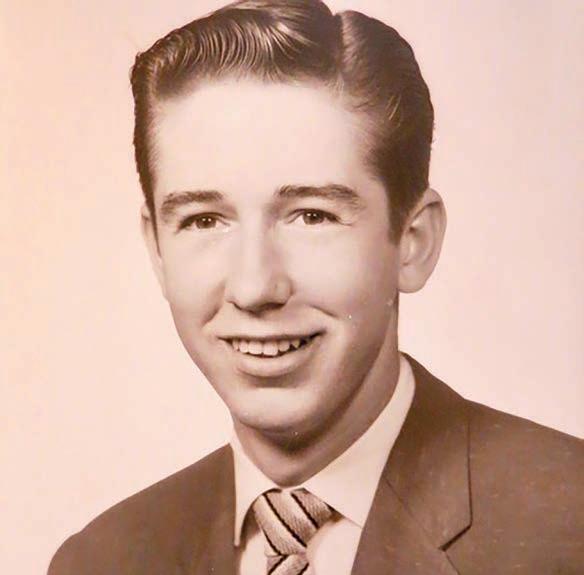
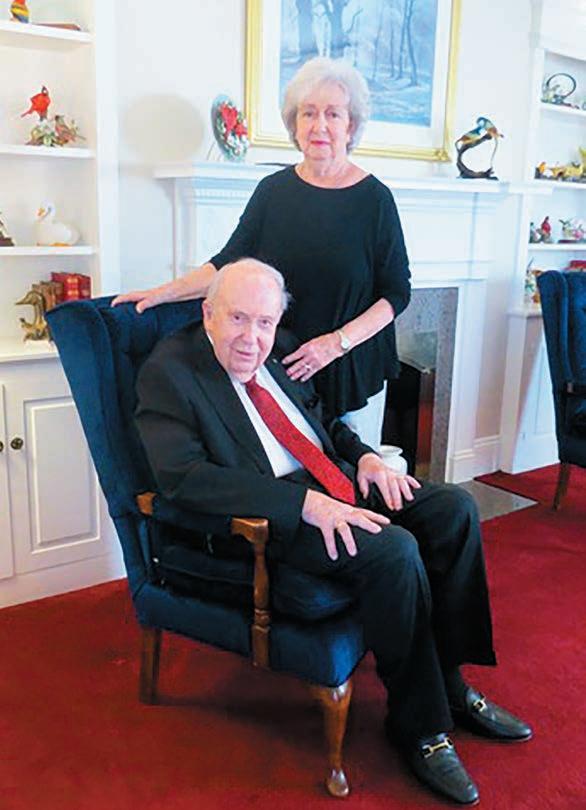 A young Barney Hampton made an important career choice while in high school and has never looked back. Photo submitted.
A young Barney Hampton made an important career choice while in high school and has never looked back. Photo submitted.
February 2024 HIGH COUNTRY MAGAZINE 63
Barney and Tommie Hampton agree that their success as providers of a much-needed community service would not be possible without their large network of family, friends, associates, and thousands of families who have turned to them in their darkest hours. Photo by Sherrie Norris.
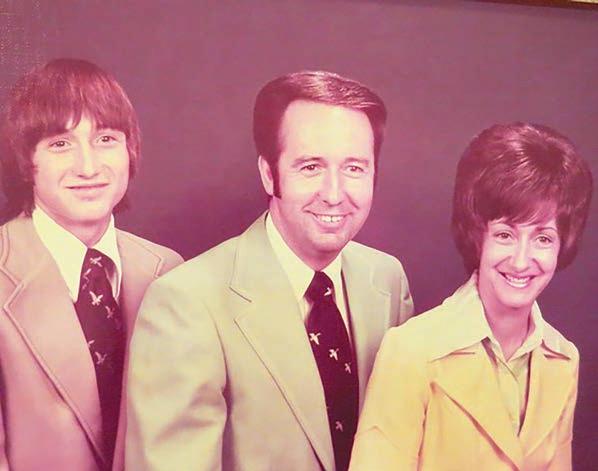

His father was a farmer and also owned a country store before Barney was born. The family moved to Somerset, Kentucky for about four years, where they grew tobacco and where two of the children were born.
“They came back to Watauga County and three more of us were born here,” he said.
Hampton remembers well how his mother lovingly cared for her family. “She was wonderful homemaker and cook, and always had big meals for us and anyone helping on the farm.”
With deep roots in eastern Watauga County, Hampton’s ancestors called the area home for several generations. “It’s where my grandparents grew up and
eventually divided up their farm. My siblings and many cousins all grew up in the same community and most of us made our homes in the area.”
Hampton’s brother opened a restaurant called Shorty’s Truck Stop, located beside the Trailway Laundry.
“When I was about 11 or 12, I started working there as a curb hop and later as



mail@precisionprintinggroup.com www.precisionprintinggroup.com Printing & Signs for Printing and Signs Service in Boone and Wilkesboro 990-5060 Fax: (336) 990-5063 Products / Service / Design Benny Award Printing Industry ofAmerica order today! - 828.265.0004 Hats • Pens • Shirts • Cups • Bags 828.265.0004 Things to do: Call us with your order today! Call Precision for a quote - 828.265.0004 Hats • Pens • Shirts Call Precision for a quote - 828.265.0004 265-0004 Fax: (828) 265-0174 1302 Blowing Rock Rd. Boone, NC 28607 Packing Moving Cleaning After the Move UHAUL Rentals Auto Transport Owned and Operated by PJ and Liz Ollis and Josh Arrowood and Rachel Harless (336)990-9480 dinosden7@gmail.com . . . . Precision Printing & Signs 1613 Industrial Drive Wilkesboro, NC 28697 (828) 265-0004 PRINTING AND SIGNS Design / Mailing Digital / Large Format mail@precisionprintinggroup.com Owned and Operated by PJ and Liz Ollis 1613 Industrial Drive Wilkesboro, NC 28697 . The Hampton family — Gregg, Barney and Tommie — is pictured here in the 1970s as they were becoming known and respected in their funeral service business. Photo submitted. Hampton
64 HIGH COUNTRY MAGAZINE February 2024
admits the recognition he received for his 60-plus years of service to his hometown is something he will always cherish. Photo by Sherrie Norris.
waiter in the restaurant,” he said. “Around 16, I became a cook. Eventually, two of our sisters and their husbands purchased Shorty’s and ran it for a number of years. I worked for them when I was in high school, before I started at the funeral home.”
On May 11, 1958, Barney and the lovely Delores “Tommie” Storie were married.
The daughter of Carnie Harold and Lena Storie, Tommie , too, had grown up on a farm; she attended school in Blowing Rock and later, Clevenger Business College in Lenoir.
By the mid 60s, while Barney was managing the funeral home, the couple owned Boone Flower Shop; Tommie ran it until 1974 when they sold it and went fulltime in the funeral service.
In the meantime, in 1963, they also established Hampton Monument, an additional service they still offer, and Barney was appointed the Watauga County coroner.
“As we began to look for a location that we could convert into a funeral home, the Jim Winkler family property became available,” Hampton recalled. “We leased it at first, and then purchased it in 1980. We had converted the first floor to Hampton Funeral Service Inc., on Nov. 9, 1974.”

The couple also converted the upstairs into living quarters, residing there for 49 years. “You could say, we were always at work,” Hampton added.
Hampton Funeral Home Offers A Second Choice
Barney and Tommie Hampton received a lot of support and encouragement from families in the area. “We really made a lot of friends and have served a lot of people through the years,” he shared. Hampton estimates they have been able to assist about 10,000 families in the nearly 50 years they have been in business.
Blessed with the birth of their only child, a son, Gregg in 1960, the couple loved watching him grow up and follow in his father’s footsteps. “He worked for us for nearly 40 years, even in college and he also became licensed; he was vice-president at the time of his unexpected death,” his father shared.
Gregg died from injuries sustained in a tragic accident on September 5, 2020, at the age of 61. Understandably, it is still a very painful topic of conversation for his parents.
“Losing Gregg was the hardest thing I have ever been through in my life,” said Tommie. “I’ve lost my parents, a sister and others close to me, but there’s nothing like losing your own child. It certainly gave me a
different perspective in how I relate to the families we serve. I’ve often said that time helps to heal the hurt, but I just can’t say that anymore. I can’t tell them that things will get easier. I’ll never get over it.”
Mornings and nights are hardest, she said, especially Saturdays. “He came by to visit on that last Saturday morning and we had such a wonderful time, laughing and having our coffee together

February 2024 HIGH COUNTRY MAGAZINE 65
During the 2023 convention of the NC Funeral Directors Association earlier this year, Barney Hampton, at right, gratefully accepts a plaque from Garland Smith, president of the association, for his 60-plus years as a licensed funeral director and embalmer in the state of North Carolina. Photo provided by the NCFDA.
like we always did. We both miss him terribly.”
Not only was Gregg a huge asset to the family business, but he was also known and loved in many circles. He had attended Lees McRae College and Appalachian State University, where he earned a degree in business. Gregg was a member of Lees McRae’s ski racing team and attended Stratton Mountain Ski Academy and Red Lodge Montana Ski School.
“He loved life and especially loved time spent with his three daughters, their daughters and other youngsters that he coached in skiing and soccer,” his mother described.
At the same time, the Hamptons are very grateful for the “gifts” that Gregg left behind. “We are so proud of all our girls,” Tommie said. “Gregg’s three daughters, Stephanie, Samantha and Caroline, and we have five great-granddaughters, Charley, Rilan, Harper, Sophia and Penelope. We love them all so much.”
The Hamptons traveled, as schedules allowed in their earlier years, and in particular, to join and support Gregg on his ski trips and during competition in Colorado and Vermont. They also enjoyed attending Appalachian State football games.
“We just had to take one day at a time, really, and didn’t have a lot of time to pursue other interests. We have spent most of our time here, working, but we’ve loved being here serving our community the best we can,” Tommie said.
While continuing to work full-time, and in the office daily, the Hamptons are excited about the construction of their new home — and hope to occupy it by Christmas.
“I don’t think of retiring,” Barney said. “I might slow down when I get old enough, but I’m not ready, yet, even at 84.”
He continued, “After Greg’s death, we had to lean on our staff to step up and operate the funeral service business. I named
Kenny Newberry operations manager, to oversee the day-today operations. Christina Millsaps, our fulltime administrative officer and bookkeeper, takes care of our accounting, along with many other duties, and has been very instrumental in the business. Cliff Sudderth, also a licensed funeral director and embalmer, is in charge of all (final) preparations. Kenny’s wife, Rhonda, came on board as administrative assistant to help with clerical and technical tasks.
“We are beyond grateful for all of our staff, both fulltime and part-time, for their commitment to serving and caring for families,” Barney shared.
Civic and Community Involvement
As business owners, Barney Hampton serves as president of Hampton Funeral and Cremation Services, Inc., Tommie as secretary/treasurer, and for many years, Gregg served as vicepresident.
The Hamptons have stayed active in their community, but primarily, Barney has filled numerous seats in civic and community organizations: United Way, Boone Civitan Club, Boone Rotary Club (45 years with 30 years of perfect weekly attendance!)
Barney grew up as a member of Mount Vernon Baptist Church, and Tommie at Laurel Fork; after they were married, Barney joined Laurel Fork, where they have both belonged and served for many years.
Among his career highlights, Hampton was featured in a

66 HIGH COUNTRY MAGAZINE February 2024
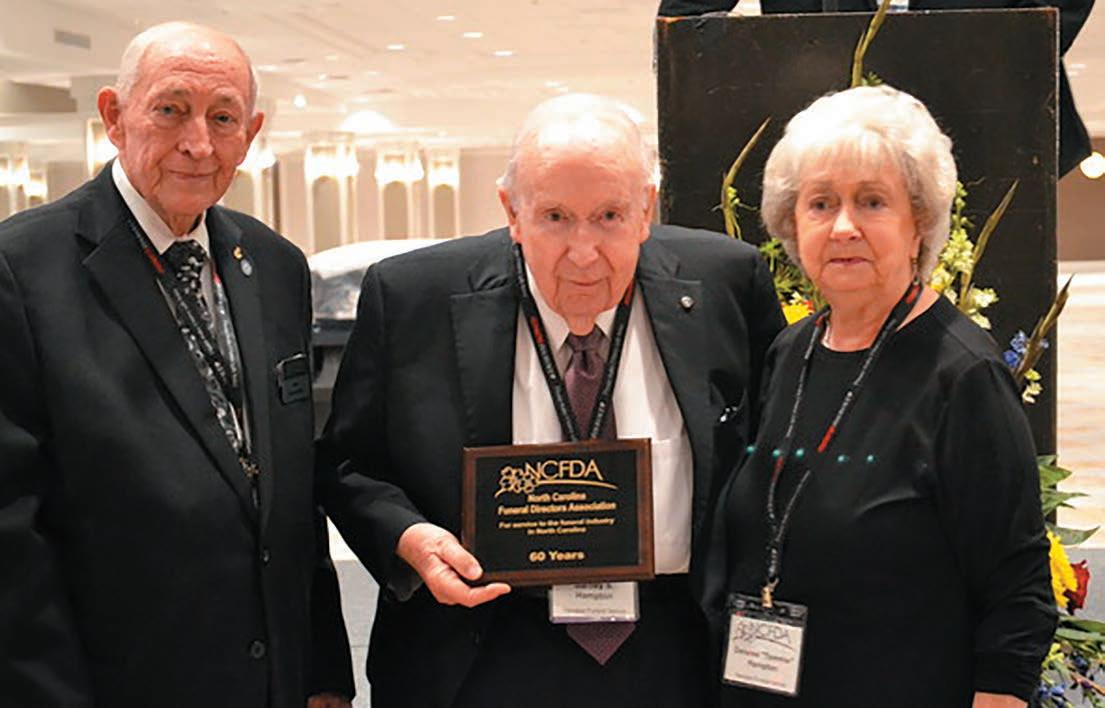
I don’t think of retiring. I might slow down when I get old enough, but I’m not ready, yet, even at 84.
- BARNEY HAMPTON
textbook at the Cincinnati Mortuary College for his highly professional skill, and in particular that of restorative art.
“I’ve always taken a lot of pride in the way we care for our clients and their loved ones,” he surmised.
And they have also employed and trained others to work in the funeral home business, some who have gone on to own their own funeral homes.
Hampton’s, as a whole, has been recognized on various levels through the years, including Best of the Best, sponsored by Watauga Democrat.
They were invited to participate in and assist with two locally-filmed movies, including The Winter People and The Green Mile. Both opportunities were enjoyable and insightful, the Hampton admitted , especially getting to meet and spend time on location with stars like

February 2024 HIGH COUNTRY MAGAZINE 67
At left, Garland Smith, longtime friend of the Hamptons, former pastor in Watauga County, and current president of the North Carolina Funeral Directors Association, is pictured with Barney Hampton and his wife, Tommie, during the 2023 annual convention of the NCFDA. Photo provided by the NCFDA.

Kurt Russell and Kelly McGillis, as well as other actors and production crews for both movies.
And, most recently, the honor bestowed upon Barney by the NC Funeral Directors Association — and the plaque he received — was something he will always cherish. “It was quite a surprise to me, but my family knew about it.”
Current President of the NCFDA, Garland Smith, shared with us, “I was honored to make that presentation in Winston Salem in April of this year. I have known Barney Hampton since May 1964 when I was assigned, as a young, new pastor, to several of the churches in Boone, as part of the United Methodist Conference. At the first funeral that I helped conduct, I had the privilege to
meet the owners of Reins Sturdivant – and on their staff were two fine young men, Barney Hampton and Johnnie Austin; I got to know them very well through the years, as well as their wives.”
About Hampton, Smith continued, “He was one of the most compassionate, young funeral directors that I have ever met. He always carried himself with the dignity and respect that our profession needs; over the years, he proved himself well to the people of Watauga County. I became great friends with him and Tommie, and that friendship was never forgotten. I stepped from the back of the pulpit as a pastor to the front as a funeral director, which I have done for 58 years. Now, as president of the association — the oldest one (at 85) ever installed in 137 years — it was my privilege to welcome Barney to the elite group of funeral directors in North Carolina.”
Through the Years
The Hamptons admit that funeral service, in general, has experienced dramatic changes in recent years. “The trends have definitely changed,” Barney said, citing the COVID pandemic for the majority of same.
Full traditional services once held in the churches have become less formal in many situations, he said. “We are seeing more cremations and memorial services held here in our chapel, or at the gravesite,
rather than in churches.”
But something that has not changed, Barney and Tommie say, is the care for the families they serve —from the time of death until far past the service.
“There are many different circumstances and levels of grief that families are faced with, “ Barney explained. “Regardless of the need, religious beliefs or the situation, we treat every family with the same amount of dignity and respect that they deserve and we appreciate the confidence that they place in us. We are there for them from the beginning, through the service and for any follow-up assistance. We want them to know they are not alone through their time of loss.”
And, the Hamptons are quick to acknowledge that much of their success hinges upon the support and involvement of many others.
“We have a large network, and have always been appreciative of the assistance we receive from local clergy, florists, veteran’s organizations and especially, law enforcement. We couldn’t do without them for funeral escorts and traffic control.”
And, they are very grateful for the confidence placed in them by the many families they have served through the years.
In retrospect, Barney and Tommie Hampton are thankful for all who have been part of their success story. As ones who seek no public acclaim, they were reluctant to allow us to do this story, but we finally convinced them that they deserve to be commended for 60-plus years of serving their community.”
Hampton Funeral Service and Cremation is located at 683 Blowing Rock Rd. in Boone.
For more information, call (828) 2647100 or visit www.hamptonfuneralnc. com. t
There are many different circumstances and levels of grief that families are faced with. Regardless of the need, religious beliefs or the situation, we treat every family with the same amount of dignity and respect that they deserve and we appreciate the confidence that they place in us. We are there for them from the beginning, through the service and for any follow-up assistance. We want them to know they are not alone through their time of loss.
- BARNEY HAMPTON
A familiar portrait of Barney and Tommie Hampton has been seen by many through the years who have entered the doors of Hampton Funeral and Cremation Service in Boone. Photo by Sherrie Norris.
68 HIGH COUNTRY MAGAZINE February 2024

Spreading Love with a Taste of Heaven Toe Valley Soup Ministry
STORY BY TIM GARDNER
There are various outreach ministries in the North Carolina High Country founded to assist those in need. One that serves Avery and Mitchell counties and is entering its sixteenth year of existence in 2024 is the Toe Valley Soup Ministry.

The weekly soup ministry began in January 2009 at Mount Zion United Methodist Church (recently renamed Mount Zion Community Global Methodist Church), located in the Kalmia Community in the far southern section of Avery County, near the Mitchell County line. It was joined by Pine Grove and Vance Memorial United Methodist Churches, in nearby communities, Ingalls and Plumtree, respectively, a short time later. Vance Memorial Methodist Church has since dissolved. This ministry was originally named “Soup’s On.”
The idea for the soup kitchen originated from sisters Nina White McKinney and Marie White Bost. McKinney is a Mount
Zion Church member, and the late Bost was a Pine Grove Church member. Both grew up attending Pine Grove Church, and they knew there are many people in the region who struggle financially or are shut-ins, sick or elderly, and could use a soup meal each week.
The soup kitchen started with a few crock pot slow cookers of soup and people coming to Mount Zion Church to eat. As the numbers of recipients and meals expanded, the soup kitchen was moved to Pine Grove Church two years later in 2011, which had a larger kitchen to prepare the soup and related items and a bigger dining area for people to eat. Anyone who desired could come in and eat or pick up a meal for and take it to his or her home and also pick up meals to take to others.
Soon after, those working in the soup kitchen realized there were many people who were not physically able to come to the
 Linda Ollis Taylor displays a pot of Chicken Corn Chowder.
Linda Ollis Taylor displays a pot of Chicken Corn Chowder.
70 HIGH COUNTRY MAGAZINE February 2024
church to eat or pick up a meal to take home, and some who would like to have a meal were not licensed to drive or there were shut-ins. So, the workers and other volunteers began delivering the meals to them.
Because of its expansion into a large community and area endeavor, its name changed to the Toe Valley Soup Ministry.
McKinney shared more about the soup ministry’s origin with the following comments: “In the fall of 2008 when the economy took a nosedive, people took financial hits, including my family. I began observing that folks were hurting, some being affected by job losses and a downturn in the economy in general. While praying for others, as well as for my family, I felt a tug of the Holy Spirit to reach out to our small community, the result of that prayer was to start a winter soup ministry.
I began observing that folks were hurting, some being affected by job losses and a downturn in the economy in general. While praying for others, as well as for my family, I felt a tug of the Holy Spirit to reach out to our small community, the result of that prayer was to start a winter soup ministry.
- NINA WHITE MCKINNEY
“Being a member of a small Methodist church, with a congregation of around 30 people, I approached the ladies of the church with the idea of a soup ministry. They looked at me in dismay, took a deep breath, but agreed to roll up their sleeves and get the pots out. And we started to work. Potatoes were donated, and we bought the meat and other vegetables with which to make the soup. We served soup out of our fellowship hall to anyone who wished to eat in or carry out. It was amazing how many people came to us for soup. Some also left donations, so we had the funds needed for food supply and paper products. It was like Elijah’s oil as there were always enough.”
McKinney also recalled that the soup ministry overcame not having enough personnel after a short time of existence, and it’s prospered ever since.
“Almost two years into the ministry, we hit a roadblock,” she said. “The ministry had grown so much that we were not physically able to continue without more help. I talked with my sister about God’s calling us to start the soup ministry, but that myself and some others who worked in it at Mount Zion Church were concerned that we were going to have to shut it down. But my sister, who had a very authoritative personality said, ‘The ministry will not shut down…that just isn’t going to happen.’ She approached others at her church (Pine Grove), and they soon took over the soup ministry with members from my church (Mount Zion) assisting.”
“With the leadership of my sister, Carolyn Garland, and Linda Ollis Taylor at Pine Grove Church and with other ladies of both churches, including myself, pulling together to cook or do whatever needed doing, along with James Wise, who has since passed away, but did much of the potato peeling for us, and other men helping deliver our soup meals, the ministry was not

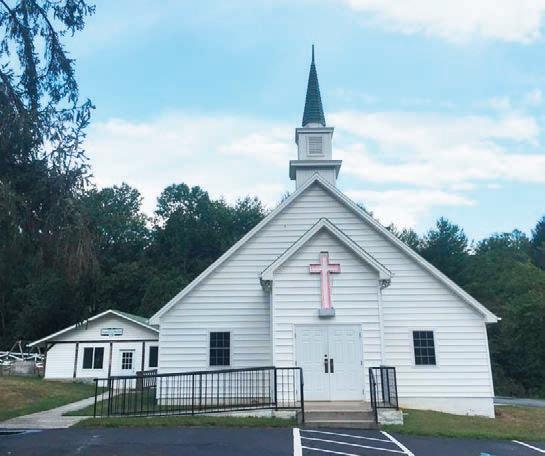
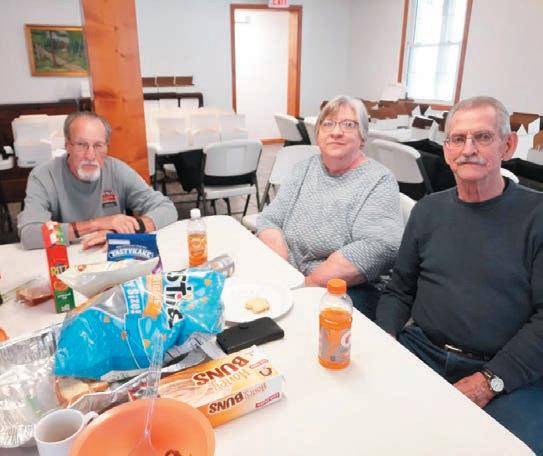 Mount Zion Community and Global Methodist Church.
Pine Grove United Methodist Church.
Mount Zion Community and Global Methodist Church.
Pine Grove United Methodist Church.
February 2024 HIGH COUNTRY MAGAZINE 71
Soup ministry workers (left-to-right) Paul Williams, Sheila Edwards, and Jack Edwards shown in between meal preparation and packaging of the meals.


only operating without any more thoughts of dissolving it, but it began growing beyond our expectations. The Lord truly was using our ministry and has continued to do so in mighty ways.”
Usually about 25 to 35 members – both women and men – from Mount Zion and Pine Grove Churches, along with Reverend Brent Nidiffer, who pastors Pine Grove, and his wife, Juanita, work every Tuesday and Wednesday from the first week in January through the last week in March in Pine Grove Church’s kitchen and fellowship facilities preparing a beef, chicken, vegetable, or other soup, along with bread (often cornbread muffins), dessert, and sometimes another side item. The workers then package those foods, often along with packs of saltine crackers into boxes, which are delivered on Wednesday afternoons to what has grown to currently around 140 to 160 people on several different routes, between a 15-to-20-mile radius of the churches.
Approximately 35 pounds of chicken and hamburger beef and 25 pounds of roast beef are used when each is the featured soup entrée. A few pounds of ham are also included when it is included in the soup. A bushel or more of potatoes, several pounds of other vegetables, and several dozen saltine crackers are used
72 HIGH COUNTRY MAGAZINE February 2024
Pots of soups and various other foods prepared in the Toe Valley Soup Ministry kitchen.
There’s no greater blessing you can get than by helping others –especially those who are experiencing a hard time or hard times in various ways. So, myself and all our kitchen workers and delivery people – some who do both – receive a great blessing by participating in this ministry.
- LINDA OLLIS TAYLOR
each week in the meals’ preparation. The workers often peel the potatoes by hand. The ladies who work the soup kitchen also make several dozen of a home-made dessert each week that is included with the meal. Condiments are boxed with each meal, too.
In past years, a two-acre community garden located on Weatherman Road near Pine Grove Church was created and various vegetables were grown there that were used in the soup kitchen. Various individuals and businesses have also donated food items, paper soup bowls and their lids, boxes, plastic containers, and other related products for the soup kitchen, as well as financial donations to help supply the items and keep the Toe
Valley Soup Ministry in existence.
Whites Memorial, Green Valley and Mount Calvary Baptist Churches, the first located in Ingalls (also in Avery County), and the last two, like Mount Zion, in Kalmia, have also provided assistance in various ways to the Toe Valley Soup Ministry.
It is not only termed a great success, but a most personally rewarding one for those who have worked in it to help so many others, declared Taylor, the current Toe River Soup Ministry Coordinator and Certified Methodist Church Lay Speaker.
She stated: “Our number of recipients were slightly down last year compared to some years past due to a few of those who have been regular yearly clients

passing away or moving to health care or assisted living facilities. But the numbers of recipients often rise each year, and we have given meals to several dozen people for many years, which we are most happy and honored to do.”
“There’s no greater blessing you can get than by helping others – especially those who are experiencing a hard time or hard times in various ways. So, myself and all our kitchen workers and delivery people – some who do both – receive a great blessing by participating in this ministry.”
“We have very dedicated volunteers who spend time on Tuesdays to prepare for that week's meal, such as peeling potatoes, filling cups with condiments such as cheese, sour cream, and onions,
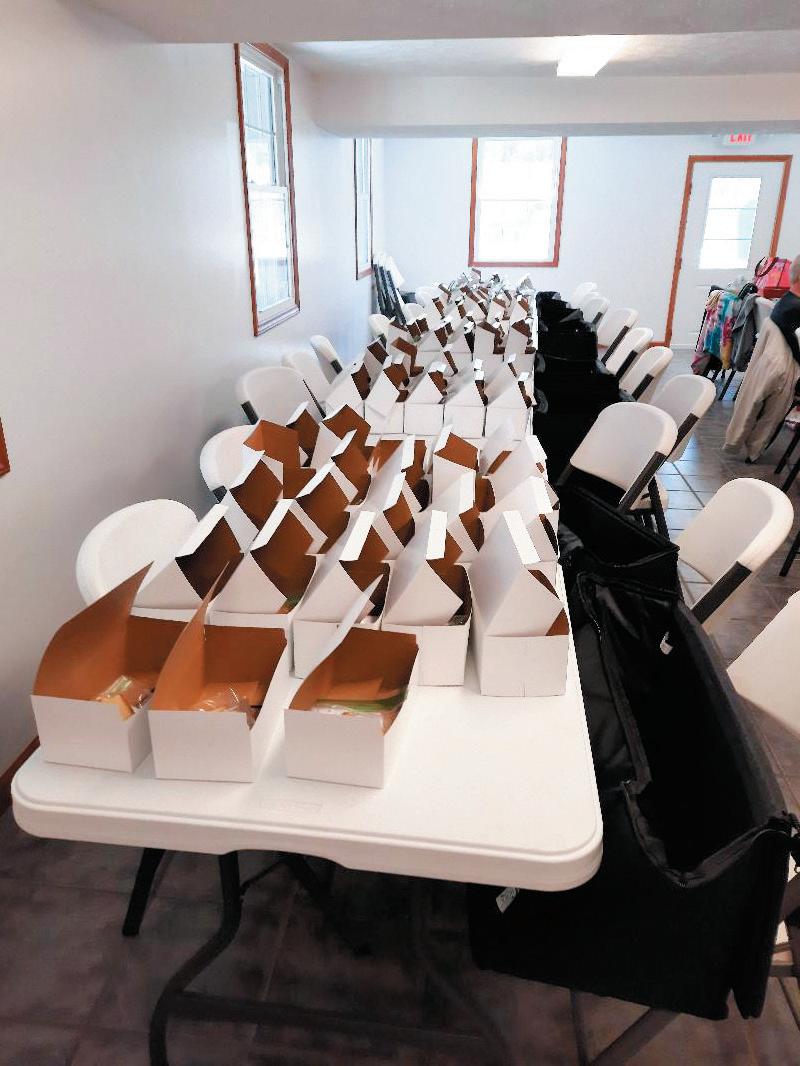 Maggie Aquino (foreground) dipping soup, Martha Phillips (middle) putting lids on soup bowls, and Linda Ollis Taylor (background) packing meals in warmer.
Maggie Aquino (foreground) dipping soup, Martha Phillips (middle) putting lids on soup bowls, and Linda Ollis Taylor (background) packing meals in warmer.
February 2024 HIGH COUNTRY MAGAZINE 73
Take-out boxes waiting to be filled with soup meals for deliveries.



setting up the delivery boxes, and much more. Then, the actual cooking, packaging the meals for delivery, making the deliveries, and cleaning up the kitchen and fellowship hall afterwards takes place on Wednesdays.”
Taylor also shared in detail about one of the top satisfactions the Toe Valley Soup Ministry staff has received, which ironically, includes helping a group of individuals besides its meal recipients, providing further proof of its tremendous benefit of existence.
“Four years ago, we began working with Project Challenge. For those not familiar with Project Challenge, it is a group of youthful offenders, who have not been in serious trouble, but are just troubled so-to-speak and were just sentenced to community service time,” she noted. “A Project Challenge counselor approached Pine Grove Church about letting its offenders serve some of that service time by doing jobs around the church, such as cleaning old flowers off graves, cleaning grave markers, and any other related tasks needed done. The counselor wanted them to learn there was a better way of life than by being legal offenders. Some of our Pine Grove Church officials and members talked to the counselor about the Toe Valley Soup Ministry and asked about having the youthful offenders to help deliver meals for us. The counselor agreed that would be productive and rewarding for them and those youthful offenders currently have our largest delivery route.”
“The people they deliver to loves them, and this youth group love those to whom they deliver meals. I have heard some of the offenders talk about those they have delivered meals to. Last year, one of the offenders came back from delivering and told me that he felt bad that he couldn't stay and eat with one of the ladies he had taken a meal to because she is almost totally blind. The
Todd Bush Photography







bushphoto.com 828-898-8088 banner elk nc Serving the High Country with Premier Scenic, and Commercial Imagery for over 25yrs Scenic photos available at Banner Elk Artists Gallery in the historic BE elementary school near the heart of town
74 HIGH COUNTRY MAGAZINE February 2024
Maggie Aquino (left) and Brenda Williams working in the Pine Grove Methodist Church Fellowship Hall kitchen cooking soup.
counselor then soon asked if it would be acceptable to those of us operating the soup ministry if the youthful offenders delivering the meals could eat with the same lady the next week. Of course, we said ‘yes,’ and they did eat with her then. The elderly folks love it when a young person takes time to talk to them and especially to eat with them when they deliver our meals. Working with this youth group has been one of the best decisions our soup ministry staff has made.”
McKinney added some additional remarks about the Toe Valley Soup Ministry: “God called our little church congregation at then-Mount Zion Methodist Church to step out in faith and plant a seed that Pine Grove Methodist Church would help cultivate, yielding a crop pressed down, full measure and running over. Being obedient to a Godly calling has blessed many people in our small community and others in nearby communities through our churches and the love of our Lord, with a simple bowl of soup.”
“When I think of our soup ministry, I’m reminded of the Biblical scripture of Luke Chapter 6, Verse 38, which reads, ‘Give and it shall be given unto you; good measure, pressed down, and shaken together, and running over, shall be give into your bosom.’ That aptly sums up our ministry.”

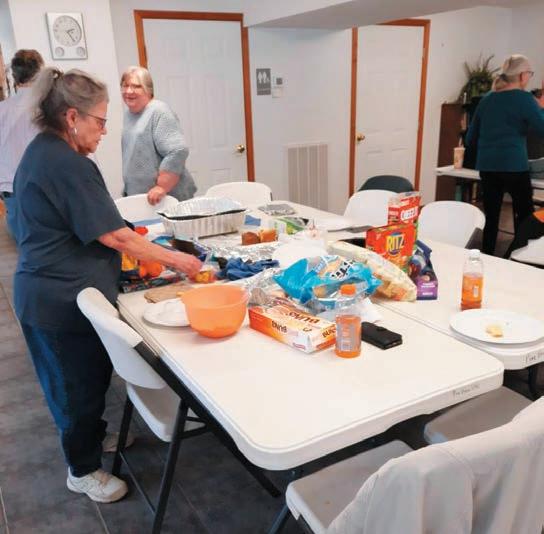
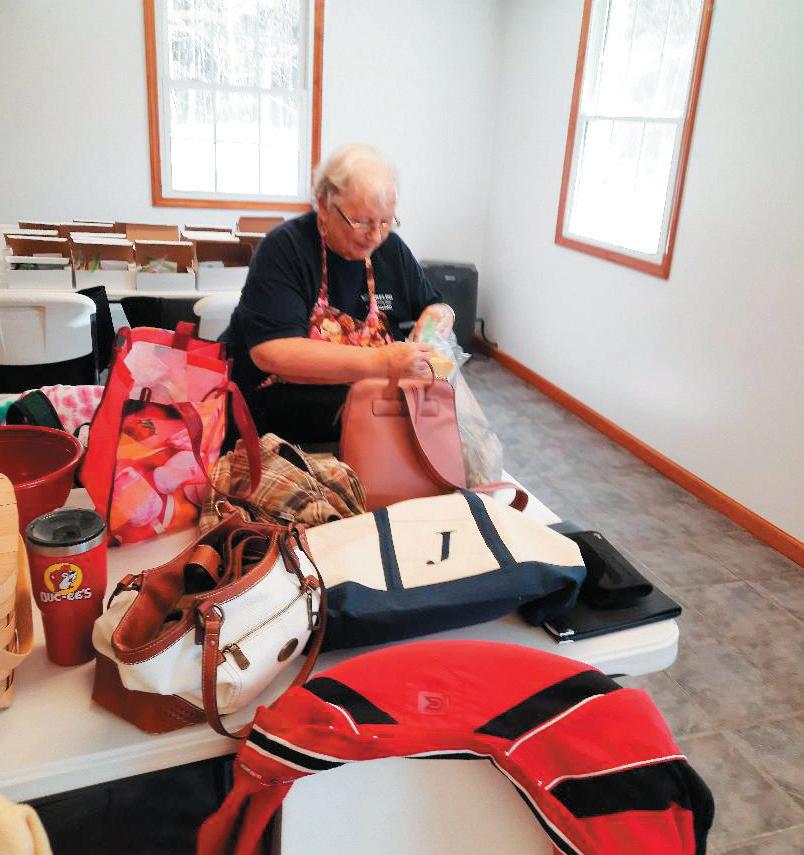
God called our little church congregation at then-Mount Zion Methodist Church to step out in faith and plant a seed that Pine Grove Methodist Church would help cultivate, yielding a crop pressed down, full measure and running over. Being obedient to a Godly calling has blessed many people in our small community and others in nearby communities through our churches and the love of our Lord, with a simple bowl of soup.
- NINA WHITE MCKINNEY
Soup cook Pat Pittman and soup meal deliverer Paul Williams. Anita Polizzi helps set up the Pine Grove Methodist Church Fellowship Hall with supplies for packaging the soup meals to be delivered after she helped cook them.
February 2024 HIGH COUNTRY MAGAZINE 75
Judy Dillingham (front) and Sheila Edwards start to help clean up the fellowship hall after another week’s preparation of soup meals.
Reverend Nidiffer said he has many great feelings about this not only needed, but amazing cause, which he provided in detail.
“As pastor of Pine Grove Methodist Church, it has been an inspiration to see the volunteers of our congregations at Pine Grove and Mount Zion, which is pastored by Reverend David Green, working to meet this need of our community with the simple, yet strategic, effort to provide a weekly meal to those around our community,” he said. “These congregations’ provision of a weekly meal program for the food insecure embodies the essence of compassion and communal support. Beyond sustenance, it fosters unity and solidarity within the community. It reflects the core tenets of empathy and kindness espoused by Christ’s teachings, extending a helping hand to those in need. Such initiatives transcend mere nourishment; they cultivate a sense of belonging, eradicating isolation, and fostering dignity for recipients. By addressing hunger, the congregations cultivate a culture of care, instilling hope and reinforcing the belief that no one should endure hunger alone. Ultimately, it exemplifies the power of collective goodwill and humanitarian service.”
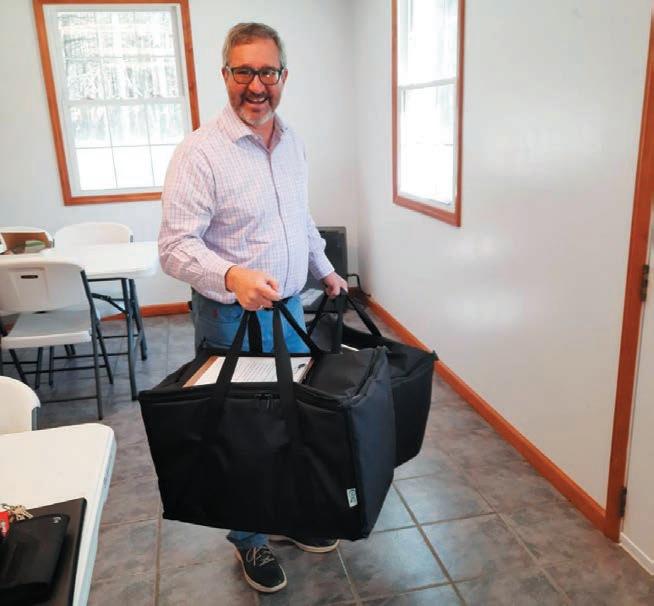
Witnessing the members of our congregation's unwavering dedication to providing weekly meals to the community fills me with immense pride. Their selfless commitment embodies the essence of our faith – love, kindness, and service. Their tireless efforts transcend mere generosity; they symbolize our shared mission to uplift those in need, fostering a compassionate and inclusive community.
- REVEREND BRENT NIDIFFER
“Witnessing the members of our congregation's unwavering dedication to providing weekly meals to the community fills me with immense pride. Their selfless commitment embodies the essence of our faith – love, kindness, and service. Their tireless efforts transcend mere generosity; they symbolize our shared mission to uplift those in need, fostering a compassionate and inclusive community. The initiative's impact extends far beyond mere sustenance; it nurtures bonds, cultivates empathy, and restores hope. It exemplifies our collective strength in embodying the teachings of compassion and solidarity. I am profoundly grateful for their dedication, which exemplifies the transformative power of unified, altruistic action.”
And as Taylor explained in conclusion, the Toe Valley Soup Ministry depends entirely on monetary grants and other financial, food and related products, donations, as well as volunteers, to remain in existence.
“Of course, it takes money, food, condiments, packaging boxes, and volunteers to cook, deliver
 Pastor Brent Nidiffer heading out of the Pine Grove Methodist Church Fellowship Hall with duffel bags filled with soup meals to deliver.
Pastor Brent Nidiffer heading out of the Pine Grove Methodist Church Fellowship Hall with duffel bags filled with soup meals to deliver.
76 HIGH COUNTRY MAGAZINE February 2024
(Left-to-Right) Pine Grove and Mount Zion Methodist Churches Pastor Brent Nidiffer, Paul Williams, Winston Hefner, and Jack Edwards work with the Toe Valley Soup Ministry in any capacities needed.
the meals, and do anything else needed to keep our ministry going,” she said. “Many people and organizations have been so generous to help us financially and by giving of their time to help us in various capacities. And for all that, our soup ministry workers are eternally grateful.
“Donations of any kind to the Toe Valley Soup Ministry are welcomed and again, deeply appreciated. All financial contributions are tax-deductible. And we can always use more volunteers to work in our kitchen and/or deliver meals. All who have, or still work with this ministry, are most happy that God has used us in this spiritual calling. And all still active in it are excited about carrying on this most worthy and very needed cause.”
For further information about the Toe Valley Soup Ministry, to donate to it, and/or to volunteer to help with it, call Linda Ollis Taylor at (828) 387-6708. t


February 2024 HIGH COUNTRY MAGAZINE 77
Linda Ollis Taylor (left) and Vicki Taylor ready to deliver soup meals.

High Country Magazine is distributed year-round in Ashe, Avery, and Watauga counties at no cost to readers. This is possible because of the investment made by our advertisers. We are thankful to them and hope you will support their businesses and organizations.

ADVERTISERS INDEX ADVERTISER PAGE ADVERTISER PAGE Abode ................................... 21 Alchemy ....... .............. 48 AMOREM ........................... 42 Appalachia Cleaning Co. .............. 39 The Appalachian Theatre ................. 09 Banner Elk Realty ........................ 30 The Bee and the Boxwood ... Inside Back Cover Blue Ridge Realty ................Back Cover Boone Bagelry ........................... 58 Boonerang Music & Arts Festival ....... 33 Booneshine ............................. 21 Chetola Resort ........................... 03 Coaches' Invitational ...................... 13 Consignment Cottage Warehouse ........ 30 Dewolfson Down ...................... 02 Dianne Davant & Associates.. Inside Front Cover Dino’s Den Moving ................. 64 Doc’s Rocks .............................. 58 Doe Ridge Pottery ....................... 50 Emergency Restoration Xperts .......... 78 Grandfather Vineyard ................. 05 Graystone Eye ....................... 65 Green Park Inn .................. 29, 38, 48, 67 Hartley Hauling ...................... 43 High Country Magazine Subscription .. 32, 77 High Country Sporting Clay Championship .69 Jeff’s Plumbing ........................72 Magic Bound Travel ...................... 66 McCoy’s Minerals Inc. .................... 58 Mountain Tile .......... .............. 11 New River Building Supply ............. 04 Precision Printing & Signs ............ 64 Stonewall’s Restaurant ................ 07 Sugar Mountain TDA ................ 01 Todd Bush Photography .............. 74 Village Jewelers ....... .............. 25 Windwood Home Furniture ............. 15
February 2024 HIGH COUNTRY MAGAZINE 79
Region’s Oldest Known Resident, Joda Ollis, Dies at the Age of 108
STORY BY SHERRIE NORRIS
The area’s oldest known resident and native of Avery County, Joda Ollis, passed away on Tuesday, Dec. 19, at the age of 108. According to her family, she was actually 108 years, 8 months, and 8 days of age when she took her final breath, leaving a legacy that will long be remembered.
Just three days prior to her death, Joda has been her usual jovial self, visiting with family and friends at the Waters of Roan Highlands in Roan Mountain, Tenn., where she had resided for the past several years.
She apparently suffered a stroke in her sleep in the wee hours of Saturday morning and never regained consciousness; she passed away on Tuesday, with loving family members at her side.
Funeral services were held Thursday, December 21 for Mrs. Ollis at First Baptist Church of Crossnore. Family visitation, held two hours prior, saw people of all ages coming through the line to console her family and to share comments and memories about the impact she had on their lives. Former neighbors and friends in the communities where she had previously resided, as well as nursing home staff and volunteers, had many stories to share with her only surviving sibling and her youngest brother, TJ Greene, and his family. Staff members even participated in the service, one singing Mrs. Ollis’s favorite song, and a video was shared of young children singing a song at the facility that Mrs. Ollis had written a short time prior.
On her birthday earlier this year, High Country Press had the unique opportunity to visit with “Jodie” as she was lovingly known by many closest to her. (The story from that interview may be read at https://www.hcpress.com/avery/joda-ollis-at108-blessed-beyond-anything-i-could-ever-imagine.html.)
According to her obituary, provided by Reins-Sturdivant Funeral Home:
Joda Ollis was a blessing to so many people during her long life, including writer, Sherrie Norris. Photo submitted.
Joda Ethel Green Ollis was born on April 10, 1915, the daughter of Thomas Jefferson Greene and Margaret McCoury Greene, and grew up on Powdermill Creek in Avery County, NC. Joda was a 1933 graduate of Cranberry High School. She married Stokes Ollis of Cranberry on July 11, 1936. They lived in many different areas in North Carolina, Tennessee, and Virginia while Stokes worked building roads with the A.B. Burton Construction Company. Joda was a devoted wife and wonderful homemaker no matter where they lived. Joda and Stokes eventually settled in Elizabethton, TN, and were married for 51 years before he passed in 1987. Joda was previously a member of Big Springs Baptist Church in Elizabethton, TN before moving to Crossnore, NC, where she was a member of First Baptist Church Crossnore.
At the age of 94, Joda became a resident at the Waters of Roan Highlands nursing facility and spent 14 years there. She was blessed to receive many visitors and make new friends during those years. Even though she had lost her eyesight, she

continued to be an independent and beautiful lady. She spent her time listening to her audio bible, writing poems and songs, playing bingo, serving as President of the Residents Council, participating in the Red Hat club, attending weekly preaching and bible study, and many other activities. She enjoyed an active life in her later years and amazed everyone with her talents.
Joda was preceded in death by her parents, her husband, brother Edd Greene (Ruby), brother Ray Greene (Jane), nephew Joe Greene, and nephew Tom (Jeannie) Greene. She is survived by her brother TJ Greene (Pat) of Crossnore; nieces Linda Hoilman (Waightstill), Jolene Biggerstaff, Lila Buchanan (Lawson Callahan), Donna Ballard (Terry), Carol Patterson (Bill), Beverly Baird (Ben); nephews Boyce Greene (Diana), and Brian Greene (Marie). Joda leaves behind a multitude of cousins, great nieces and nephews, and great-great nieces and nephews, as well as many special friends from near and far. Although Joda never had any children of her own, her extended family was her most prized possession, and she made sure that each and every person in her life knew how much she loved them. She was a tireless prayer warrior for them all. Joda often encouraged others to “Trust in the Lord with all thine heart; lean not unto thine own understanding. In all thy ways acknowledge Him, and He shall direct thy paths” (Proverbs 3 : 5 – 6). Her faith in God was unwavering and she lived her life as a testament and witness for Him.
Reins-Sturdivant Funeral Home of Newland was in charge of the arrangements. The family would like to thank everyone at the Waters of Roan Highlands for the years of love and care they have provided to “Aunt Joda.” t
In
Memoriam...
80 HIGH COUNTRY MAGAZINE February 2024
Joda Ollis was a blessing to so many people during her long life, including writer, Sherrie Norris. Photo submitted.




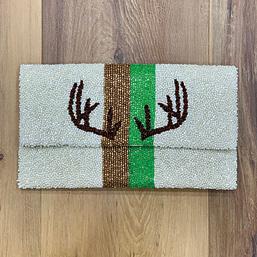










CAROLINA MOUNTAIN LIFE Spring 2022 — 29 CAROLINA MOUNTAIN LIFE Autumn 2021 — 15 215 Boone Heights Dr., Boone • 960 Main Street, Blowing Rock bbandminteriors@gmail.com • www.thebeeandtheboxwood.com • 828.386.6212 HOME • GARDEN • GIFTS Southern Charm in the High Country BesuretovisitBOTHlocations!

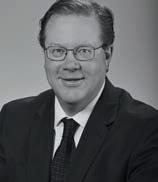


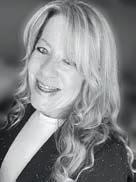
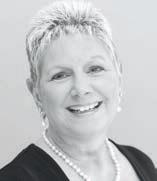











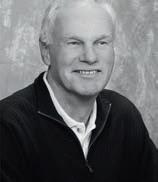
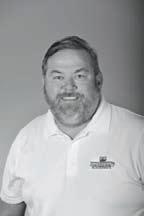



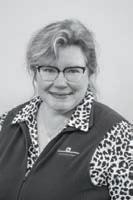

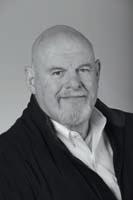

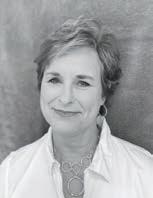
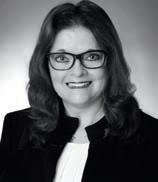



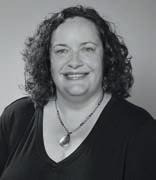
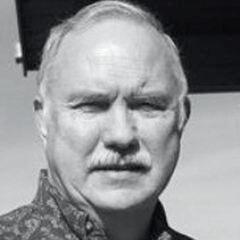







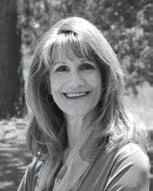



6 Office Locations to serve all your real estate needs! NATIONALLY CONNECTED • REGIONALLY RECOGNIZED • LOCA LLY OWNED & OPERATED Boone 895 Blowing Rock Rd. Boone, NC 28607 (828) 262-4646 Boone 2237 Hwy 105 Boone, NC 28607 (828) 263-8711 Blowing Rock 1129-1 Main St. Blowing Rock, NC 28605 (828) 295-7777 Banner Elk 110 Main St. W Banner Elk, NC 28604 (828) 737-3100 Linville 2155 Linville Falls Hwy Newland, NC 28657 (828) 733-9694 West Jefferson 10 N Jefferson Ave. West Jefferson, NC 28694 (336) 489-3042 www.BlueRidgeRealty.net Our Fully Licensed REALTOR®/Brokers: Top Producing Independent Office Thinking about Buying or Selling? Call the Local Experts! 40+ Years Serving the High Country RESIDENTIAL • LAND COMMERCIAL • DEVELOPMENT SALES • CONSULTING PROPERTY MANAGEMENT
Giarrusso Karen CleghornJohn Heinlein Linda
Lyn Sappington
Cindy
Cramblit
Tracy Simms
Todd RiceBill Aceto
Mary Rupp
Andrew Plyler
Jeanne RobinsonBecky Morgan
Paige Carter
Jay Coble
Hanse KohlerTim Gentry
John Thomas
Brett Baldwin
David CookTuesdae Rice
Amanda Moffatt
Rick Goodwin
John RiceJim Lewis
Jim Perry Hope Harvey
Kaitlin CrawfordBreanna McKay
Stephen Holland
Beverly Clark
PoudelByron
Dascoulias
Natalie FoglePamela Miller
Julie CooneyLisa Stewart
Ram
Proffit Brian Corrion Sandi
Victoria HudsonTom Gidley
OUNTRY
AZ INE
HIGH C
MAG
FEBRUARY 2024









































 Sam Garrett - Publisher
Sam Garrett - Publisher











































 Brianne Harris, farm manager at Apple Hill Farm, cuddles with a Randall Lineback cow — a breed listed as “critical” on The Livestock Conservancy — in the pasture at Apple Hill Farm. Photo by Jan Todd.
A guest snaps a closeup of a llama during a tour at Apple Hill Farm. Photo by Jan Todd.
Brianne Harris, farm manager at Apple Hill Farm, cuddles with a Randall Lineback cow — a breed listed as “critical” on The Livestock Conservancy — in the pasture at Apple Hill Farm. Photo by Jan Todd.
A guest snaps a closeup of a llama during a tour at Apple Hill Farm. Photo by Jan Todd.

 Left: A young guest gets a chance to show some love to the donkeys that protect the alpacas from predators. Photo by Jan Todd.
Left: A young guest gets a chance to show some love to the donkeys that protect the alpacas from predators. Photo by Jan Todd.





























 Janet’s husband, Michael Calhoun, often makes face-jugs such as this much sought after Santa Claus jug. Photo by Layne Hendrickson.
Janet’s husband, Michael Calhoun, often makes face-jugs such as this much sought after Santa Claus jug. Photo by Layne Hendrickson.









 Photos by Josh Floyd.
Photos by Josh Floyd.


 Photo by Josh Floyd.
Photo by Josh Floyd.





 Photos by Josh Floyd.
Photos by Josh Floyd.












 French born Benjamin Marcellin first came to Appalachian Ski Mountain in 1979
the French-Swiss Ski College. Photo by Layne Hendrickson.
French born Benjamin Marcellin first came to Appalachian Ski Mountain in 1979
the French-Swiss Ski College. Photo by Layne Hendrickson.

 Snowboarding has become a very popular pursuit among beginners at the French-Swiss Ski College. Photo by Layne Hendrickson.
Snowboarding has become a very popular pursuit among beginners at the French-Swiss Ski College. Photo by Layne Hendrickson.

 Benjamin began skiing as a two-year-old in the Alps of France and displays his first pair of skis on his office wall.
Benjamin began skiing as a two-year-old in the Alps of France and displays his first pair of skis on his office wall.





 Appalachian Ski Mountain’s Alpine themed lodge was designed in 1962 by architect William P. Reinhardt in a style reminiscent of an old-world Bavarian ski lodge.
Photo by Layne Hendrickson.
Appalachian Ski Mountain’s Alpine themed lodge was designed in 1962 by architect William P. Reinhardt in a style reminiscent of an old-world Bavarian ski lodge.
Photo by Layne Hendrickson.




 A young snowboarder receives expert tutelage at from an instructor of the French-Swiss Ski College.
Photo by Layne Hendrickson.
Benjamin can’t contain his excitement as the first few natural snowflakes of the season begin to fall during our interview. Photo by Layne Hendrickson.
A young snowboarder receives expert tutelage at from an instructor of the French-Swiss Ski College.
Photo by Layne Hendrickson.
Benjamin can’t contain his excitement as the first few natural snowflakes of the season begin to fall during our interview. Photo by Layne Hendrickson.


 Patty Adams, Spirit Ride owner and executive director, has a degree in special education, specializing in teaching learning strategies. She received her Equine-Assisted Health Care certification in 2015 and became a board certified Equine Interaction Professional in Education in 2017. Photo by Jan Todd.
Patty Adams, Spirit Ride owner and executive director, has a degree in special education, specializing in teaching learning strategies. She received her Equine-Assisted Health Care certification in 2015 and became a board certified Equine Interaction Professional in Education in 2017. Photo by Jan Todd.


 Horses are considered the “therapists” at Spirit Ride. “Horses are hard-wired for connection,” said Patty Adams, owner and executive director of Spirit Ride Therapeutic Riding Center. The bond between horse and rider help the children feel safe, loved and accepted. “Therapy starts when the riders connect with the horse,” Patty said. Illustration by Joelle Bornhill
Horses are considered the “therapists” at Spirit Ride. “Horses are hard-wired for connection,” said Patty Adams, owner and executive director of Spirit Ride Therapeutic Riding Center. The bond between horse and rider help the children feel safe, loved and accepted. “Therapy starts when the riders connect with the horse,” Patty said. Illustration by Joelle Bornhill






 A group called “Team Jake” — named for one of the children who rides at Spirit Ride — gather at the 2022 Derby party to support Spirit Ride.
Pictured from left to right are: (front row) Lacey Costner, Crystal Townsend, Summer Parlier; and (back row) Kelsey Watson, Angela Jenkins,
Lina Kate Lewis, Bridgett Clark, and Tasha Turbyfill. Lacey Costner is Jake's mom. Photo by Cindy McEnery Photography
A group called “Team Jake” — named for one of the children who rides at Spirit Ride — gather at the 2022 Derby party to support Spirit Ride.
Pictured from left to right are: (front row) Lacey Costner, Crystal Townsend, Summer Parlier; and (back row) Kelsey Watson, Angela Jenkins,
Lina Kate Lewis, Bridgett Clark, and Tasha Turbyfill. Lacey Costner is Jake's mom. Photo by Cindy McEnery Photography




 Hard work, dedication, and compassion is what Executive Director, Patty Adams, has shown while creating the Spirit Ride Community.
Photo courtesy of Spirit Ride Therapeutic Riding Center.
A sensory trail has been equipped with learning stations and props to engage and train the riders. Luke is encouraged to lift his head to see the multi-colored hanging ball, and with assistance, stretch and touch it as he rides by. Photo by Jan Todd
Hard work, dedication, and compassion is what Executive Director, Patty Adams, has shown while creating the Spirit Ride Community.
Photo courtesy of Spirit Ride Therapeutic Riding Center.
A sensory trail has been equipped with learning stations and props to engage and train the riders. Luke is encouraged to lift his head to see the multi-colored hanging ball, and with assistance, stretch and touch it as he rides by. Photo by Jan Todd


 Top: Patty Adams (left) helps Luke Spond stretch out on the horse’s back prior to his ride. Luke’s mother, Saskia (right), lends a steadying hand while volunteer Missy Thomas looks on. Photo by Jan Todd.
Top: Patty Adams (left) helps Luke Spond stretch out on the horse’s back prior to his ride. Luke’s mother, Saskia (right), lends a steadying hand while volunteer Missy Thomas looks on. Photo by Jan Todd.



 Countless people have stood in lengthy lines through the years where Barney and Tommie Hamtpon are pictured outside of their funeral home in Boone. They and their staff have served an estimated 10,000 families during their 60-plus years in business. Photo by Sherrie Norris.
Hampton Funeral and Cremation Service estimates they have been able to assist about 10,000 families in the nearly 50 years they have been in business.
Photo courtesy of Hampton Funeral and Cremation Service
Countless people have stood in lengthy lines through the years where Barney and Tommie Hamtpon are pictured outside of their funeral home in Boone. They and their staff have served an estimated 10,000 families during their 60-plus years in business. Photo by Sherrie Norris.
Hampton Funeral and Cremation Service estimates they have been able to assist about 10,000 families in the nearly 50 years they have been in business.
Photo courtesy of Hampton Funeral and Cremation Service

 A young Barney Hampton made an important career choice while in high school and has never looked back. Photo submitted.
A young Barney Hampton made an important career choice while in high school and has never looked back. Photo submitted.












 Linda Ollis Taylor displays a pot of Chicken Corn Chowder.
Linda Ollis Taylor displays a pot of Chicken Corn Chowder.


 Mount Zion Community and Global Methodist Church.
Pine Grove United Methodist Church.
Mount Zion Community and Global Methodist Church.
Pine Grove United Methodist Church.



 Maggie Aquino (foreground) dipping soup, Martha Phillips (middle) putting lids on soup bowls, and Linda Ollis Taylor (background) packing meals in warmer.
Maggie Aquino (foreground) dipping soup, Martha Phillips (middle) putting lids on soup bowls, and Linda Ollis Taylor (background) packing meals in warmer.













 Pastor Brent Nidiffer heading out of the Pine Grove Methodist Church Fellowship Hall with duffel bags filled with soup meals to deliver.
Pastor Brent Nidiffer heading out of the Pine Grove Methodist Church Fellowship Hall with duffel bags filled with soup meals to deliver.




























































